
CLIENTS
Transitioning from Jabber to
Webex
Deployment Guide
September 28, 2021
© 2021 Cisco – CTG TME

© 202
1 Cisco – CTG TME Collaboration Transitions – Clients: Transitioning from Jabber to Webex PAGE 2
Contents
Contents
CONTENTS ................................................................................................................................................................................... 2
WHAT’S NEW IN THIS GUIDE ................................................................................................................................................ 4
INTRODUCTION ......................................................................................................................................................................... 5
TARGET AUDIENCE ..............................................................................................................................................................................................5
OVERVIEW .............................................................................................................................................................................................................5
JABBER FULL UC MODE WITH WEBEX MEETINGS.........................................................................................................................................5
JABBER ARCHITECTURE ......................................................................................................................................................................................8
Service Discovery, Authentication and Configuration ................................................................................................................... 9
Subsequent Logins ....................................................................................................................................................................................... 16
Contact Lists ................................................................................................................................................................................................... 17
Directory Integration ................................................................................................................................................................................. 17
CORE COMPONENTS ............................................................................................................................................................... 18
ROLES OF THE COMPONENTS INVOLVED....................................................................................................................................................... 18
WEBEX ARCHITECTURE ................................................................................................................................................................................... 20
Service Discovery Authentication and Configuration.................................................................................................................. 20
Messaging ........................................................................................................................................................................................................ 24
Meetings ........................................................................................................................................................................................................... 24
Calling ............................................................................................................................................................................................................... 24
Subsequent Logins ....................................................................................................................................................................................... 34
Directory Integration ................................................................................................................................................................................. 34
TRANSITION ............................................................................................................................................................................. 37
OVERVIEW OF THIS TRANSITION DEPLOYMENT GUIDE ............................................................................................................................. 37
PRE-TRANSITION STEPS AND CONSIDERATIONS ......................................................................................................................................... 38
1. Setup Webex Control Hub ............................................................................................................................................................ 39
i. Understand Data Residency ........................................................................................................................................................ 39
ii. Verify Domain ................................................................................................................................................................................... 39
iii. Enable UC Analytics ........................................................................................................................................................................ 39
iv. Enable Single Sign-On .................................................................................................................................................................... 42
v. Provision Users ................................................................................................................................................................................ 42
vi. Integrate Calendar .......................................................................................................................................................................... 46
2. Messaging: Understand messaging options ......................................................................................................................... 47
i. Understand Messaging and File Sharing Policy .................................................................................................................. 48
Message Retention ................................................................................................................................................................... 48
Messaging Compliance and Data Loss Prevention ..................................................................................................... 49
ii. Consider External Messaging Policy ........................................................................................................................................ 50
XMPP Federation ...................................................................................................................................................................... 51
SIP Federation ........................................................................................................................................................................... 52
Additional Considerations .................................................................................................................................................... 53
iii. Enable Hybrid Messaging Service............................................................................................................................................. 54
3. Calling: Prepare Unified CM on-premises calling for Webex ....................................................................................... 56
i. Webex Control Hub Calling Settings ........................................................................................................................................ 57
Ensure Phone Number Syncing .......................................................................................................................................... 57
Licensing Assignment ................................................................................................ Error! Bookmark not defined.
UC Manager Profiles ................................................................................................................................................................ 57
Client Calling Settings ............................................................................................................................................................. 58
ii. Validate DNS ...................................................................................................................................................................................... 61
iii. Validate Unified CM and Expressway Settings .................................................................................................................... 61
Users and Authentication ..................................................................................................................................................... 62

© 202
1 Cisco – CTG TME Collaboration Transitions – Clients: Transitioning from Jabber to Webex PAGE 3
Contents
OAuth ............................................................................................................................................................................................. 62
Service Profiles .......................................................................................................................................................................... 63
Jabber-config .............................................................................................................................................................................. 63
Devices .......................................................................................................................................................................................... 64
Device Security Profile ........................................................................................................................................................... 64
Quality of Service (QoS) ......................................................................................................................................................... 64
Push Notifications .................................................................................................................................................................... 65
iv. Contact Center Considerations .................................................................................................................................................. 65
4. Meetings: Understand meeting experience requirements ............................................................................................. 68
TRANSITION STEPS AND CONSIDERATIONS .................................................................................................................................................. 69
1. Review network and firewall requirements. ....................................................................................................................... 69
2. Integrate protocol handlers. ....................................................................................................................................................... 70
3. Configure software updates. ....................................................................................................................................................... 70
4. Deploy Webex app. .......................................................................................................................................................................... 71
5. Contact and preferences migration. ........................................................................................................................................ 72
6. Enable Outlook integration. ........................................................................................................................................................ 74
POST TRANSITION STEPS AND CONSIDERATIONS ....................................................................................................................................... 74
1. Remove Jabber client applications from user devices. .................................................................................................... 75
2. Archive Unified CM IM&P content. ........................................................................................................................................... 75
Jabber contact lists .................................................................................................................................................................. 75
Persistent chat ........................................................................................................................................................................... 76
Managed file transfer .............................................................................................................................................................. 76
3. Decomission Unified CM IM&P server nodes. ...................................................................................................................... 76
REFERENCES ............................................................................................................................................................................. 77
Calling in Webex Unified CM ................................................................................................................................................................... 77
Collaboration Transitions ........................................................................................................................................................................ 77
Compliance and Policy ............................................................................................................................................................................... 77
Directory and Identity ............................................................................................................................................................................... 78
Hybrid Services.............................................................................................................................................................................................. 78
Meetings ........................................................................................................................................................................................................... 79
Messaging ........................................................................................................................................................................................................ 79
Network ............................................................................................................................................................................................................ 79
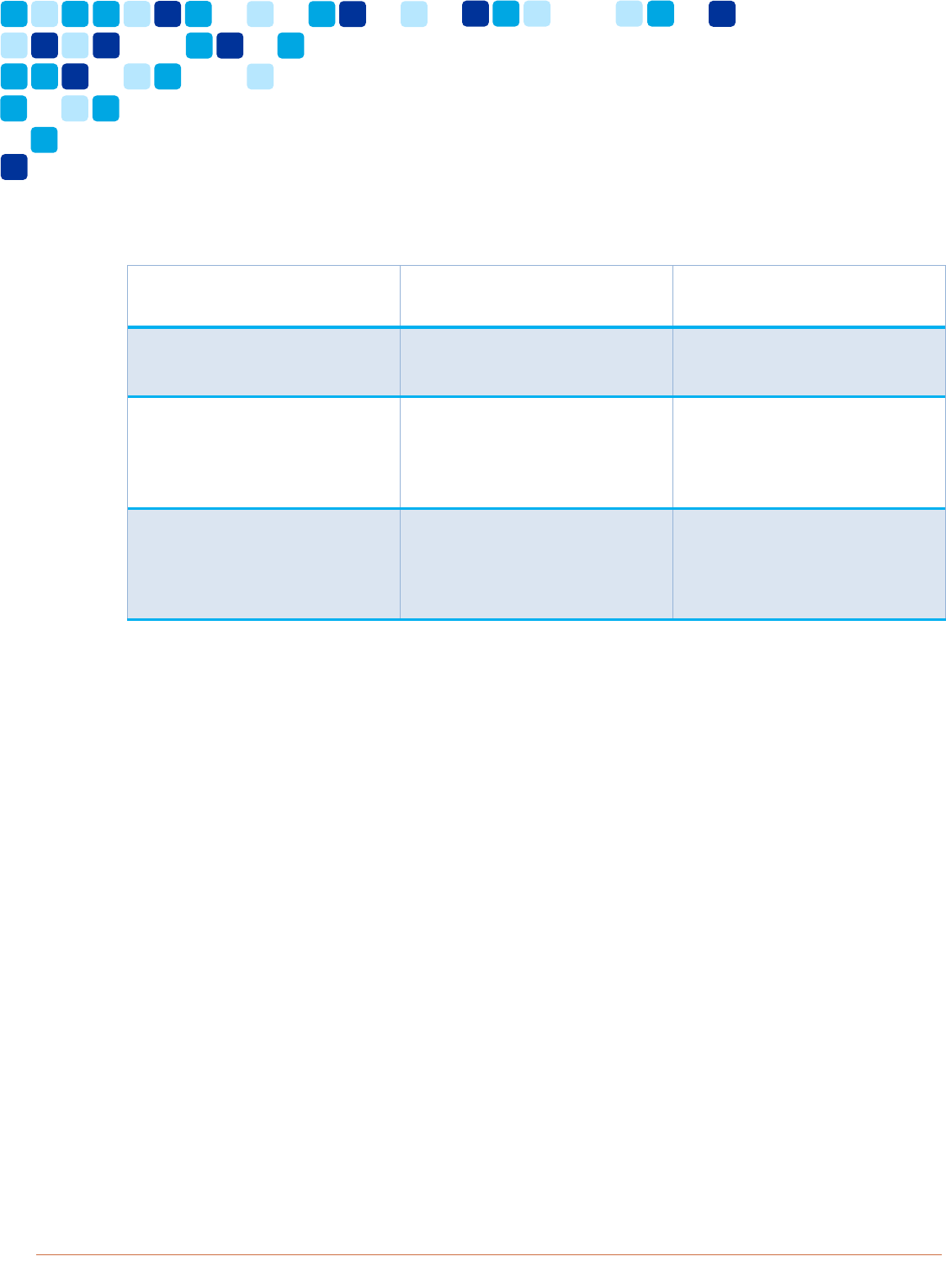
© 202
1 Cisco – CTG TME Collaboration Transitions – Clients: Transitioning from Jabber to Webex PAGE 4
What’s New in This Guide
What’s New in This Guide
Table 1 provide a historical list of updated and new topics added to this guide.
Table 1. Jabber to Webex Transition Deployment Guide Publication History
Date
Updated or New Topics
Update Details and Location
January 13, 2021
Initial document publication
Initial release
January 20, 2021
Topics throughout
document
Added documentation
references to point to new
relevant documents.
September 29, 2021
Topics throughout
document
Product reference name
change from “Cisco Webex”
to “Webex”

© 202
1 Cisco – CTG TME Collaboration Transitions – Clients: Transitioning from Jabber to Webex PAGE 5
Introduction
Introduction
This document will assist in understanding the transition path from Cisco Jabber to
Webex. This will cover general considerations and deployment steps as you evaluate a
transition from a purely on-premises Jabber deployment to a hybrid Webex
environment.
General discussions and detailed steps are included here along with links to other
documentation where necessary.
Target Audience
This deployment guide is intended to be used by teams who are transitioning from
Cisco Jabber to Webex.
With the new Webex, you can call, message, and meet in one inclusive, secure
application. This document will focus on Unified Communications Manager (Unified CM)
calling within the Webex App, simplifying the migration by utilizing the existing call
control used by Jabber today.
Overview
The goal of this document is to assist in the migration from Jabber to Webex.
Jabber provides native support for messaging, calling and meetings, however
deployment of Jabber for messaging and calling, as well as the Webex Meetings App
for meetings, is a very popular deployment model.
The following section details an existing Jabber Full UC deployment with Webex
Meetings architecture.
Jabber Full UC Mode with Webex Meetings
Figure 1 below details the architecture for a Jabber Full UC mode with Webex Meetings
App deployment. The architecture highlights how Jabber and Webex Meetings
applications connect to the services which provide for messaging, calling and meetings
modules. The diagram also details the Expressway mobile and remote access
architecture, which provides access to calling and messaging services from outside the
corporate network boundary.
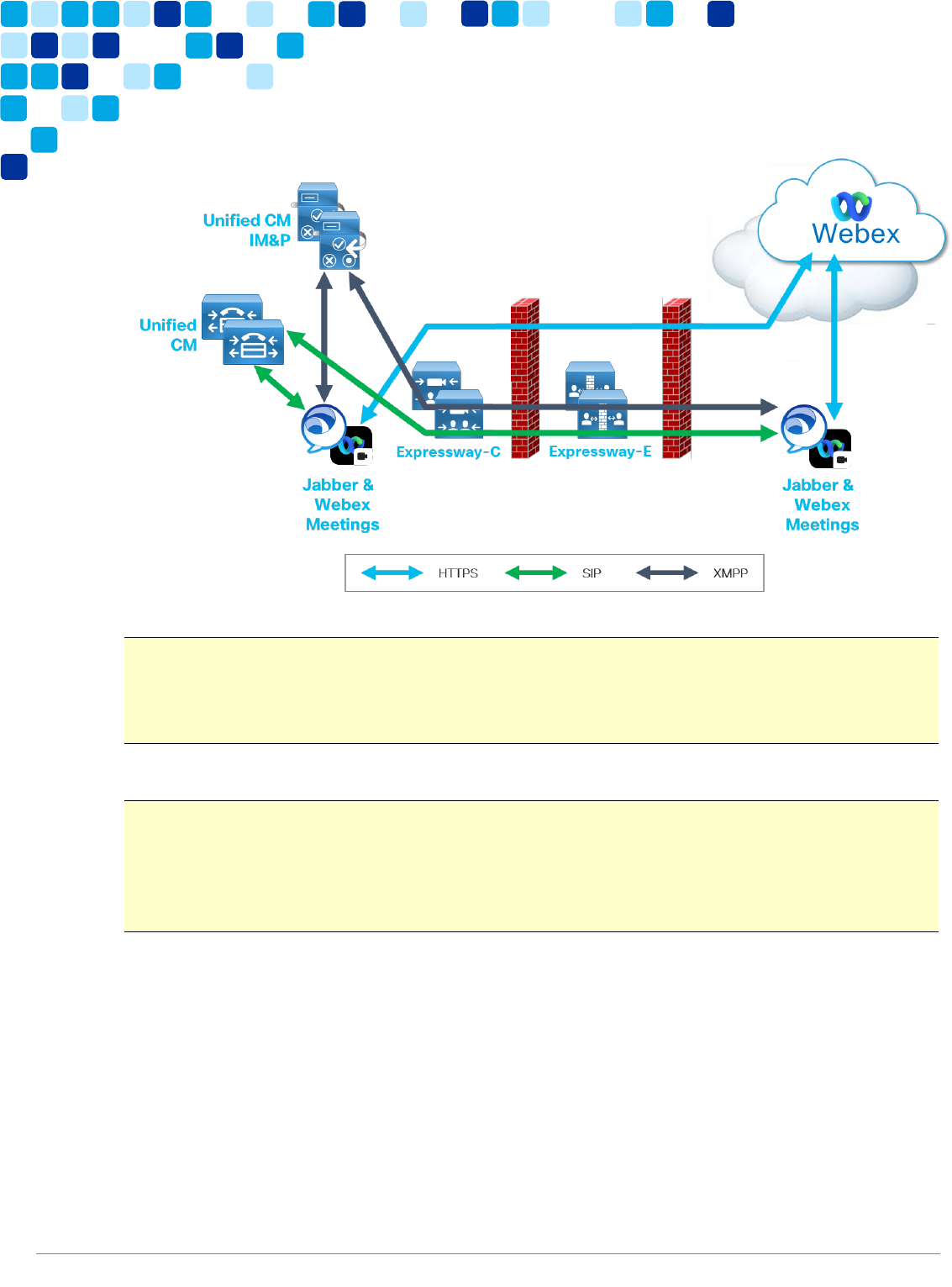
© 202
1 Cisco – CTG TME Collaboration Transitions – Clients: Transitioning from Jabber to Webex PAGE 6
Introduction
Figure 1. Jabber with Webex Meetings Architecture
Note: The architecture depicted in Figure 1 does not cover voicemail services.
Voicemail services delivered via Unity Connection are applicable and will be discussed
later in this document. Likewise, the figure does not include important third-party
components such directory services, identity providers (IdPs), and so on.
Note: Meeting services may also be supported natively with just the Jabber client. That
is Jabber would connect directly to the Webex meetings service instead of having a
separate Webex Meetings application. This deployment method while possible is less
common than what’s shown in Figure 1, but the same transition steps covered later in
the document will also apply to that type of deployment.
Table 2 lists the key elements of the on-premises (or hybrid) Jabber Full UC
deployment architecture prior to transitioning to Webex.

© 202
1 Cisco – CTG TME Collaboration Transitions – Clients: Transitioning from Jabber to Webex PAGE 7
Introduction
Table 2. Before: On-Premises Jabber Deployment Components
Product
Description
Webex
The Webex platform provides the meetings service
to the Webex Meetings App via HTTPS. The Webex
Meetings App can be cross launched from Jabber or
can be run as a standalone application.
Unified CM
Unified CM provides calling service to Jabber via SIP
(softphone mode). Alternatively, Jabber can also
connect to Unified CM in deskphone control mode
(CTI).
Unified CM also provides discovery, configuration,
and directory services for Jabber via the UDS
service (HTTPS)
Unified CM IM & Presence
Unified CM IM & Presence (Unified CM IM&P)
provides messaging and presence service to Jabber
via XMPP. Users contact lists are also stored on
IM&P.
Expressway-C/E
Expressway-C and Expressway-E provide mobile
and remote access (MRA) to Jabber clients running
outside the corporate network boundary, allowing
Jabber to connect to calling and messaging
services.
Cisco Jabber may connect to several services depending on the deployment. Services
include:
Calling – Unified CM
IM and Presence – Unified CM IM&P
Voicemail – Unity Connection
Mobile and remote access (MRA) – Expressway
Meetings – Webex Meetings
Each service has its own interface, but Jabber is primarily managed and configured
from Unified CM.
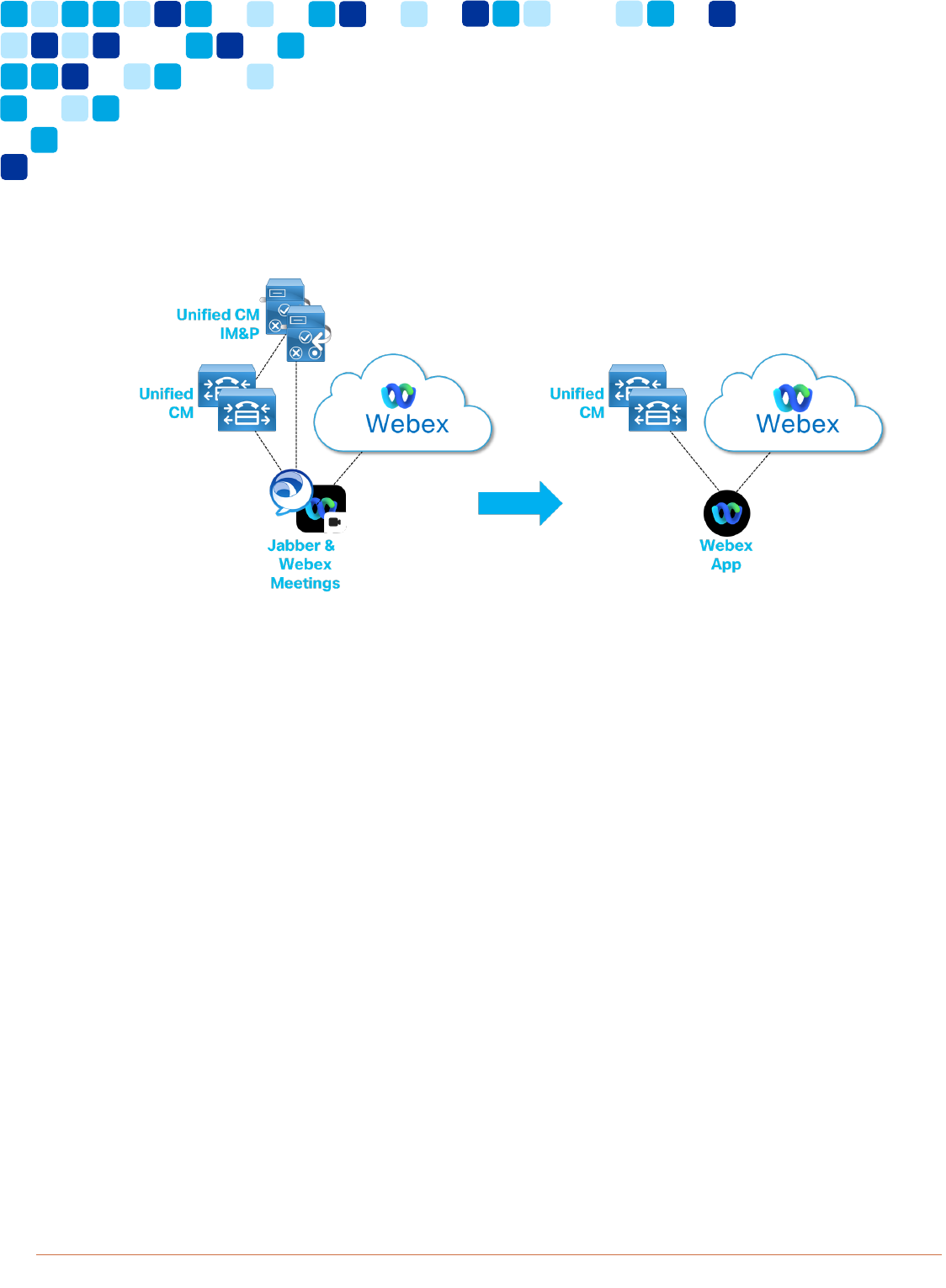
© 202
1 Cisco – CTG TME Collaboration Transitions – Clients: Transitioning from Jabber to Webex PAGE 8
Introduction
As illustrated in Figure 2, customers who have Jabber may choose to transition this
architecture to Webex and cloud-based services, while retaining on-premises Unified
CM for device registration and call routing. The decision to make this transition should
be made based on customer’s functionality requirements.
Figure 2. Transition Decision: Jabber and Webex Meetings to Webex App
Customers that have the following conditions should consider carefully before making
the decision to embark on this transition:
Unreliable Internet access.
Zero chat retention requirement
Very strict compliance requirements including:
o Content storage in country (specific to some countries).
Jabber Architecture
Before discussing the target architecture, it’s important to understand the existing
Jabber deployment. The architecture for Jabber Full UC Mode with Webex Meetings
will be used as an example. For other Jabber deployments, messaging and meetings
services can be ignored as needed.
There are several aspects to understand about the existing Jabber architecture before
migrating to the Webex App.

© 202
1 Cisco – CTG TME Collaboration Transitions – Clients: Transitioning from Jabber to Webex PAGE 9
Introduction
Service Discovery, Authentication, and Configuration
Subsequent Logins
Contact List
Directory Integration
Service Discovery, Authentication and Configuration
When Jabber starts for the first time, it will run through a process called service
discovery. Jabber relies on DNS services to perform service discovery. The purpose of
service discovery is to define:
1. Which service Jabber should connect to (sometimes referred to as edge-
detection)?
2. The location of the service.
Jabber will send two DNS SRV requests based on the domain name that the user
enters on the initial sign in screen, for example, alice@example.com. Jabber expects to
discover one of the following SRV records in DNS:
_cisco-uds._tcp.example.com
_collab-edge._tls.example.com
The _cisco-uds SRV record is deployed on the internal DNS service, and points to one
or more Unified CM nodes. The _collab-edge SRV record is deployed on the external
DNS service, and points to one or more Expressway-E nodes.
If Jabber discovers a _cisco-uds SRV record, Jabber determines that it is located on
the internal network and will connect to Unified CM directly. If Jabber discovers a
_collab-edge SRV record instead of the _cisco-uds SRV record, Jabber determines
that is located outside the internal network boundary, and will need to connect through
Expressway-E, to gain access to internal calling and messaging services.
Figure 3 details how Jabber, located inside the corporate network boundary, discovers
and makes its initial connection to Unified CM. The _cisco-uds SRV record is
configured on the internal DNS service.
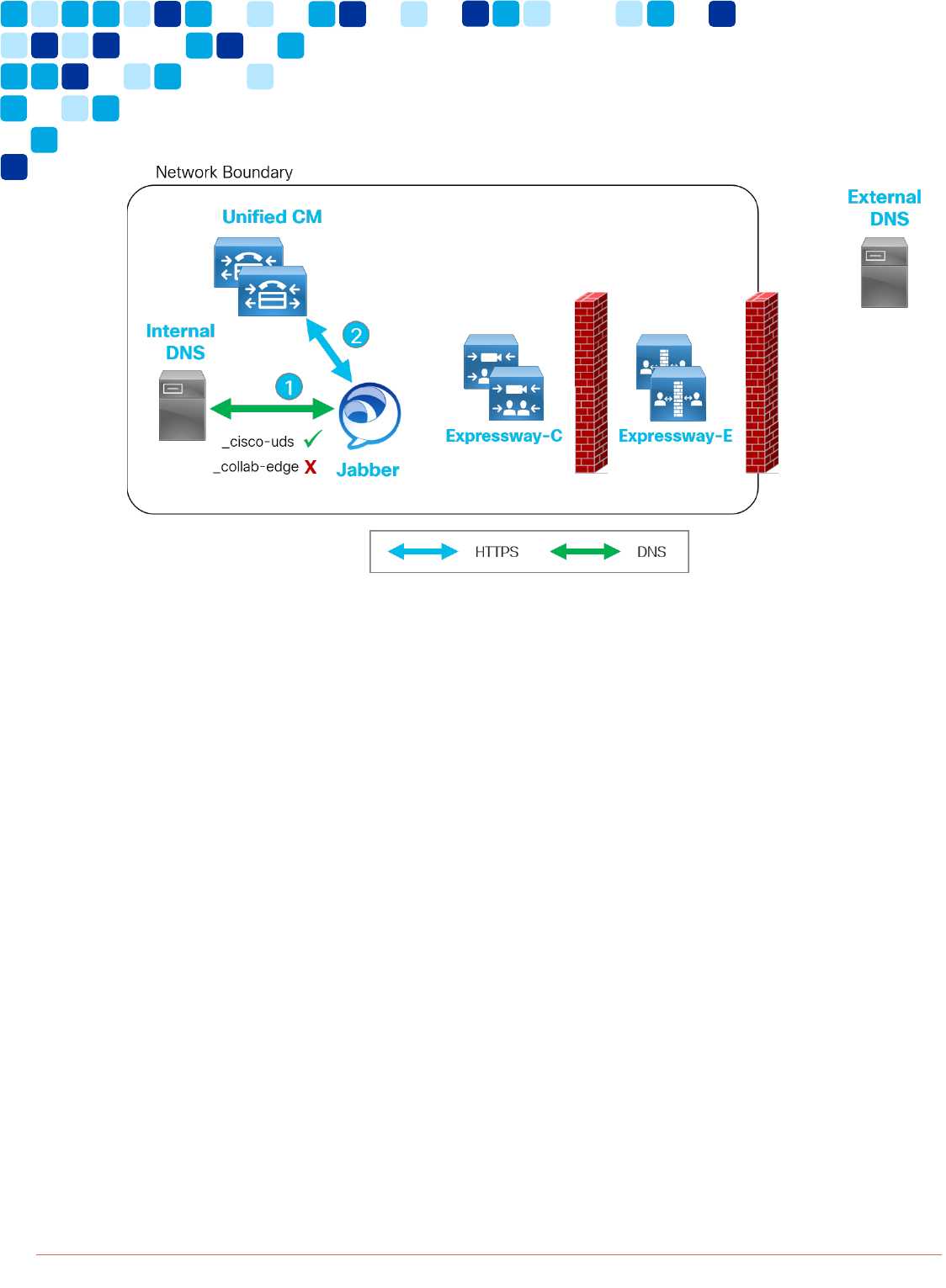
© 202
1 Cisco – CTG TME Collaboration Transitions – Clients: Transitioning from Jabber to Webex PAGE 10
Introduction
Figure 3. On-Premises Jabber Service Discovery
The discovery flow depicted in Figure 3 is as follows:
1. Jabber queries DNS for _cisco-uds and _collab-edge SRV records. DNS returns a
result for _cisco-uds. The result is the DNS A record of a Unified CM node within
the organization.
2. Jabber makes its primary connection to Unified CM via HTTPS. The primary
connection is responsible for determining the software version of Unified CM, as
well as initiating home cluster discovery.
Figure 4 details how Jabber, located outside the corporate network boundary
connecting over Expressway Mobile and Remote Access (MRA), discovers and makes
its initial connection to Expressway-E. The _collab-edge SRV record is deployed on the
external/public DNS service.
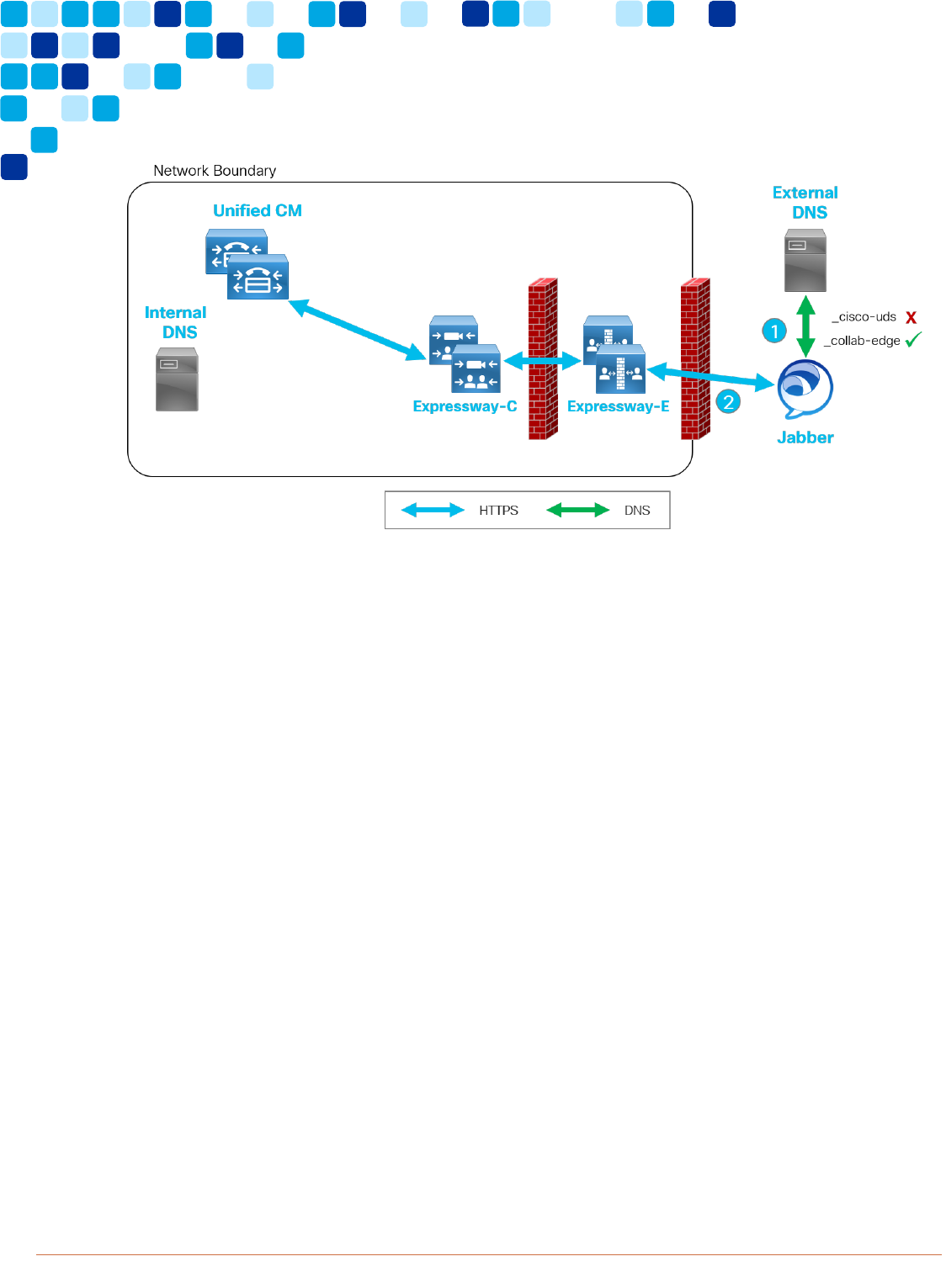
© 202
1 Cisco – CTG TME Collaboration Transitions – Clients: Transitioning from Jabber to Webex PAGE 11
Introduction
Figure 4. Expressway Mobile and Remote Access Jabber Service Discovery
The flow depicted in Figure 4 is as follows:
1. Jabber queries DNS for _cisco-uds and _collab-edge SRV records. The external
DNS service returns a result for _collab-edge. The result is a DNS A record for an
Expressway-E node within the organization.
2. Jabber makes its primary connection to Expressway-E via HTTPS. The primary
connection will typically involve authentication as well as a configuration request.
Expressway-E will then pass the request to Expressway-C, which will initiate
home cluster discovery against Unified CM on behalf of the Jabber client.
Home cluster discovery is the process whereby Jabber makes its primary connection to
any Unified CM node in the organization and then is redirected to the publisher node of
the user’s assigned home cluster. The user’s home cluster is the cluster where the user
will obtain services for configuration download, device registration, deskphone control
mode, search, and so on. A user’s home cluster is defined when the administrator
associates the user with a particular home cluster. Home cluster can be set in bulk (for
example with the BAT tool) or manually on a per user basis at the end user page.
Figure 5 shows the Home Cluster checkbox is checked for a user on this cluster.
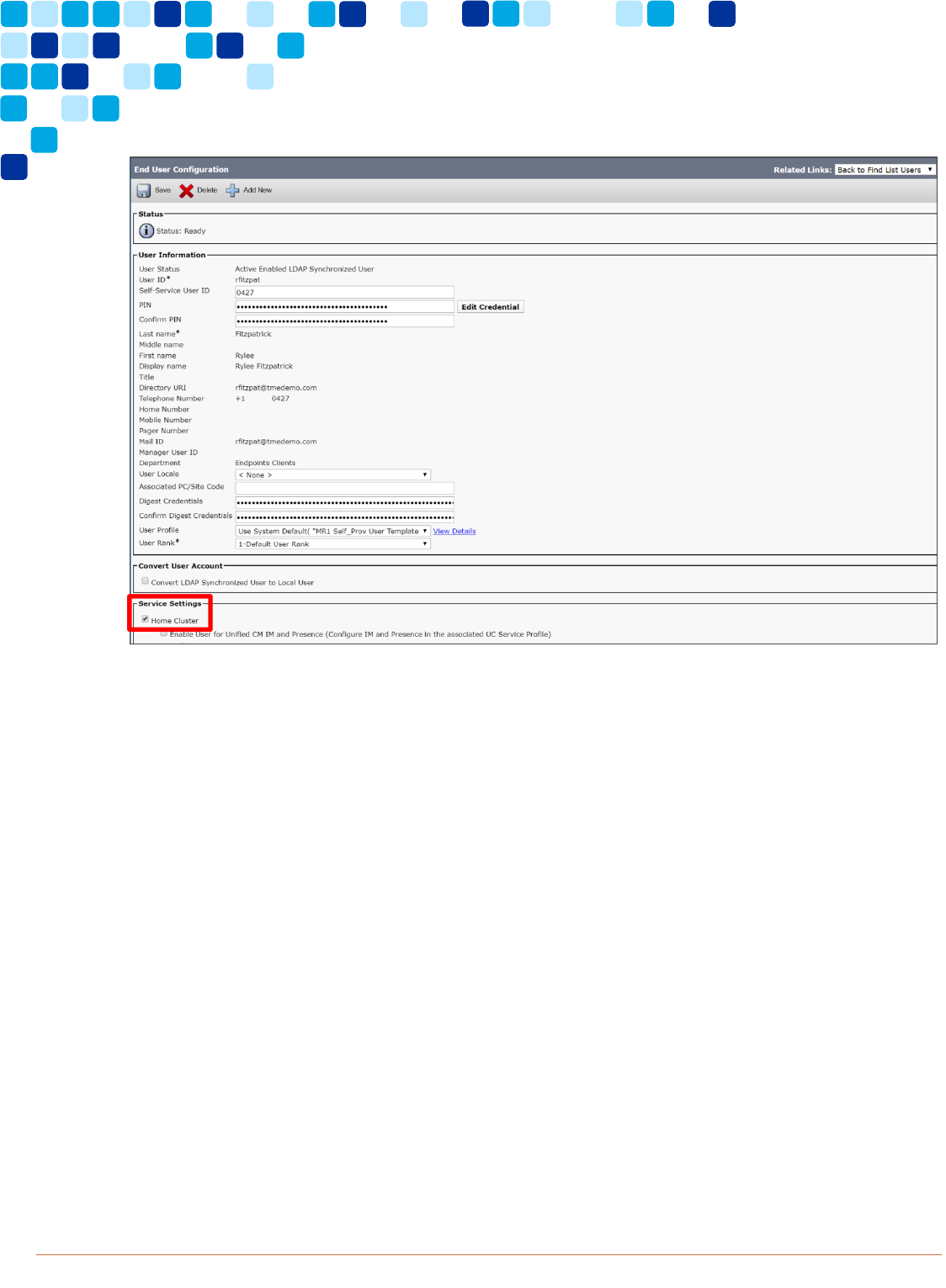
© 202
1 Cisco – CTG TME Collaboration Transitions – Clients: Transitioning from Jabber to Webex PAGE 12
Introduction
Figure 5. Unified CM: End User Home Cluster Setting
Home cluster discovery relies on the Intercluster Lookup Service (ILS). ILS provides
several capabilities including the ability for any Unified CM node within the organization,
to locate the home cluster of a particular user. ILS should be configured between all
Unified CM clusters.
Home cluster discovery as described and shown above also applies to MRA-based
remote connections, whereby Expressway-C performs the home cluster discovery on
behalf of the remote Jabber client.
Home cluster queries sent by Jabber are as follows:
https://UnifiedCM_FQDN:8443/cucm-uds/clusterUser?username=alice
https:// UnifiedCM_FQDN:8443/cucm-uds/clusterUser?email=[email protected]
The Unified CM_FQDN component of the above URLs is determined by the Unified CM
address returned from the DNS SRV query for _cisco-uds.

© 202
1 Cisco – CTG TME Collaboration Transitions – Clients: Transitioning from Jabber to Webex PAGE 13
Introduction
Note: For Jabber connections over MRA, Expressway-C will perform the home cluster
query against the internal DNS server.
The user identifier at the end of the query will be based on what the user types into
Jabber on the primary login screen (where the user types in their username and
domain, often the users email address). Jabber will send two queries: one using
username, and one using email. The reason for the two queries is to cater for
organizations who do not standardize on using username as UID in Unified CM.
Note: With Unified CM 10.5.2 and later, users email addresses are synced from LDAP
directory during LDAP sync.
Note: Jabber on Windows can read the User Principal Name (UPN) from the local
machine and use this to initiate discovery – this will mean that the user will never see
the initial Jabber login screen. UPN discovery can be disabled with the following
installer switch:
msiexec /i CiscoJabberSetup.msi UPN_DISCOVERY_ENABLED=false CLEAR=1 /quiet
Once home cluster discovery is successful, Jabber will connect to the publisher node
of the home cluster and ask for a list of all nodes within the cluster. Jabber will connect
to a randomly selected node from the list returned and request the download of user
configuration. That Unified CM node will then challenge Jabber for authentication.
Unified CM supports three methods of user authentication:
1. SAMLv2 single sign-on (SSO)
2. LDAP authentication
3. Basic username password
SSO is the preferred method of authentication for Jabber and the Webex App. This
document will assume SSO is already enabled for the organization.
When Jabber is challenged for authentication, it is redirected to the identity provider
(IdP). The IdP will challenge Jabber for a specific type of authentication, depending on
how the IdP is configured. Examples of authentication include username/passwords,
Kerberos, certificate authentication, and so on. Jabber will call upon the system
browser (embedded browser) to support the authentication request. Depending on the
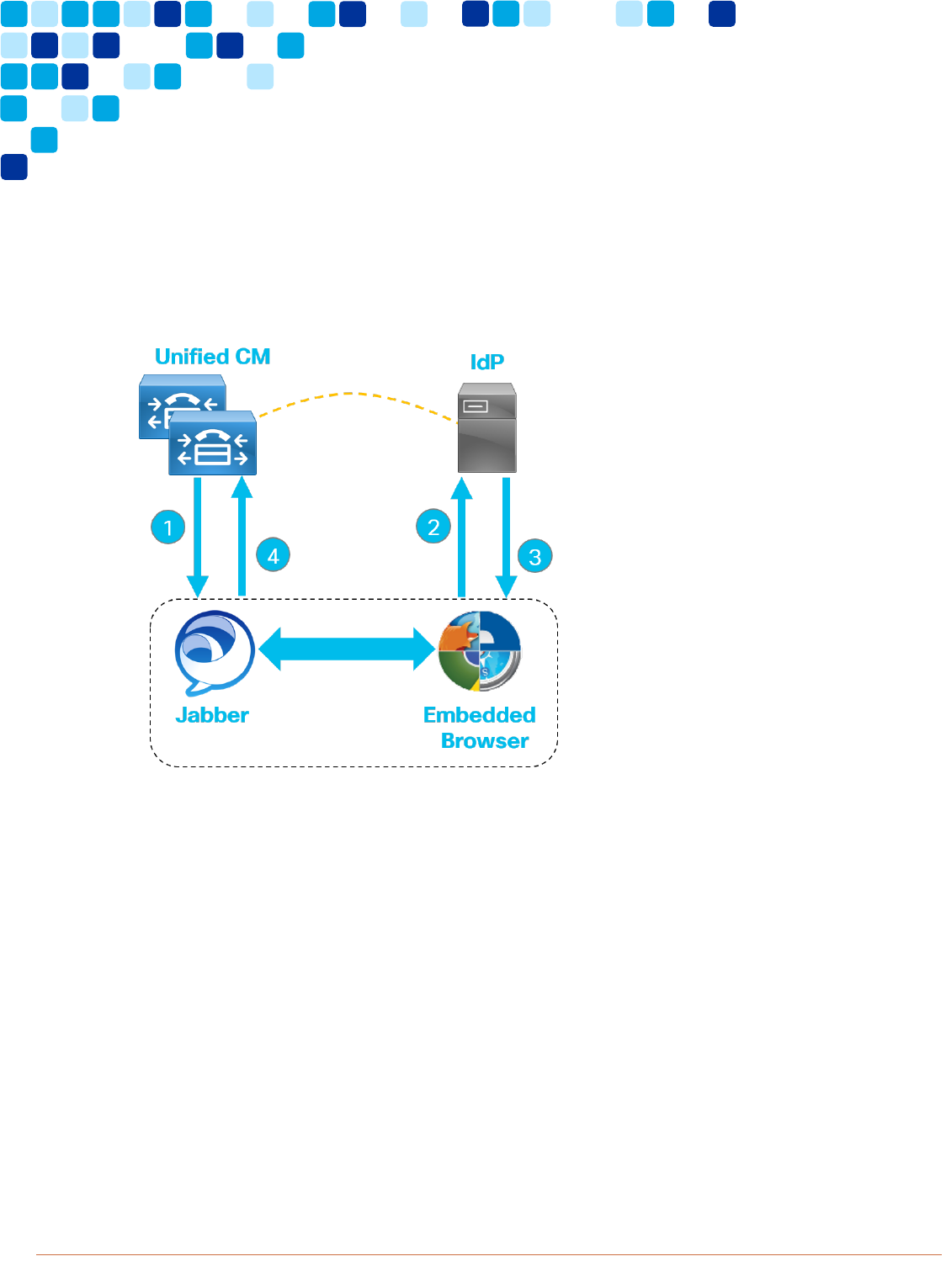
© 202
1 Cisco – CTG TME Collaboration Transitions – Clients: Transitioning from Jabber to Webex PAGE 14
Introduction
authentication type enabled, Jabber may display an embedded browser to prompt the
user to enter a credential. Once the user authenticates, Jabber will receive a SAML
token from the IdP. This SAML token can then be presented to Unified CM, and Jabber
will be granted access to Unified CM services.
A high-level flow of this process is detailed in Figure 6.
Figure 6. Jabber Embedded Browser Flow
The flow depicted in Figure 6 is as follows:
1. Unified CM is SSO enabled and redirects authentication requests to the IdP.
2. Jabber calls to the embedded browser to connect to IdP and authenticate.
User/embedded browser authenticates based on authentication types enabled by
the IdP (for example, username/password, Kerberos, or certificate).
3. IdP issues embedded browser a SAML cookie.
4. Jabber uses the SAML cookie to gain access to Unified CM services.
Once Jabber has authenticated with Unified CM, it will retrieve an OAuth refresh token.
Jabber will use the OAuth refresh token to retrieve an OAuth access token from Unified
CM. The access token will be used to gain access to specific services including UDS,
and other services. This flow assumes that OAuth Refresh Token Flow is enabled on
Unified CM.

© 202
1 Cisco – CTG TME Collaboration Transitions – Clients: Transitioning from Jabber to Webex PAGE 15
Introduction
Jabber will then download user configuration including:
Service profiles
Jabber configuration
End user configuration
Device list
Device configuration
The service profile defined in Unified CM will detail the subsequent services and the
service location (FQDN) that Jabber should connect to if configured. The service profile
may include some or all the following services:
IM and Presence
Voicemail
Conferencing
CTI
Directory
Jabber Client Configuration
Jabber connects to IM and presence (Unified CM IM&P), voicemail (Unity Connection),
and conferencing (Webex Meetings) services if enabled. Jabber uses the existing
SAML token to authenticate against each of these services (assuming each service is
SSO enabled).
Jabber connects to the CTI service if the user selects to run in deskphone control
mode.
Jabber connects to the configured directory service –either an LDAPv3-based directory
service (for example, Active Directory) or the UDS directory service running on Unified
CM.
Jabber automatically downloads the Jabber client configuration in the case of Unified
CM 12.5 and above. This configuration is equivalent to what can be configured in the
automatically downloaded jabber-config.xml file with Unified CM 11.5 and earlier.
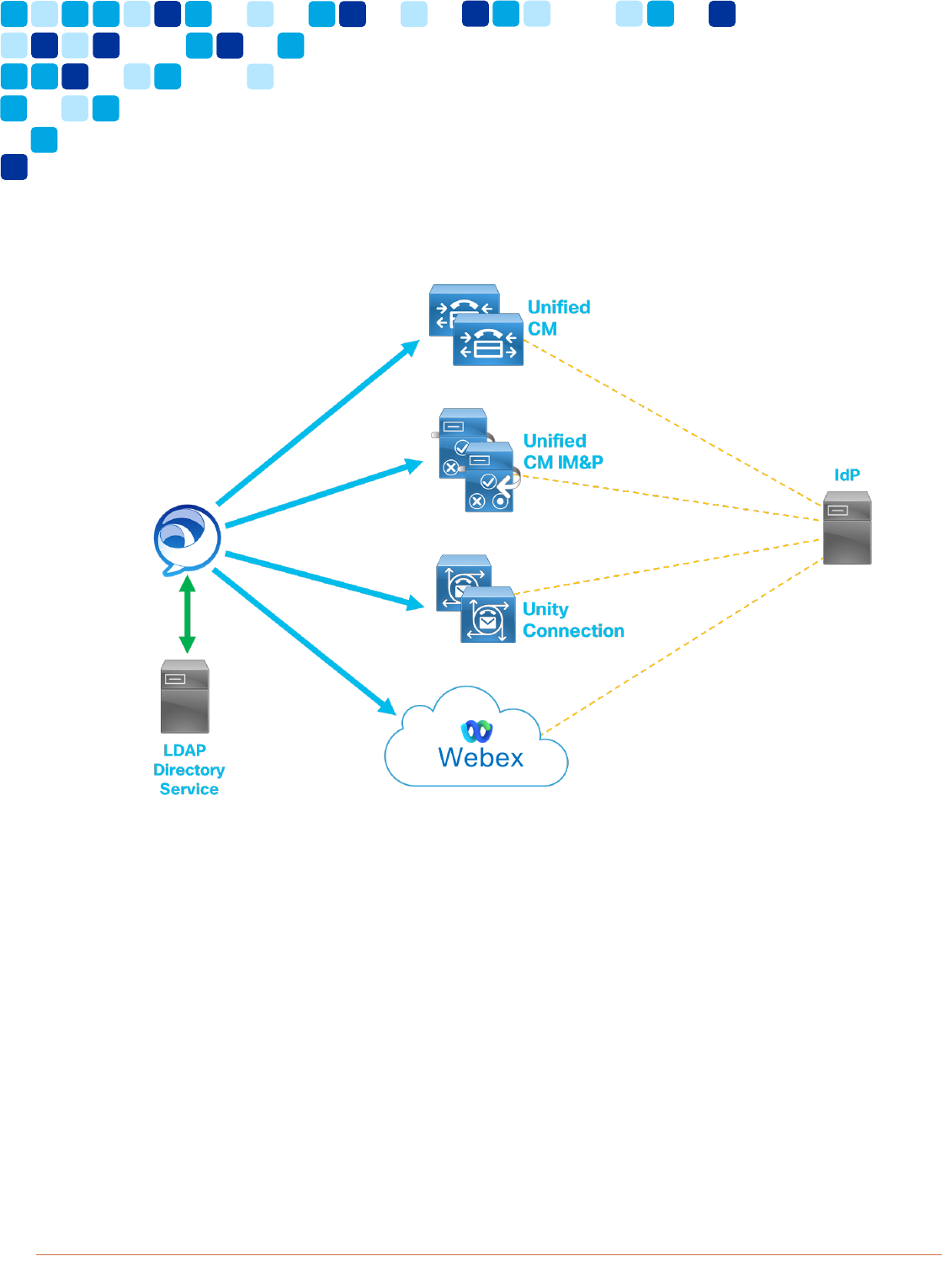
© 202
1 Cisco – CTG TME Collaboration Transitions – Clients: Transitioning from Jabber to Webex PAGE 16
Introduction
Figure 7 details how Jabber would connect to all services if configured. SSO enabling
all services, allows users to authenticate once, and gain access to different services. If
Jabber is running in Phone Only mode for example, the Unified CM IM&P service would
not be configured.
Figure 7. Jabber Services
Subsequent Logins
Jabber will write service details to a cache file that will be stored on the local device.
The service details include the server addresses (for example, the address of Unified
CM and Unified CM IM&P nodes) that Jabber last successfully connected to.
Jabber will also store the OAuth refresh token previously retrieved from Unified CM.
The OAuth refresh token can be used to retrieve a new OAuth access token, without
requiring re-authentication. (This assumes OAuth Refresh Token Flow is enabled on
Unified CM, Unity Connection, and Expressway).
After one successful sign in, Jabber will subsequently discover and sign into services
based on the details in the cache. Jabber will read the cache, connect to services

© 202
1 Cisco – CTG TME Collaboration Transitions – Clients: Transitioning from Jabber to Webex PAGE 17
Introduction
defined in the cache, and use the OAuth refresh token to retrieve an access token to
gain access to those services. This capability is referred to as Fast Login.
In the first few minutes after connecting to services, Jabber will perform configuration
refresh in the background. Jabber will resend DNS SRV queries as well as checking
Unified CM for any configuration changes. If a configuration change is detected, the
user may be prompted to sign out of Jabber to retrieve the new configuration.
Contact Lists
For Full UC Mode or Phone Only Mode with contacts-based deployments, contact lists
are stored on the Unified CM IM&P server. Contact lists will be downloaded at initial
login, and users can add or remove persons from their contact lists. Jabber will
maintain a copy of the contacts list locally in a cache file. This file is stored on disk,
encrypted with tools provided by the local OS (for example, Keychain on Mac). This
contact list can be copied to the Webex App during migration. The details of this are
discussed later in this document.
Directory Integration
Jabber relies heavily on a directory integration for a consistent user experience. Jabber
can integrate directly with an LDAPv3 based directory service (for example, Active
Directory) or the UDS directory service running on Unified CM. Jabber relies on the
directory integration for several functions including:
Contact search
Contact resolution
Incoming caller resolution
Jabber will always connect to the UDS directory service when connecting over
Expressway MRA, while it can connect to LDAP or UDS directory service when
connecting from the corporate network. The user data must be consistent across LDAP
and UDS to allow for consistent user experience.
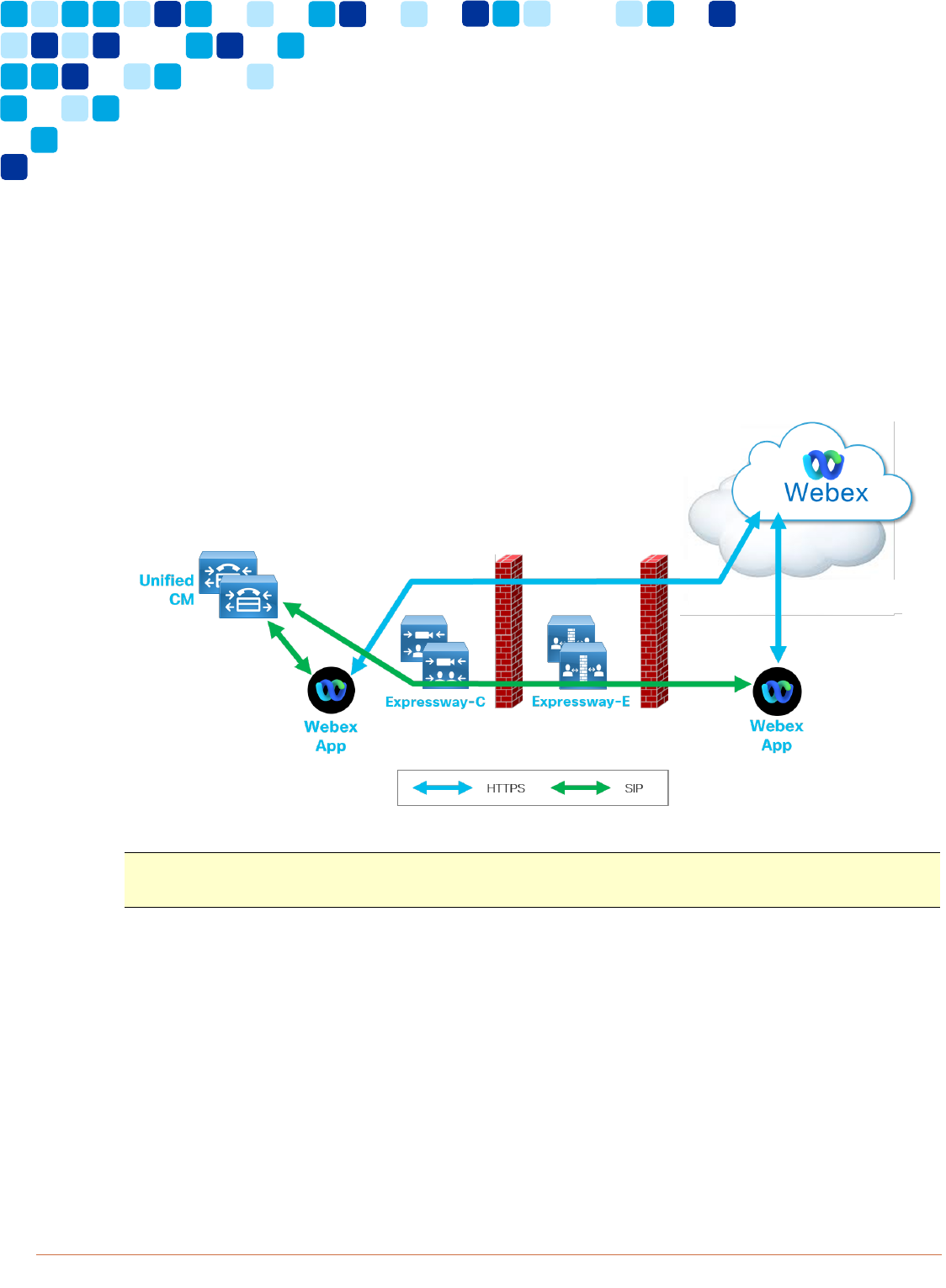
© 202
1 Cisco – CTG TME Collaboration Transitions – Clients: Transitioning from Jabber to Webex PAGE 18
Core Components
Core Components
Roles of the Components Involved
Figure 8 details the target architecture for a Webex App deployment with Unified CM
calling. The architecture highlight’s how the Webex App connects to services which
provide for messaging, calling, and meetings. The diagram also details the Expressway
mobile and remote access architecture, which provides access to Unified CM calling
services from outside the corporate network boundary.
Figure 8. After: Webex App with Unified CM Calling Architecture
Note: Figure 8 does not show important third-party components including directory
services and identity providers (IdPs)
Table 3 lists the new elements of the architecture after transitioning to Webex.

© 202
1 Cisco – CTG TME Collaboration Transitions – Clients: Transitioning from Jabber to Webex PAGE 19
Core Components
Table 3. After: Webex Infrastructure Components
Product
Description
Webex
The Webex platform provides the messaging and
meetings services to the Webex App via HTTPS. The
Webex platform also provides, configuration,
entitlements, and directory services for the Webex
App.
Unified CM
Unified CM provides calling service to the Webex
App via SIP (softphone mode). Alternatively, the
Webex App can also connect to Unified CM in desk
phone control mode (CTI). Unified CM also provides
for service discovery and calling configurations for
the Webex App (HTTPS).
Expressway C and E
Expressway C and E provides mobile and remote
access (MRA) to Webex running outside the
corporate network boundary, allowing the Webex
client to connect to calling services.
The Webex App may connect to several services depending on the deployment. These
include:
Webex platform (including messaging and meetings)
Unified CM
Unity Connection
Expressway (MRA)
The Webex App is primarily managed from Webex Control Hub (Control Hub). Control
Hub is the management interface for Webex. Control Hub provides administrators with
the ability to manage users and configure features and settings for the organization.
Control Hub also provides rich analytics and real-time troubleshooting capabilities.
Note: Webex Meetings can be managed from Webex Site Admin or directly via Control
Hub, depending on the organizations existing deployment. If Webex Meetings service is
managed by Site Admin before migrating to the Webex App, Site Admin can be linked
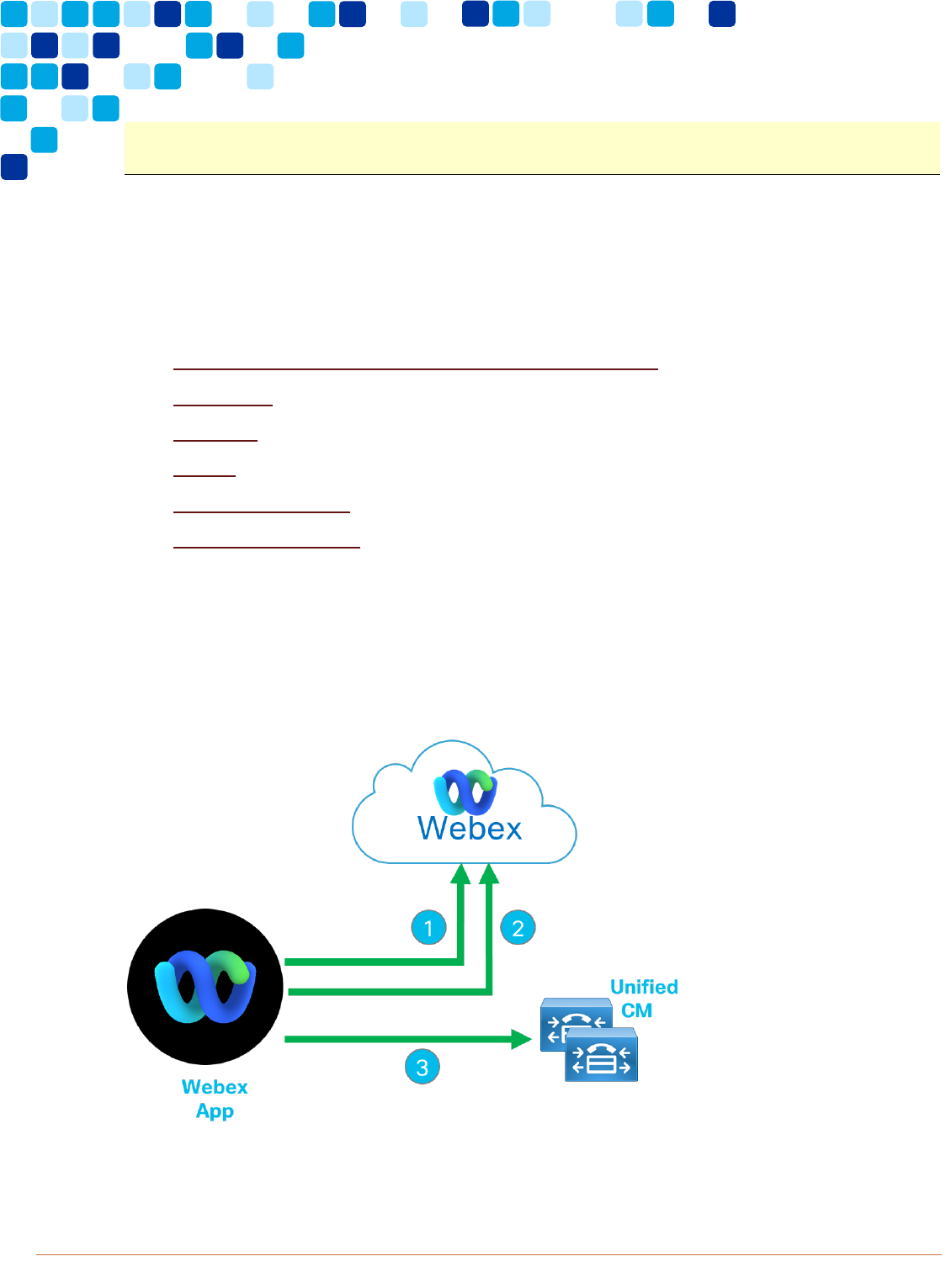
© 202
1 Cisco – CTG TME Collaboration Transitions – Clients: Transitioning from Jabber to Webex PAGE 20
Core Components
with Control Hub to ensure consistency of user provisioning as well as bring the
benefits of Control Hub analytics and troubleshooting capabilities to Webex Meetings.
Webex Architecture
This section details the architecture for the Webex App with Unified CM calling.
Key aspects of this Webex architecture will be discussed including:
Service Discovery, Authentication, and Configuration
Messaging
Meetings
Calling
Subsequent Logins
Directory Integration
Service Discovery Authentication and Configuration
The high-level flow summary for a first-time login to the Webex App is shown in Figure
9.
Figure 9. Webex App High-Level Architecture
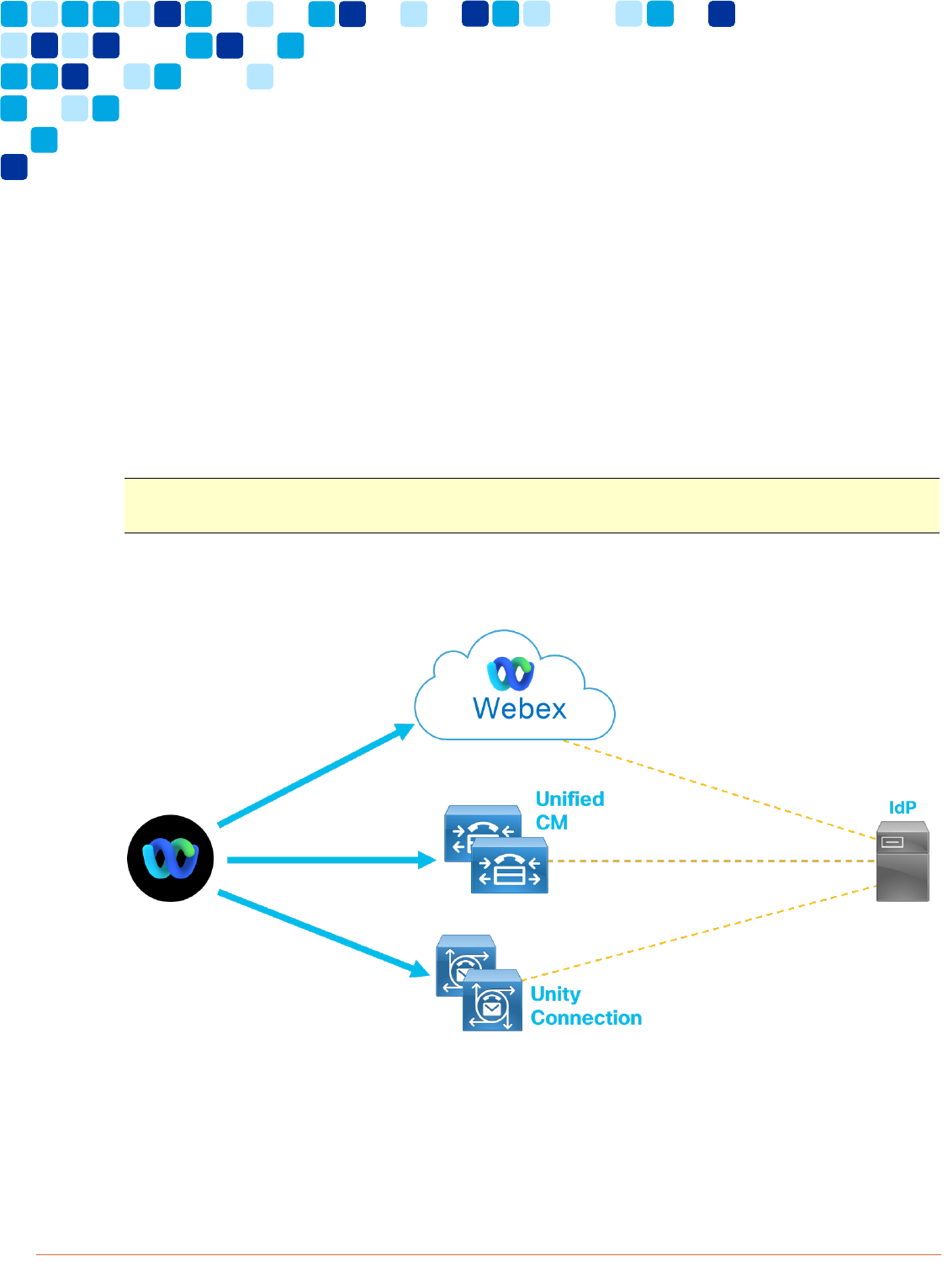
© 202
1 Cisco – CTG TME Collaboration Transitions – Clients: Transitioning from Jabber to Webex PAGE 21
Core Components
The flow depicted in Figure 9 is as follows:
1. User signs into Webex App. User is enabled for Unified CM calling.
2. Webex connects to messaging and meetings services.
3. Webex connects to Unified CM (possibly through Expressway (MRA))
In this section, assume that the following services are SSO enabled:
Webex Site (Control Hub)
Unified CM
Expressway
Unity Connection
Note: For Webex deployments, SSO is not mandatory, but it is highly recommended to
enhance security, and simplify user experience.
Figure 10 shows the Webex App SSO flows.
Figure 10. Webex App SSO
When the Webex App is launched for the first time, the user will be prompted to enter
their email address. Once the user enters the address, the Webex App will connect to
the users Webex Site and the user will be challenged for authentication. Assuming the
Webex Site is SSO enabled, the Webex App is redirected to the IdP for authentication.
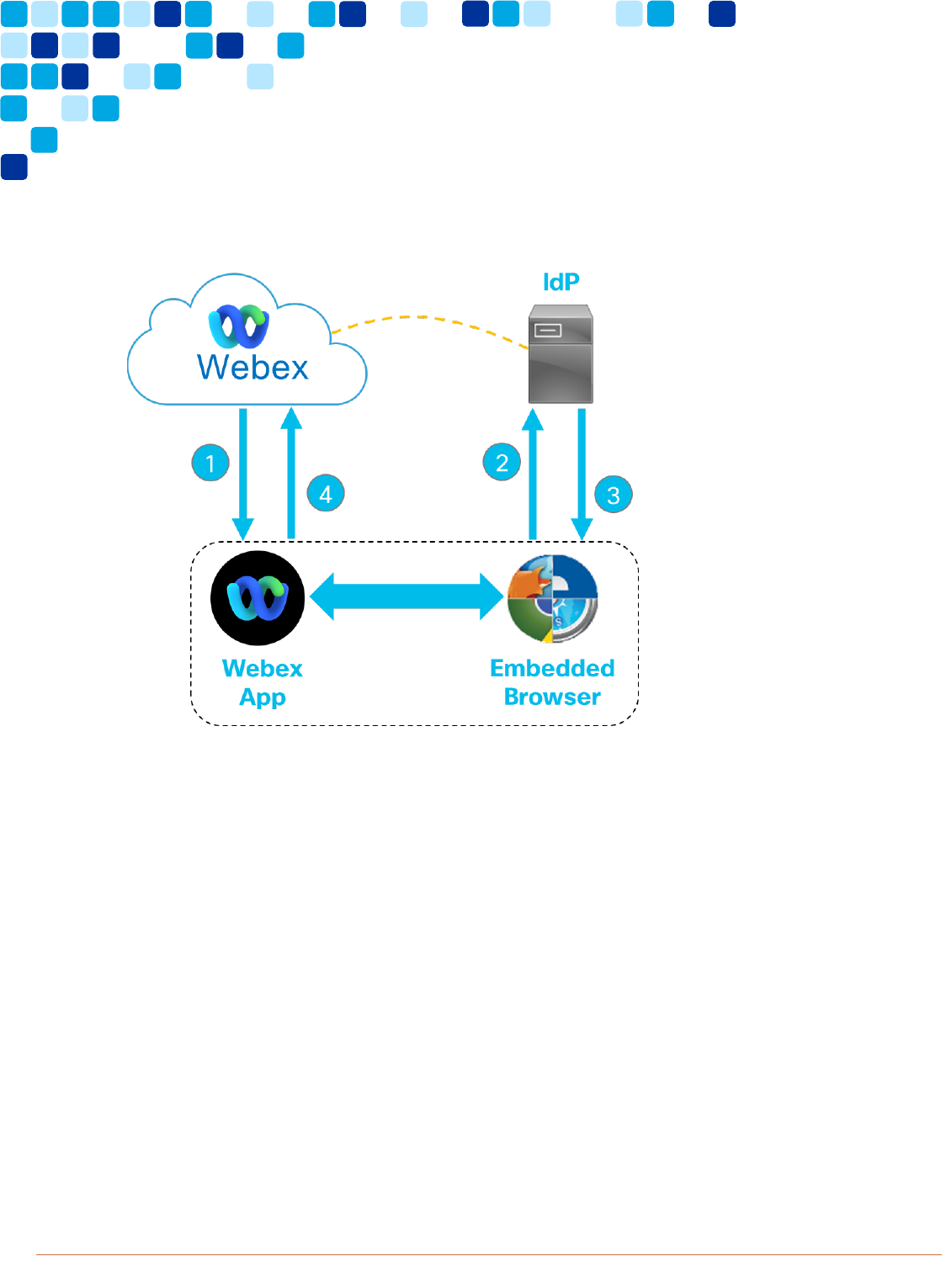
© 202
1 Cisco – CTG TME Collaboration Transitions – Clients: Transitioning from Jabber to Webex PAGE 22
Core Components
As shown in Figure 11, the Webex App will call upon a system browser/library
(embedded browser) to connect to the IdP for authentication.
Figure 11. Webex App Embedded Browser Flow
The flow depicted in Figure 11 is as follows:
1. The Webex Site is SSO enabled and redirects authentication requests to the IdP.
2. The Webex App calls to the embedded browser to connect to IdP. The embedded
browser/user authenticates based on the authentication type configured by the
IdP (for example, username/password, Kerberos, and so on).
3. The IdP issues SAML cookie to the embedded browser.
4. The Webex App then uses the SAML cookie to gain access to Webex services.
Once the Webex App has completed authentication, it will retrieve an OAuth Token that
will be used to gain access to Webex services, without the need to authenticate each
time. The OAuth token is long life (typically 60 days) and will be stored on the local
device for future logins.
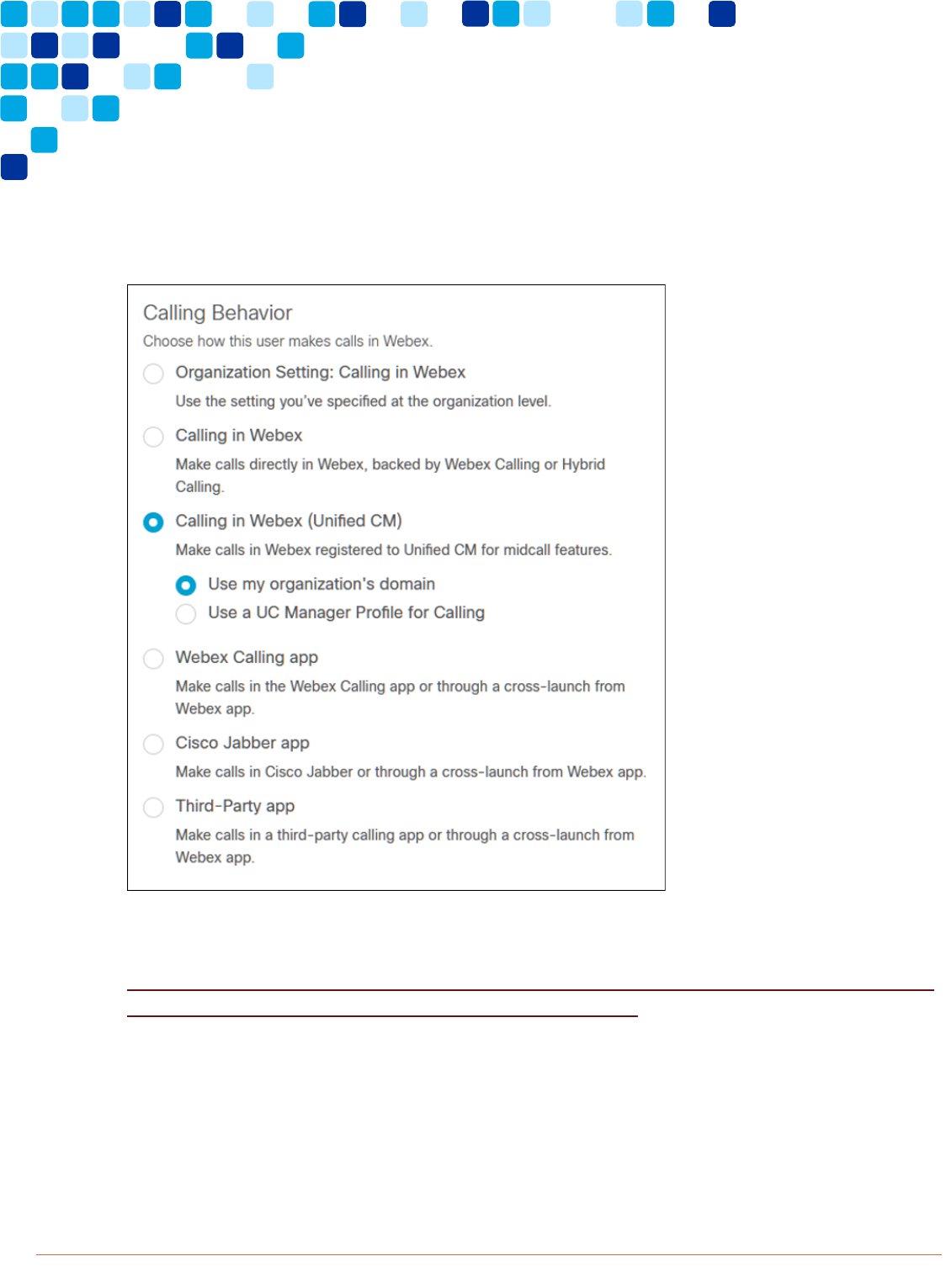
© 202
1 Cisco – CTG TME Collaboration Transitions – Clients: Transitioning from Jabber to Webex PAGE 23
Core Components
The Webex App will next download configuration defining calling behavior. Unified CM
Calling behavior is configured in Control Hub. As shown in Figure 12, Unified CM calling
behavior is defined using the Calling Behavior configuration option, either organization-
wide or on a per user basis (manual configuration or in bulk using the CSV file).
Figure 12. Webex Control Hub: Calling Behavior Configuration
For up to date information on defining calling behavior refer to the Deployment Guide
for Calling in Webex (Unified CM) available at
https://www.cisco.com/c/en/us/td/docs/voice_ip_comm/cloudCollaboration/wbxt/ucm
calling/unified-cm-wbx-teams-deployment-guide.html.
Once calling behavior has been discovered, Webex will then connect to additional
services (messaging, meeting, and so on).

© 202
1 Cisco – CTG TME Collaboration Transitions – Clients: Transitioning from Jabber to Webex PAGE 24
Core Components
Messaging
The Webex messaging service is hosted on the Webex platform. The Webex App
connects to the messaging service in Webex. Messaging is configured and managed
via Control Hub. Important configurations and policies for Webex messaging include:
Message and file sharing policy
o Message retention
o Messaging compliance
o Content/File management
External messaging policy
Webex datacenters will store customer data when using the Webex App. Data stored
includes user identities, encryption keys, and user generated content. Organizations
can choose which geo-based datacenter their data should be stored. The datacenter
should be selected when the Webex Organization is being created.
For more information refer to the Data Residency in Webex article available at
https://help.webex.com/en-us/oybc4fb/Data-Residency-in-Webex.
Meetings
Webex meetings service is hosted on the Webex platform. Organizations who already
utilize Webex Meetings service, can continue to use their existing service with the
Webex App. The following configurations are required to utilize existing Webex
Meetings Site in the Webex App.
Linking Site Admin to Control Hub.
Enablement of Webex Meetings experience in the Webex App.
Calling
The Webex App will connect to a native cloud calling service hosted on the Webex
platform. This native calling service provides basic call control and allows Webex App
users to call other users who have an account on the Webex platform. It will also allow
users make calls via SIP URI to external services. This calling service is also the service
that is used when the Webex App dials into a space meeting.
The native calling service does not provide for advanced call features like hold, resume,
transfer, and so on, nor does it provide the ability to integrate with a PSTN service. As

© 202
1 Cisco – CTG TME Collaboration Transitions – Clients: Transitioning from Jabber to Webex PAGE 25
Core Components
such, organizations typically deploy the Webex App with a call control service. The
Webex app can integrate directly with the following call controls:
Unified CM
UCM Cloud
Hosted Collaboration Solution (HCS)
Webex Calling
Since this document is focused on migrating from Jabber to Webex, it will focus on
Webex with Unified CM calling.
Unified CM Calling is enabled by checking the Calling in Webex (Unified CM) option (or
the comparable toggle through the Licensing Assignment in the future). After the
Webex App has connected to the Webex platform, it will next perform service
discovery for Unified CM. The Webex App will discover Unified CM just as Jabber did.
The application relies on DNS SRV based discovery of Unified CM when running on the
corporate network or Expressway-E (MRA) when running outside the corporate
network.
Figure 14 details the discovery process for the Webex App when located inside the
corporate network boundary.
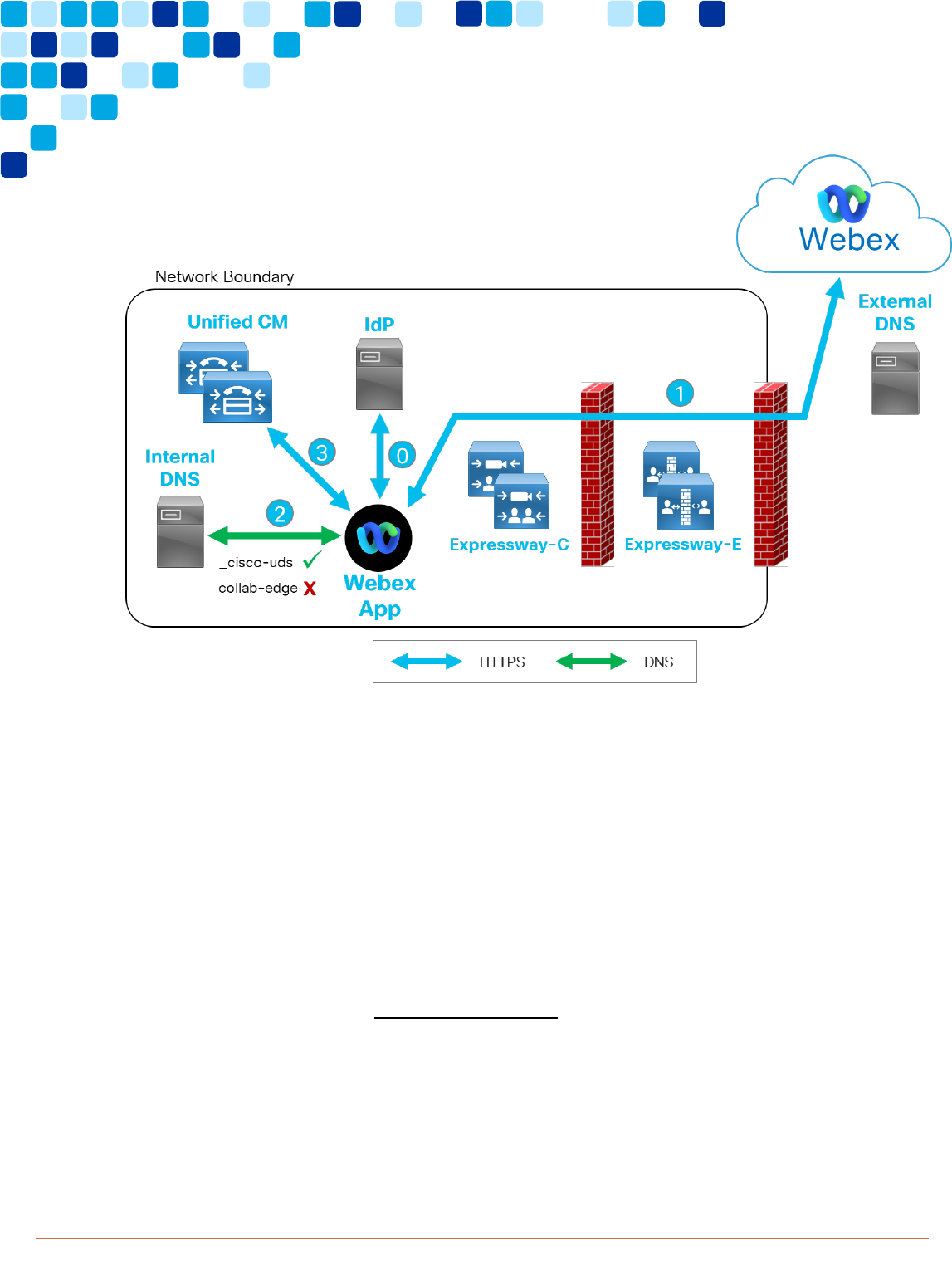
© 202
1 Cisco – CTG TME Collaboration Transitions – Clients: Transitioning from Jabber to Webex PAGE 26
Core Components
Figure 13. On-Premises Webex App Service Discovery
The flow depicted in Figure 14 is as follows:
1. As mentioned earlier, this document assumes that all services are SSO enabled
(Webex and Unified CM). This means that the Webex App performed an SSO
based login to Webex previously. The IdP will have presented the Webex App
with a SAML cookie upon successful authentication. This SAML cookie is used to
gain access to Webex services. Later in the flow, the SAML cookie will be reused
for other services.
2. On the initial login screen, before authentication, the user typed in their email
address, for example, [email protected]. This address will be used for the
Unified CM discovery process. The Webex App downloads licensing assignment
from the Webex Site and determines that Unified CM calling is enabled. This will
prompt the Webex App to initiate the discovery process.

© 202
1 Cisco – CTG TME Collaboration Transitions – Clients: Transitioning from Jabber to Webex PAGE 27
Core Components
3. The Webex App sends the two discovery DNS SRV queries just like Jabber does.
The Webex App uses the domain name entered by the user at initial sign-in to
send the DNS queries. This domain is referred to as the Voice Services Domain.
The DNS queries sent to DNS are:
_cisco-uds._tcp.example.com
_collab-edge._tls.example.com
Note: For organizations with a different Webex domain from their Voice Services
Domain, or for organizations with multiple Voice Service Domains, Control Hub
allows configuration of different Voice Service Domain(s), on a per user basis. This
is covered in detail later in this document.
In this example, the Webex App is running on the corporate network, so DNS will
return a positive result for the _cisco-uds query, pointing to the FQDN of a Unified
CM node in the deployment.
4. The Webex App connects to the Unified CM node that is returned from the DNS
SRV query. The Unified CM node that the Webex App initially connects to may not
be part of the Webex App users’ home cluster. As such the Webex App now
needs to perform home cluster discovery.
The home cluster discovery flow for the Webex App is identical to the home cluster
discovery flow for Jabber described previously.
Home cluster discovery is the process whereby the Webex App makes a primary
connection to any Unified CM node in the organization and is then redirected to the
publisher node of the user’s home cluster. The user’s home cluster is the cluster where
the user will obtain services for configuration download, device registration, desk
phone control mode, and other services. A user’s home cluster is defined
administratively, by associating the user with their home cluster. Home cluster is set in
bulk using the BAT tool or can be done manually on the end user configuration page.
Figure 15 shows the Home Cluster checkbox checked for an end user on this cluster.
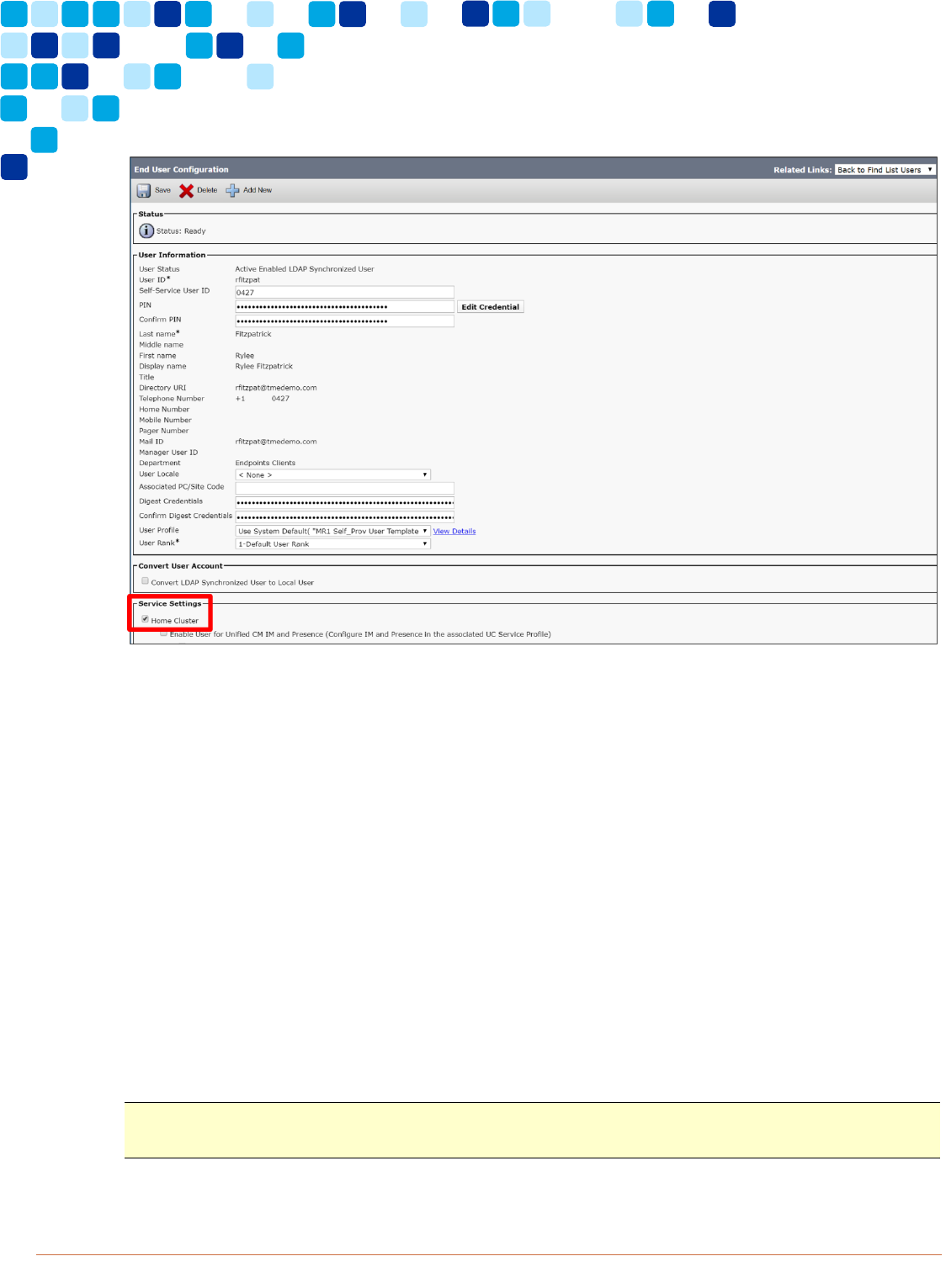
© 202
1 Cisco – CTG TME Collaboration Transitions – Clients: Transitioning from Jabber to Webex PAGE 28
Core Components
Figure 14. Unified CM: Home Cluster Setting
As mentioned previously home cluster discovery relies on the Intercluster Lookup
Service (ILS) and ILS should be configured between all Unified CM clusters.
Home cluster discovery for Webex as described and shown above also applies to
MRA-based remote connections, whereby Expressway-C performs the home cluster
discovery on behalf of the remote Webex App.
Home cluster queries sent by the Webex App are as follows:
https://UnifiedCM_FQDN:8443/cucm-uds/clusterUser?username=alice
https:// UnifiedCM_FQDN:8443/cucm-uds/clusterUser?email=[email protected]
As before, the Unified CM_FQDN component of the above URLs is determined by the
Unified CM address returned from the DNS SRV query for _cisco-uds.
Note: For Webex App connections over MRA, Expressway-C will perform the home
cluster query against the internal DNS server.

© 202
1 Cisco – CTG TME Collaboration Transitions – Clients: Transitioning from Jabber to Webex PAGE 29
Core Components
The user identifier at the end of the query will be based on the email address the user
types into the Webex App on the primary login screen. The Webex App sends two
queries, one using username, and one using email. The reason for two queries is to
cater for organizations who do not standardize on using username as UID in Unified
CM.
Note: With Unified CM 10.5.2 and later, users email addresses are synced from LDAP
directory during LDAP sync.
As described before, once home cluster discovery is successful, the Webex App will
connect to the publisher node of the home cluster to request a list of all cluster nodes,
connect to a randomly selected node from the list returned, and then request the
download of user configuration. Finally, the Unified CM node will challenge Webex for
authentication.
The Webex App has previously authenticated via SSO when connecting to the Webex
Site. Unified CM is also SSO enabled, with the same IdP as the Webex Site. As such,
the Webex App reuses the existing SAML token received from the IdP to gain access
to Unified CM – there is no need for the user to explicitly authenticate with Unified CM.
If SSO was not enabled on the Webex Site as well as Unified CM, the user would need
to manually enter username and password again, to authenticate to Unified CM.
Figure 16 shows the Webex App embedded browser authentication flow.
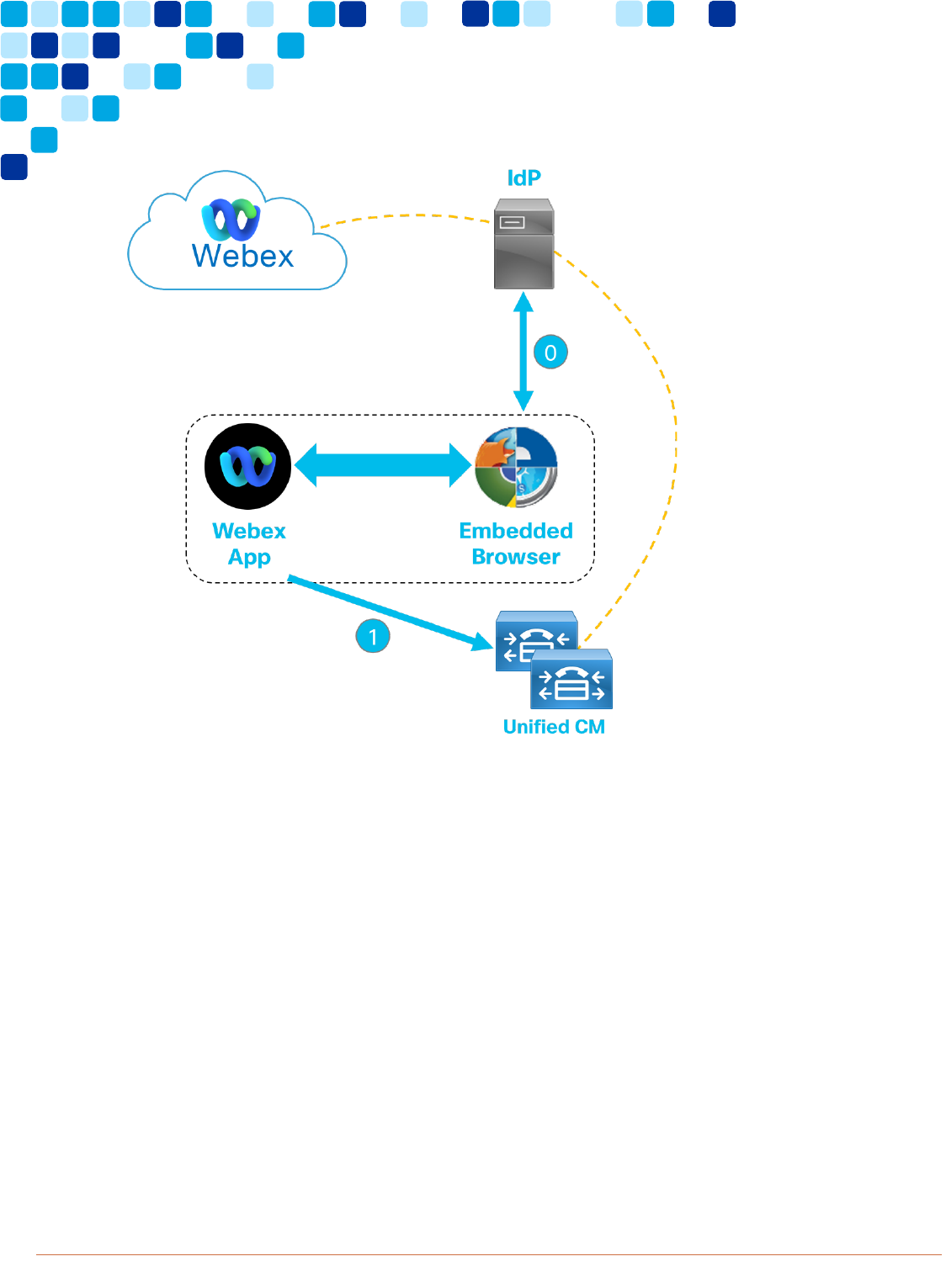
© 202
1 Cisco – CTG TME Collaboration Transitions – Clients: Transitioning from Jabber to Webex PAGE 30
Core Components
Figure 15. Webex App Embedded Browser Flow with Unified CM
The flow depicted in Figure 16 is as follows:
1. A SAML cookie have already been received from the IdP during the previous
Webex service authentication.
2. The Webex App uses the existing SAML cookie to gain access to Unified CM
services without the user needing to explicitly authenticate.
Once the Webex App has authenticated with Unified CM, it will retrieve an OAuth
refresh token. The Webex App uses the OAuth refresh token to retrieve an OAuth
access token from Unified CM. The OAuth Access Token is used to gain access to
specific services including UDS. This flow assumes that OAuth Refresh Token Flow is
enabled in Unified CM.
Next, the Webex App downloads configuration from Unified CM including

© 202
1 Cisco – CTG TME Collaboration Transitions – Clients: Transitioning from Jabber to Webex PAGE 31
Core Components
Service profiles
Jabber configuration
End user configuration
Device list
Device configuration
The Service Profile will detail specific services and the service location (FQDN) that the
Webex App should connect to if configured. The service profile may include some or all
of the following services:
CTI
Jabber Client Configuration
Voicemail
The Webex App will connect to the CTI service if the user selects to run in desk phone
control mode. The end user account in Unified CM will require the role of Standard CTI
Enabled to run the Webex App in desk phone control mode. This role may have already
been enabled for Jabber.
The Webex App will download the Jabber client configuration. This configuration is
available in Unified CM 12.5 and above. The configuration is equivalent to what can be
configured in the jabber-config.xml file. The jabber-config.xml file is downloaded if
available.
The Webex App will connect to the Unity Connection server as defined in the Service
Profile. The Unity Connection service will provide voicemail capabilities to the Webex
App. And if SSO is enabled on Unity Connection, the user will not have to explicitly
authenticate with the service.
The Webex App will connect to a Unified CM node as defined in the CM Group list for
softphone services (SIP). It will use the same device types as Jabber for softphone
registration.
Table 4 show the device types in Unified CM based on the operating system of the
Webex client application is running on.
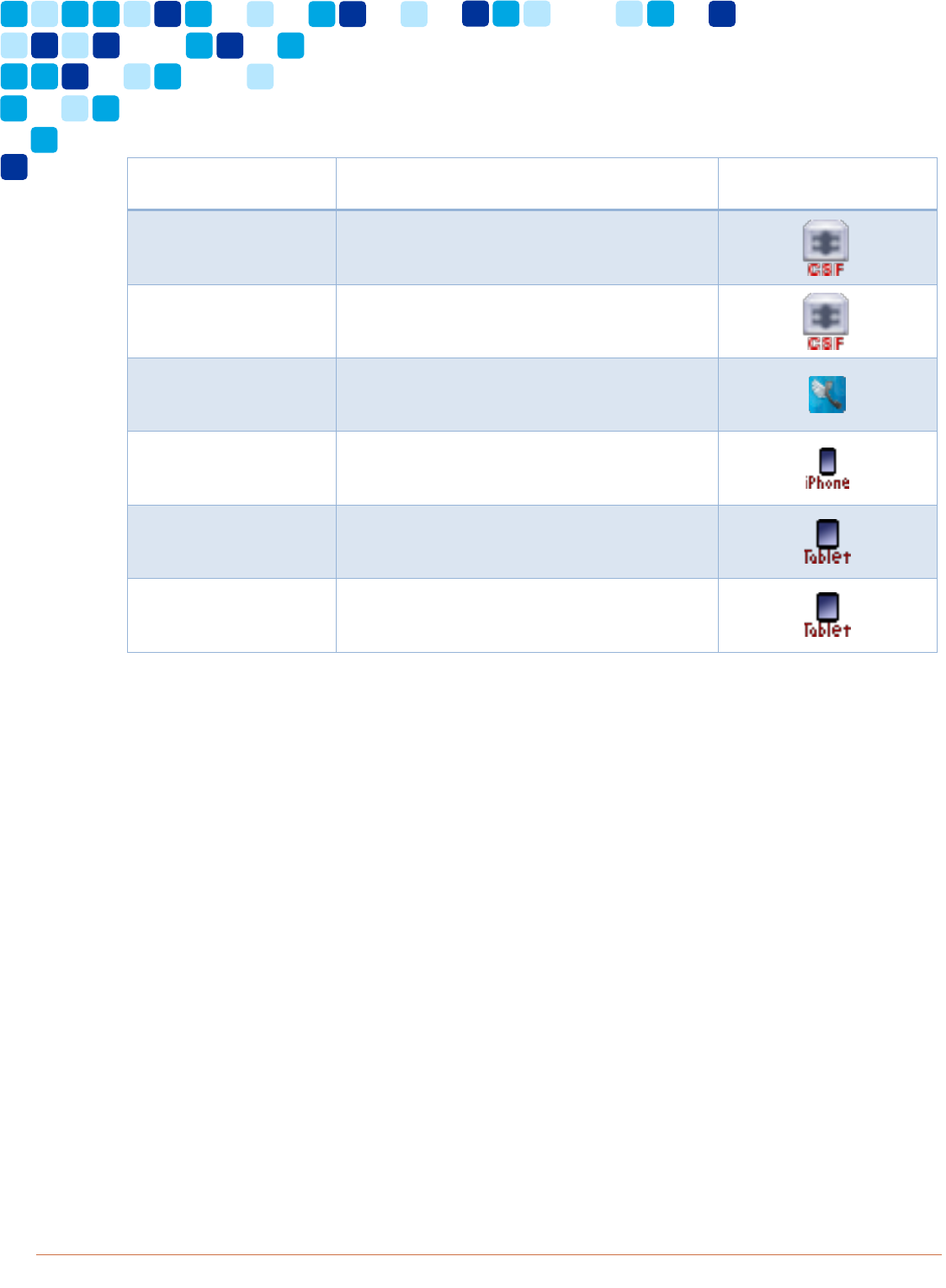
© 202
1 Cisco – CTG TME Collaboration Transitions – Clients: Transitioning from Jabber to Webex PAGE 32
Core Components
Table 4. Webex App Operating System Device Type
Operating System
Unified CM Device Type
Unified CM Device
Icon
Windows
Cisco Unified Client Services
Framework (CSF)
Mac
Cisco Unified Client Services
Framework (CSF)
Android Phone
Cisco Dual Mode for Android (BOT)
iPhone
Cisco Dual Mode for iPhone (TCT)
Android Tablet
Cisco Jabber for Tablet (TAB)
iPad
Cisco Jabber for Tablet (TAB)
Figure 17 summarizes service discovery for the Webex App when enabled for calling
with Unified CM.
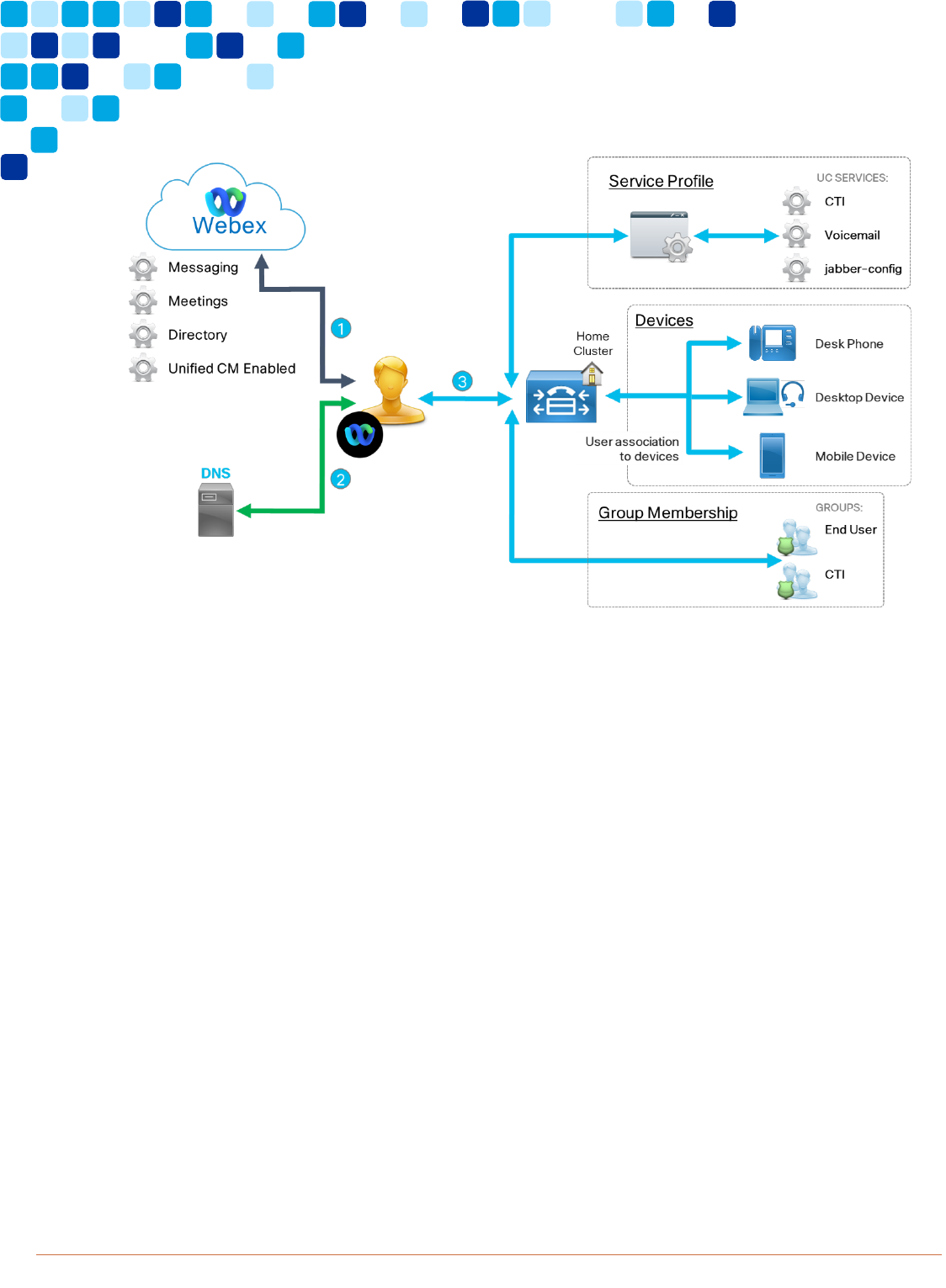
© 202
1 Cisco – CTG TME Collaboration Transitions – Clients: Transitioning from Jabber to Webex PAGE 33
Core Components
Figure 16. Webex App with Unified CM Configuration Architecture
The flow depicted in Figure 17 is as follows:
1. Connect to Webex services and download calling behavior configuration detailing
Unified CM enablement.
2. Begin service discovery process by sending DNS SRV queries.
3. Connect to Unified CM and download Service Profile to determine additional
available services.
In the case of the Webex App outside the on-premises network boundary, the
discovery depicted in Figure 17 is the same, except that the DNS SRV query is
answered by external DNS resulting in the application connecting to Unified CM
through Expressway MRA rather than directly. As shown in Figure 18, service discovery
and service profile download are handled by Expressway-C on behalf of the Webex
App.
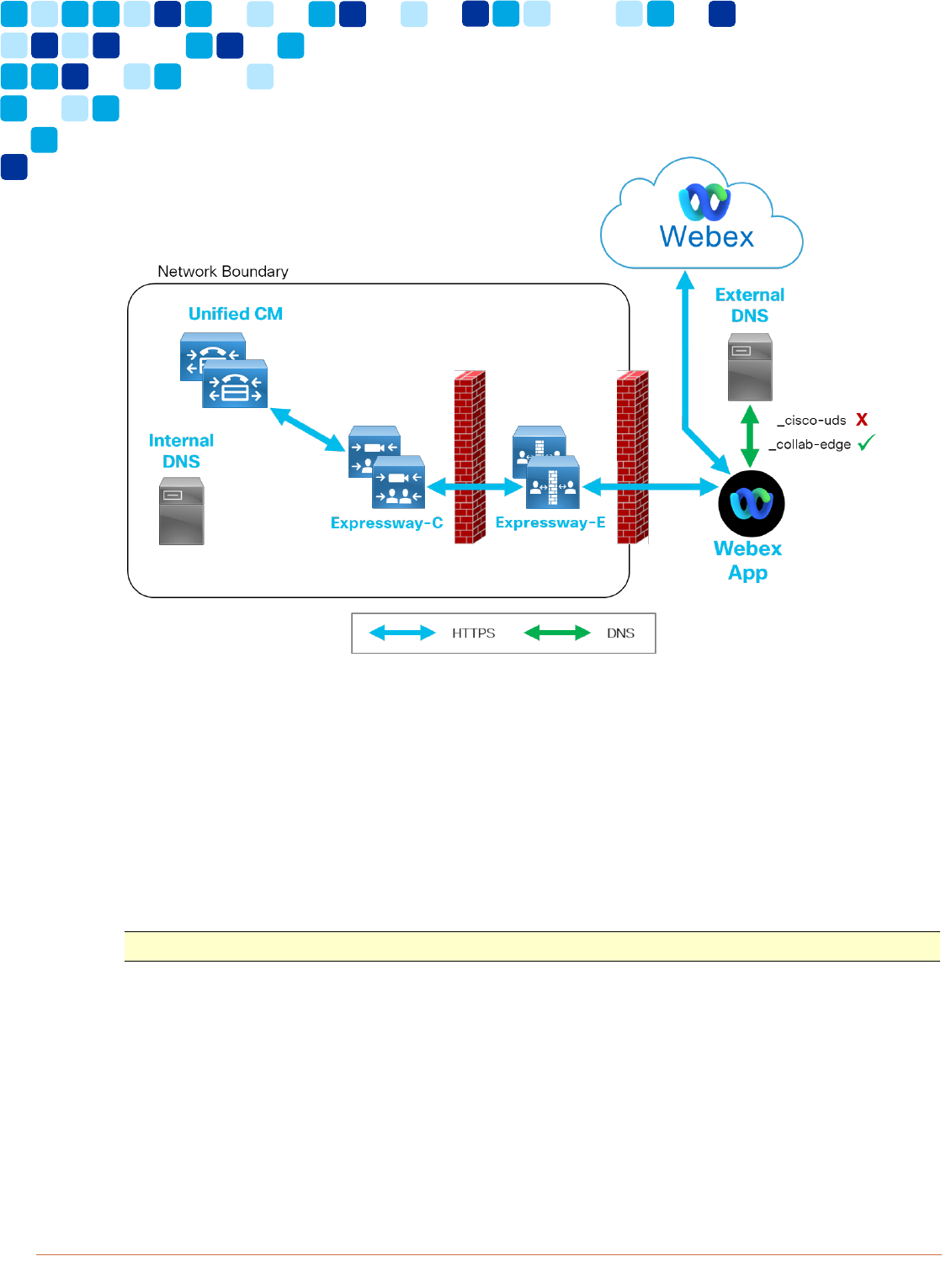
© 202
1 Cisco – CTG TME Collaboration Transitions – Clients: Transitioning from Jabber to Webex PAGE 34
Core Components
Figure 17. Expressway Mobile and Remote Access Webex App Service Discovery
Subsequent Logins
The Webex App will maintain service details in a cache file that is stored on the local
disk. The OAuth tokens for Webex and Unified CM services are also be stored. This
information is used for subsequent logins. For example, the Webex App will use the
OAuth token to gain access to other collaboration services without a requirement to
authenticate each time. Another benefit of this approach is that the Webex App will
connect to Unified CM services, even if connectivity to the Webex service is unavailable
(for example, during an Internet outage).
Note: Cache files are encrypted before being stored on local disk.
Directory Integration
The Webex App connects to the Webex Platform for directory services. The Webex
App relies on directory services for several purposes including:
Contact Card
Contact Search
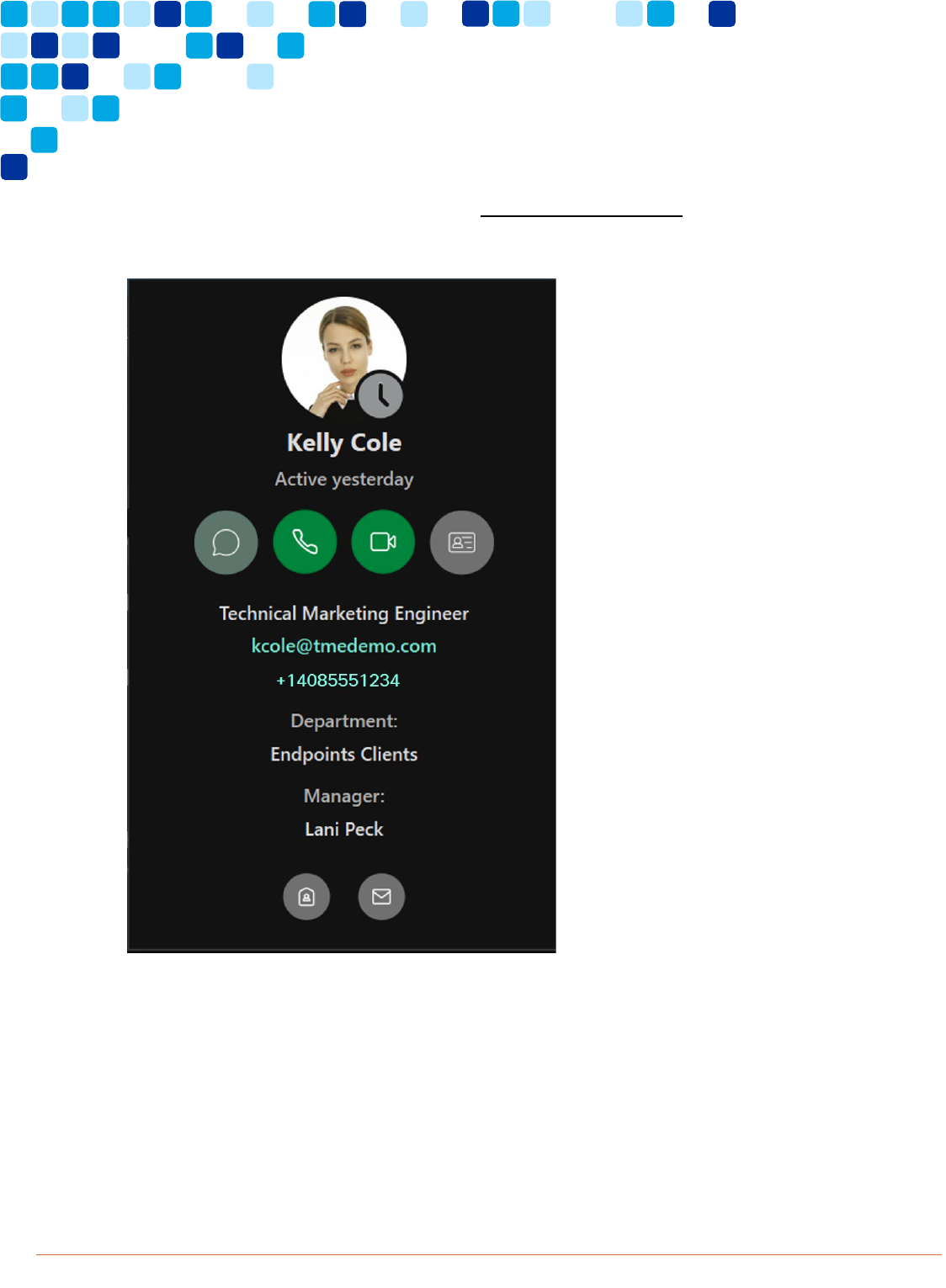
© 202
1 Cisco – CTG TME Collaboration Transitions – Clients: Transitioning from Jabber to Webex PAGE 35
Core Components
Contact Resolution
Incoming Call Resolution
For example, the contact card of user k[email protected]m is shown in Figure 19.
Figure 18. Webex App User Contact Card
The Webex App retrieved the following information from Webex directory service to
populate the contact card:
Display Name
Directory Photo
Job Title

© 202
1 Cisco – CTG TME Collaboration Transitions – Clients: Transitioning from Jabber to Webex PAGE 36
Core Components
Phone Number(s)
Department
Manager
Users and their associated attributes can be synchronized to Webex directory services
using one of the following methods:
Directory Connector
SCIM
CSV file
People API
Manual
Directory Connector is the preferred method for synchronizing users to Webex.
Directory Connector connects directly to Microsoft Active Directory and can
synchronize user information to Webex at regular intervals. It is important to sync the
entire directory to Webex, if you plan for end users to be able to search the entire
directory from the Webex App. The Webex App can also search for users against the
Outlook Address Book when running on a Windows PC.
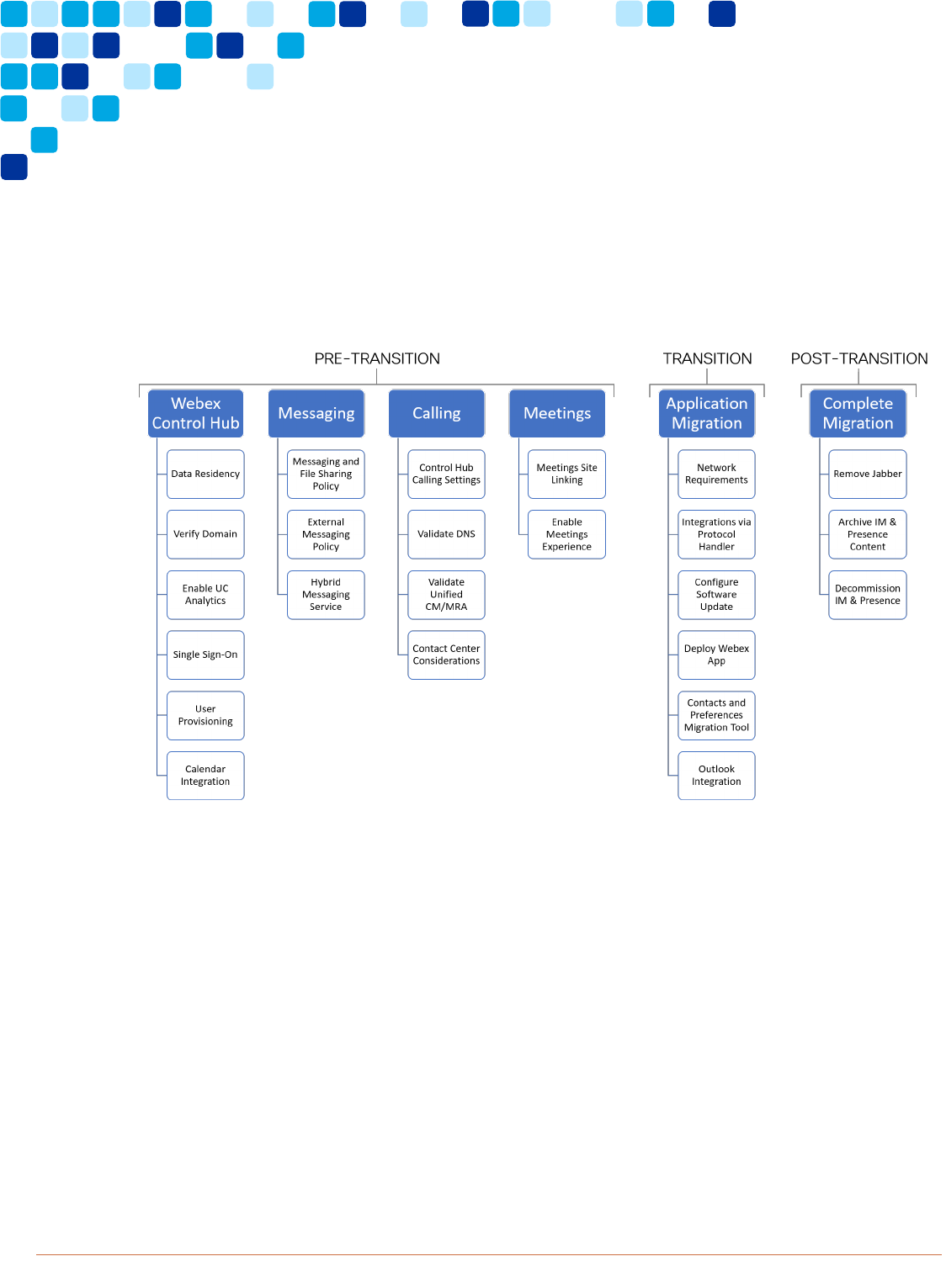
© 202
1 Cisco – CTG TME Collaboration Transitions – Clients: Transitioning from Jabber to Webex PAGE 37
Transition
Transition
Overview of this Transition Deployment Guide
This section focuses on what needs to be done to migrate from Jabber to the Webex
App. Figure 20 shows the typical Jabber to Webex deployment transition
Figure 19. Jabber to Webex Deployment Transition
As shown in Figure 20, the transition is broken down into three high-level sets of steps
to be considered for this transition:
Pre-transition steps – These are the preliminary steps that should be done to
prepare the environment prior to making the transition.
The pre-transition set of steps are organized into sections to simplify the steps
and allow focus on each of the collaboration workloads: messaging, calling, and
meetings.
o Webex Control Hub section - Focused on the basic setup for the Webex
organization.

© 202
1 Cisco – CTG TME Collaboration Transitions – Clients: Transitioning from Jabber to Webex PAGE 38
Transition
o Messaging section – Focused on possible messaging service configurations
available in Control Hub as well as Hybrid Messaging Service which provides
messaging interop between Unified CM IM&P and Webex during a migration.
o Calling section - Focused on the steps required to migrate Unified CM calling
capabilities from Jabber to the Webex App. This section will also call out the
specific calling mode of Jabber Cross Launch from the Webex App. This
mode is targeted at users who need advanced Contact Center features.
o Meetings section – Focused on what is required to migrate meetings
capabilities from the Webex Meetings App to the Webex App.
Transition steps – These are the steps to implement the transition from Jabber to
Webex.
The transition set of steps involves the actual migration between the Jabber and
Webex applications and covers all the necessary as well as optional steps to make
this transition.
Post-transition steps – These are the steps that should be done to complete the
transition.
In this case, the post-transition set of steps details how unneeded Jabber clients
and collaboration services can be decommissioned.
It is worth pointing out that not all the deployment transition steps described here are
mandatory and further, that the steps within a specific set of steps may be completed
in a different order or at a different time.
Note: This document does not cover transitioning call control from on-premises Unified
CM to cloud Webex Calling. For information about that transition refer to the Unified CM
to Webex Calling transition documents available at https://www.cisco.com/go/ct.
Pre-Transition Steps and Considerations
Below are the pre-transition steps to consider when performing the client transition
from Jabber to Webex.
Prior to embarking on a transition, in order to determine the feasibility and potential
modifications required, it is important to consider aspects of your existing environment.
Likewise, you must understand the key elements of the Webex offer in comparison with
the existing on-premises deployment.

© 202
1 Cisco – CTG TME Collaboration Transitions – Clients: Transitioning from Jabber to Webex PAGE 39
Transition
1. Setup Control Hub
Control Hub is the administrative portal for managing Webex services as well as the
Webex App. Webex Control Hub is available at https://admin.webex.com/.
The following are the sub-steps involved in setting up Control Hub for the Webex
App:
i. Understand Data Residency
ii. Verify Domain
iii. Enable UC Analytics
iv. Enable Single Sign-On
v. Provision Users
vi. Integrate Calendar
i.
Understand Data Residency
Webex datacenters will store customer data from the Webex App. Data stored
includes user identities, encryption keys, and user generated content.
Organizations can choose which geo-based datacenter stores their data. The
datacenter should be selected when the Webex Organization is being created.
For more information on data residency refer to the Data Residency in Webex
article available at https://help.webex.com/en-us/oybc4fb/Data-Residency-in-
Webex.
ii.
Verify Domain
Once the Webex org has been acquired for your organization, you must use
Control Hub to claim the domain as proof of ownership. This is a mandatory step.
This process involves publishing of a DNS TXT record for your domain which
Webex can resolve.
Refer to the Manage Your Domains article available at
https://help.webex.com/en-us/nxz79m5/Add-Verify-and-Claim-Domains.
iii.
Enable UC Analytics
Unified CM and Jabber analytics for your organization can be viewed in Control
Hub. Unified CM analytics can be viewed in Control Hub by enabling Webex
Cloud Connected UC. Jabber analytics can be viewed in Control Hub by

© 202
1 Cisco – CTG TME Collaboration Transitions – Clients: Transitioning from Jabber to Webex PAGE 40
Transition
enabling Jabber Telemetry with Org ID. This is not a mandatory step for
migration to the Webex App, however it is recommended for the following
reasons:
To provide visibility into the existing Unified CM and Jabber deployment
pre-migration.
To provide visibility into migration progress at migration time.
To take advantage of future Cloud Connected UC (CCUC) operational
features.
CCUC allows organizations to view Unified CM analytics in Control Hub. This is
achieved by installing the CCUC plugin on existing Unified CM clusters. The
plugin provides for Unified CM connectivity to Webex, which enables publishing
of Unified CM analytics to Control Hub.
For more details on the benefits of CCUC refer to the Cisco Webex Cloud-
Connected UC Data Sheet available at
https://www.cisco.com/c/en/us/products/collateral/unified-
communications/webex-cloud-connected-uc/datasheet-c78-743868.html.
Jabber can post usage telemetry to the Webex analytics service and
organizations can view their own Jabber telemetry in Control Hub. The data
collected by Jabber does not contain any Personal Identifiable Information (PII) –
that is, individual users cannot be identified from the data that is sent to the
Webex service. Control Hub allows organizations to view several Jabber data
points including:
Breakdown of platform Jabber is running on
Breakdown of versions of Jabber
Number of video/audio calls
Call quality
Number of chats
Mobile Remote Access (MRA) usage
To view your organization’s Jabber telemetry in Control Hub, your organization’s
telemetry data needs to be marked with your Webex Organization ID. The
Webex Organization ID is a 32-character string which identifies the Webex
organization. The Webex Organization ID can be obtained by logging into Control
Hub and clicking Account.
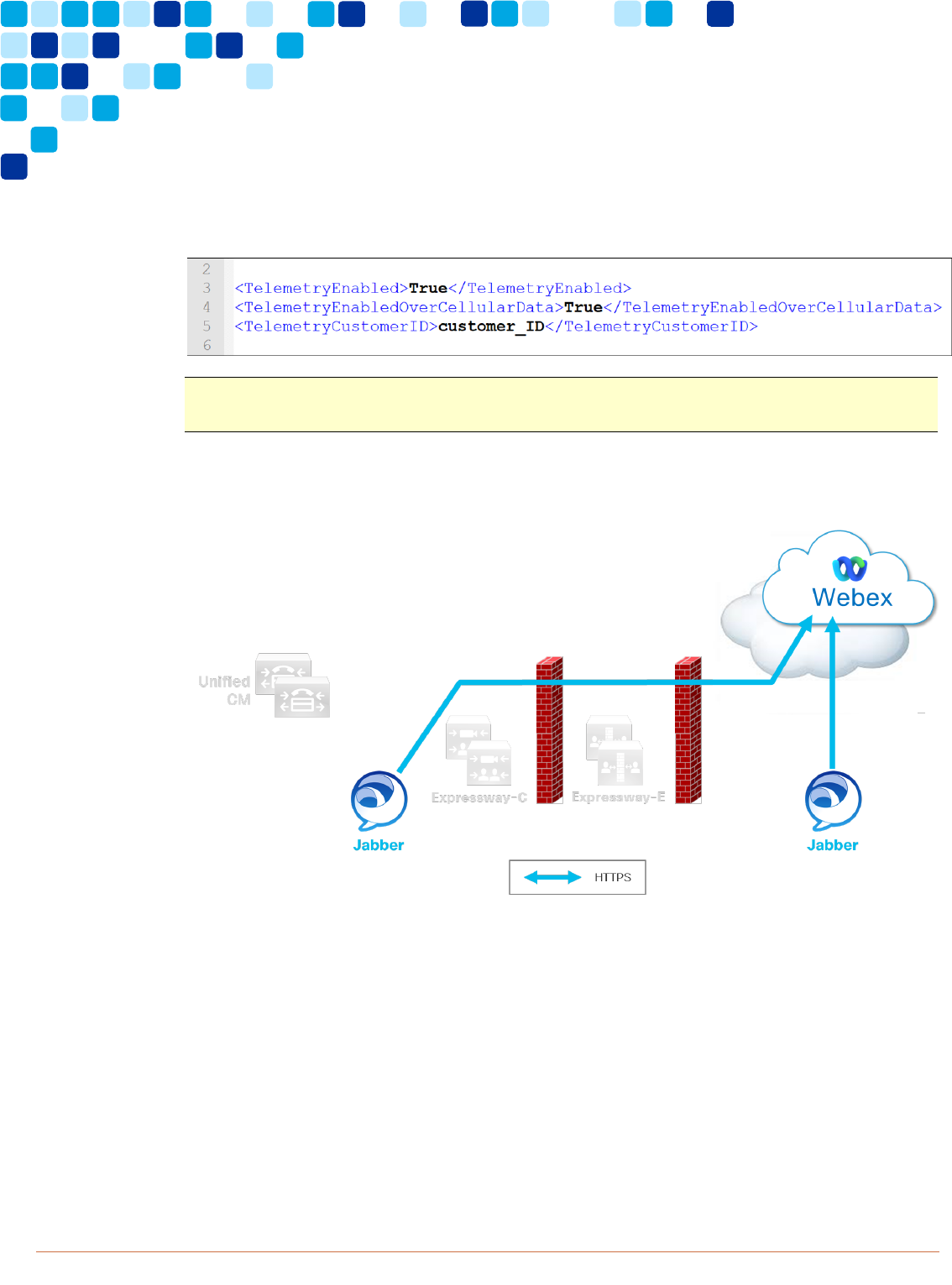
© 202
1 Cisco – CTG TME Collaboration Transitions – Clients: Transitioning from Jabber to Webex PAGE 41
Transition
The keys shown in Figure 21 should be added to the jabber-config.xml file (or to
the Jabber Client Configuration UC Service if running Unified CM 12.5). Replace
customer_ID with your Webex Organization ID.
Figure 20. Jabber-config to Enable Telemetry in Webex Control Hub
Note: Users can disable Jabber telemetry from the Jabber client help menu,
even if the administrator has enabled in the jabber-config.xml file.
Jabber will post the telemetry data to Webex at regular intervals (see Figure 22).
Figure 21. Jabber Telemetry Flow
Ensure Jabber clients can reach the Webex analytics service. The following may
need to be configured on your firewall: Outbound TCP 443 metrics-
a.wbx2.com/metrics/api/v1/metrics.
As shown in Figure 22, telemetry is posted to Webex via HTTPS. Jabber will
validate the certificate presented by the Webex analytics service. The following
certificate should be installed on the local device to prevent certificate validation
from failing: GoDaddy Class 2 Certification Authority Root Certificate.

© 202
1 Cisco – CTG TME Collaboration Transitions – Clients: Transitioning from Jabber to Webex PAGE 42
Transition
The Jabber analytics dashboard will appear automatically in Control Hub 24
hours after the first Jabber telemetry packet is received, and marked with your
Webex Organization ID. The Jabber analytics dashboard can be viewed in the
Analytics tab.
iv.
Enable Single Sign-On (SSO)
While SSO is not a mandatory requirement for migration to the Webex App, it is
highly recommended. The Webex App may sign-in to several different services
including Webex, Unified CM, Unity Connection, and other services. By enabling
SSO across all services, users can have a single login experience for all services.
SSO also provides security benefits including support for multiple types of
authentication, for example, certificates or MFA.
SSO can be enabled for the Webex organization on Control Hub. Control Hub
supports SSO integration with any IdP that supports the SAML standard.
For more information on enabling SSO for your Webex organization refer to the
Single Sign-On Integration in Control Hub article available at
https://help.webex.com/en-us/lfu88u/Single-Sign-On-Integration-in-Control-
Hub.
If SSO is not enabled for the Webex organization, Webex users will sign in using
a user ID and password. These passwords will be maintained by Webex, and
they will not be coupled or synchronized with corporate directory passwords. If a
user changes their corporate directory password, this will not change their
Webex App password. The user will also need to manually sign into other
services (for example, Unified CM for calling).
If Webex SSO is not enabled, users will receive an automated welcome email
once their account is created in Control Hub. This email will provide a link for
users to set their Webex password. Refer to the Provision Users section below
for more details.
v.
Provision Users
Before users are added to Control Hub, License Assignment Templates should
be configured. The License Assignment Template will allow for automatic
licensing of users for services once they are synced to Control Hub. As shown in
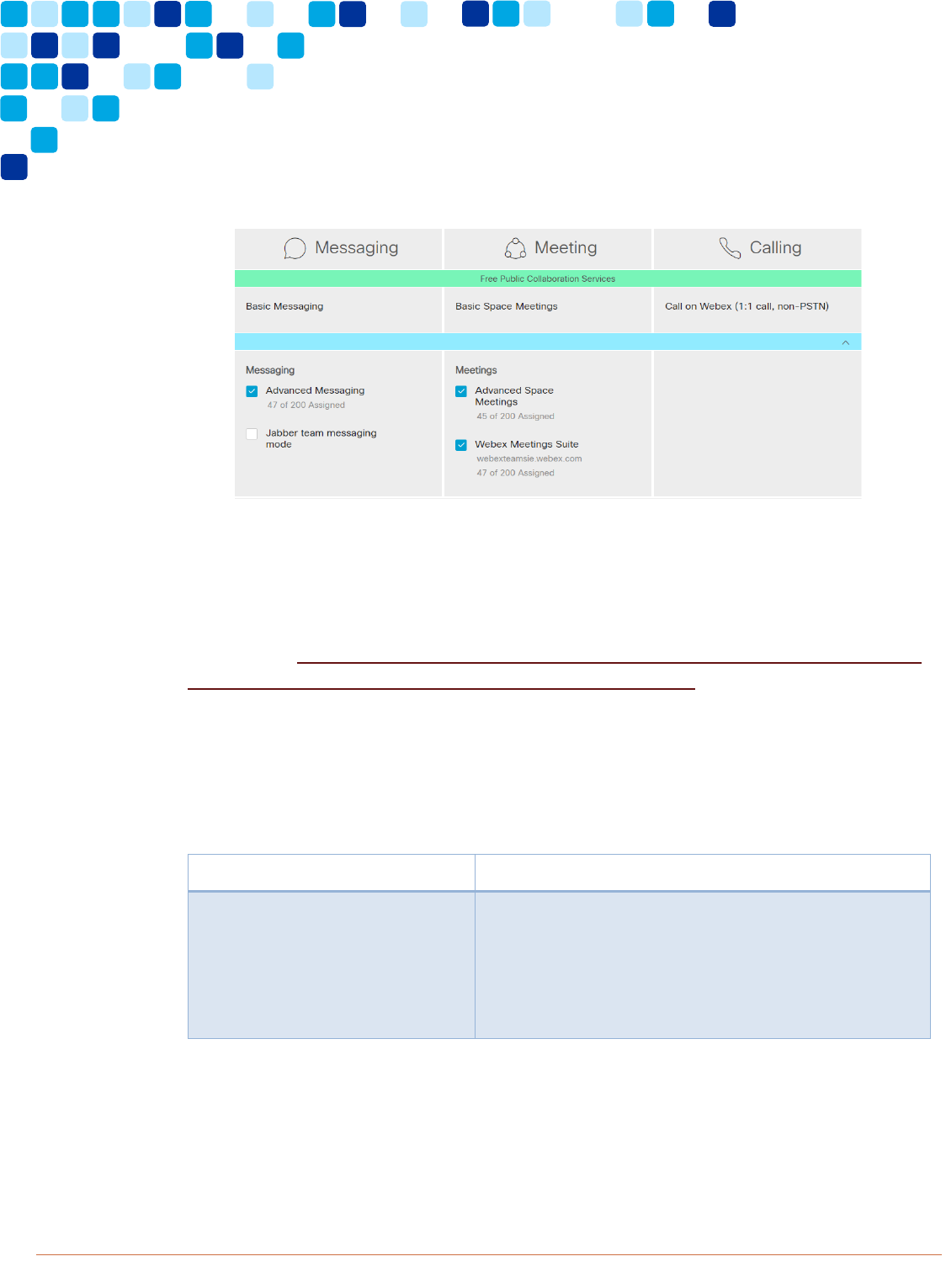
© 202
1 Cisco – CTG TME Collaboration Transitions – Clients: Transitioning from Jabber to Webex PAGE 43
Transition
Figure 22. Webex Control Hub: License Assignment
For more details on configuring License Assignment Templates refer to the Set
Up Automatic License Assignment Templates in Cisco Webex Control Hub article
available at https://help.webex.com/en-us/n3ijtao/Set-Up-Automatic-License-
Assignment-Templates-in-Cisco-Webex-Control-Hub.
Users must be created in Control Hub before they can use the Webex App. As
shown in Table 5, Control Hub provides several methods for provisioning user
accounts.
Table 5. Webex Control Hub User Provisioning Methods
User Provisioning Service
Details
Directory Connector
Director Connector manages user syncing
from Active Directory (AD) to Webex. It also
allows AD groups to be synced to Webex,
which allows some user services to be
enabled based on AD groups.

© 202
1 Cisco – CTG TME Collaboration Transitions – Clients: Transitioning from Jabber to Webex PAGE 44
Transition
System for Cross-Domain
Identity Management (SCIM)
System for Cross-Domain Identity
Management or SCIM is an open standard for
managing user identities across different cloud
services. Users can be synced to Webex from
services including Azure and Okta via SCIM.
CSV File
Webex Control Hub allows for user
provisioning via a CSV file. The CSV file can be
used to add user accounts as well as
configuring user services.
Manual
User accounts can be managed directly in
Webex Control Hub.
Directory Connector is the recommended tool for user provisioning. Existing
Jabber deployments, will likely already synchronize users from Active Directory
to Unified CM.
Figure 24 details the architecture for user provisioning via Directory Connector.
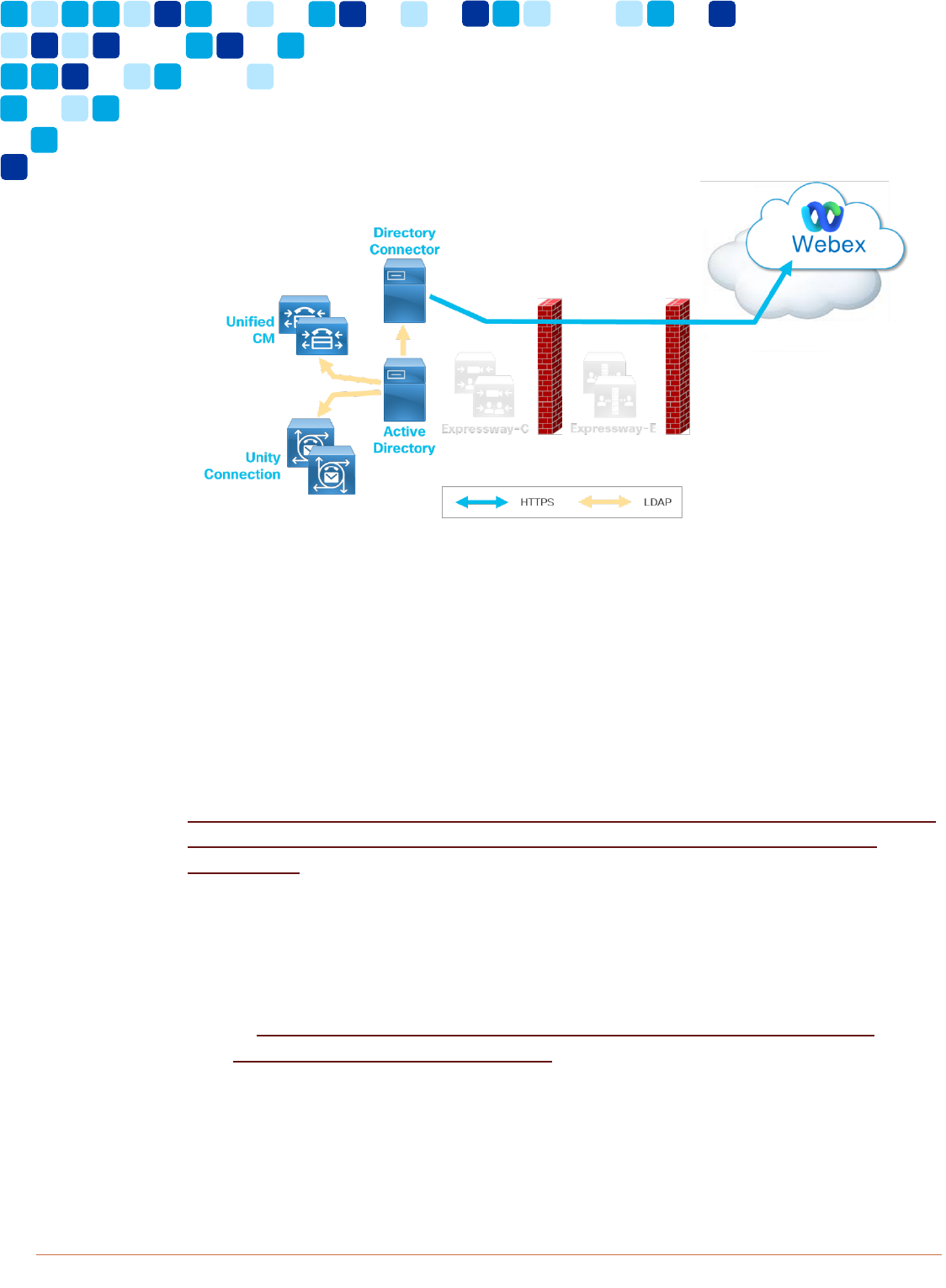
© 202
1 Cisco – CTG TME Collaboration Transitions – Clients: Transitioning from Jabber to Webex PAGE 45
Transition
Figure 23. Webex Directory Connector Architecture with Unified CM LDAP
Synchronization
As shown in Figure 24, LDAP synchronization can be enabled on Unified CM and
Unity Connection to synchronize users directly from AD. In turn, Directory
Connector can be deployed to synchronize users from Active Directory into
Webex.
Director Connector is an application that is installed on a machine running the
Windows Server operating system.
For more details on deploying Webex Directory Connector, refer to the
Deployment Guide for Cisco Directory Connector available at
https://www.cisco.com/c/en/us/td/docs/voice_ip_comm/cloudCollaboration/spa
rk/hybridservices/directoryconnector/cmgt_b_directory-connector-guide-
admins.html.
If AD is not available for your organization, another of the following user
provisioning methods can be used:
For more details on provisioning users in Webex from Azure AD, refer to the
Synchronize Azure Active Directory Users into Control Hub article available
at https://help.webex.com/en-us/6ta3gz/Synchronize-Azure-Active-
Directory-Users-into-Control-Hub.
For more details on provisioning users in Webex from Okta, refer to the
Synchronize Okta Users into Cisco Webex Control Hub article available at
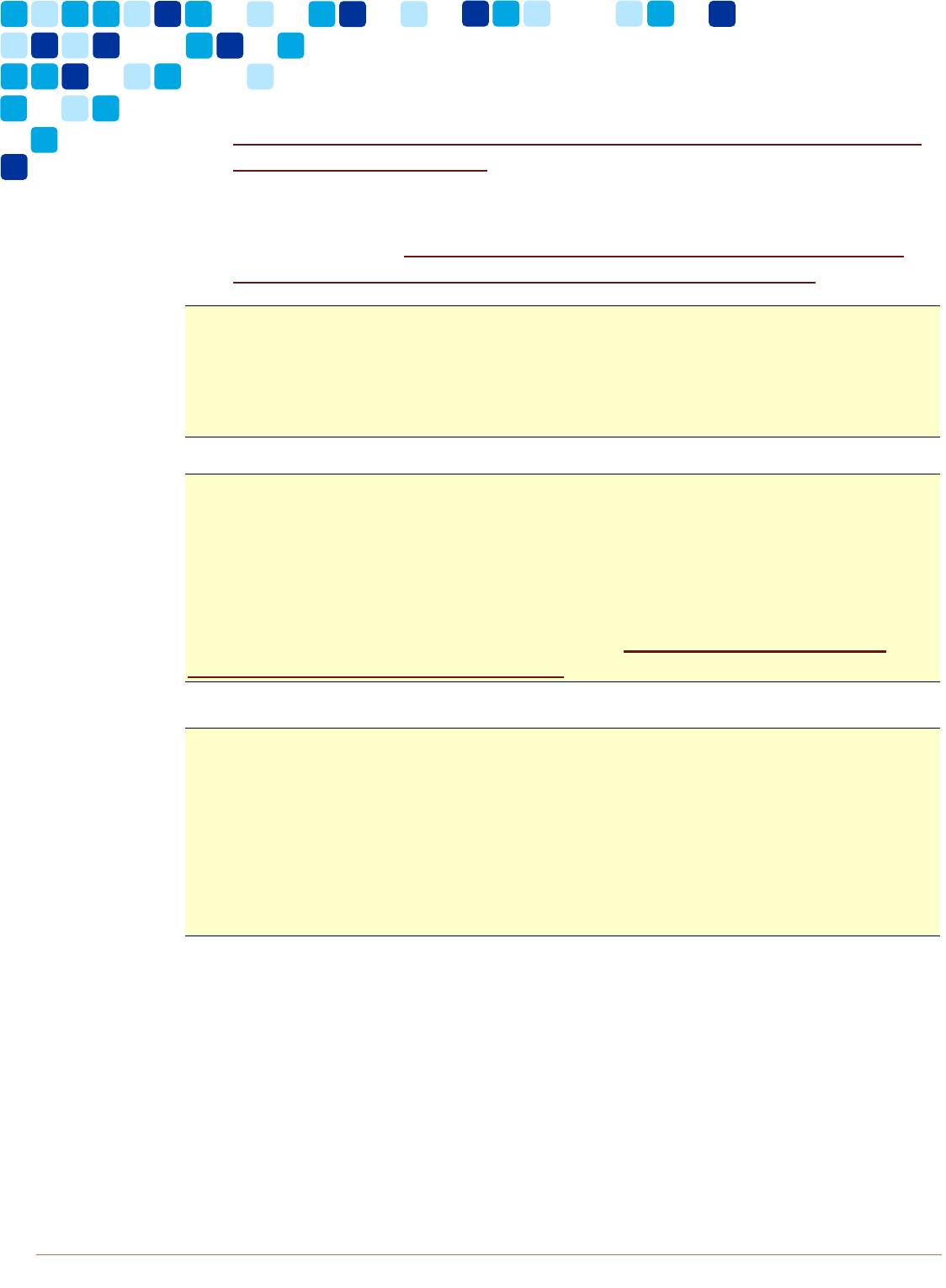
© 202
1 Cisco – CTG TME Collaboration Transitions – Clients: Transitioning from Jabber to Webex PAGE 46
Transition
https://help.webex.com/en-us/nmm9pzdb/Synchronize-Okta-Users-into-
Cisco-Webex-Control-Hub.
For more details on provisioning users in Webex via CSV files, refer to the
Add Multiple Users in Cisco Webex Control Hub with the CSV Template
article available at https://help.webex.com/en-us/nlkiw8e/Add-Multiple-
Users-in-Cisco-Webex-Control-Hub-with-the-CSV-Template.
Note: If Directory Connector is enabled for the Webex Organization, users can
only be added or removed based on AD adds/removes. User configurations can
be updated via another means while Directory Connector is enabled. e.g., Users
can be added to Webex via Directory Connector and their configurations may be
updated via CSV file.
Note: Once users are added to Control Hub, they will receive an automated
email welcoming them to their Webex account with a link to get started. This
email can be deactivated if users should not receive this email. SSO must be
enabled for the Webex Organization to deactivate this welcome email.
For more details on suppressing the automated welcome email refer to the
Suppress Automated Emails article available at https://help.webex.com/en-
us/nqj88gt/Suppress-Automated-Emails.
Note: The Webex Common Identity (CI) service provides directory services to
the Webex App. For example, when a user performs a contact search in the
Webex App, the search will be performed against CI. The Webex App will not
search directly against LDAP Directory or Unified CM UDS services. For this
reason, it is very important to sync all users in the organization to Webex, if all
users should be searchable from the Webex App. It is also important to ensure
relevant phone numbers are synchronized to Control Hub, to successfully deploy
Unified CM calling with the Webex App.
vi.
Integrate Calendar
Calendar integration is an important part of a successful migration to the Webex
App. Webex calendar integration is known as Hybrid Calendar Service. This
integration is not mandatory but highly recommended to enable calendar
services within the Webex App.
Hybrid Calendar Service enables the following in the Webex App:
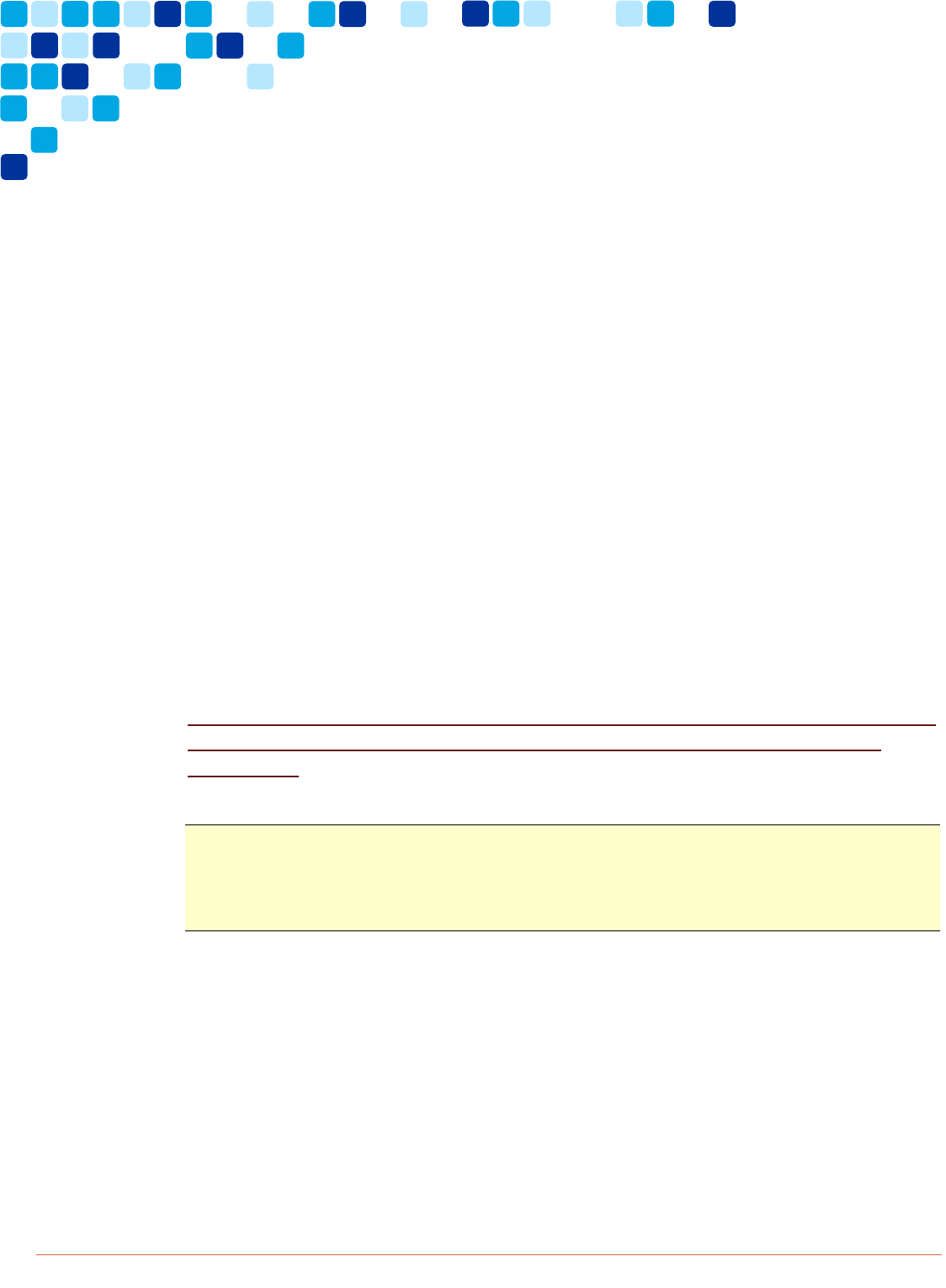
© 202
1 Cisco – CTG TME Collaboration Transitions – Clients: Transitioning from Jabber to Webex PAGE 47
Transition
Ability to view calendar from the Webex App.
Easy meeting scheduling from the Webex App.
One Button to Push (OBTP) meeting join experience.
Hybrid Calendar also enables calendar integration for personal and room video
systems deployed in the organization.
Hybrid Calendar Service supports the following calendar services
Office 365
Google Calendar
Microsoft Exchange (on-premises)
Since Office 365 and Google are cloud-based calendar sources, Webex allows
for a cloud-to-cloud integration (that is, no on-premises infrastructure setup is
required). Enabling Webex Hybrid Calendar Service with Microsoft Exchange
(on- premises) requires deployment of Expressway nodes running the Hybrid
Calendar Service.
For more details on deploying Webex Hybrid Calendar Service refer to the
Deployment Guide for Cisco Webex Hybrid Calendar Service available at
https://www.cisco.com/c/en/us/td/docs/voice_ip_comm/cloudCollaboration/spa
rk/hybridservices/calendarservice/cmgt_b_deploy-spark-hybrid-calendar-
service.html.
Note: If Hybrid Calendar Service is not deployed for the organization, calendar
and scheduling services within the Webex App will be limited. Users will not have
a consistent view of their calendar within the Webex App across desktop and
mobile. Meeting scheduling will also have limited functionality.
2. Messaging: Understand messaging options
This step focuses on the migration of the messaging service. Jabber messaging
service is provided by on-premises Unified CM IM&P server nodes. Webex App
messaging is provided by the Webex platform.
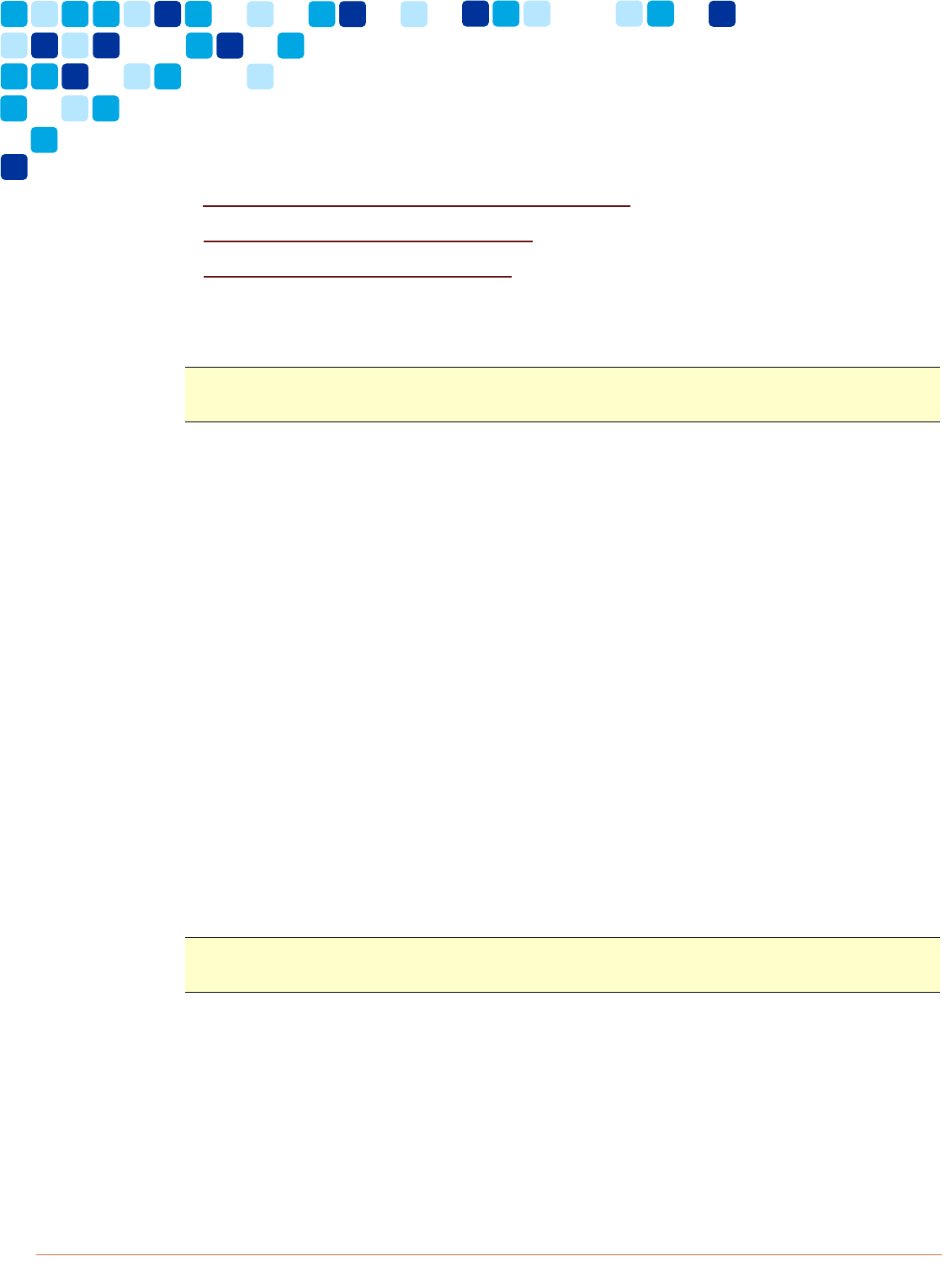
© 202
1 Cisco – CTG TME Collaboration Transitions – Clients: Transitioning from Jabber to Webex PAGE 48
Transition
The following are the sub-steps involved in preparing for Webex messaging with
the Webex App:
i. Understand Messaging and File Sharing Policy
ii. Consider External Messaging Policy
iii. Enable Hybrid Messaging Service
i.
Understand Messaging and File Sharing Policy
Note: All messaging and file sharing policy with Webex messaging is managed
using Webex Control Hub.
Message Retention
Webex messaging is persistent. This means that messages and files sent using
the Webex App are written to storage in a Webex Datacenter and will be
available within 1:1 and groups spaces within the Webex App for a defined
period. This period is known as the retention period.
The Control Hub administrator defines the retention period for all Webex App
users within the organization. The retention period defaults to ‘Indefinitely’
meaning messages will never be deleted and will always be available within the
Webex App. The retention period can be set to a defined period in units of
months. The shortest allowed retention period that can be set in Control Hub is
one month; however, this can be set to be less than one month on request to
Cisco.
Messages and files will be deleted from Webex once the retention period has
expired. For example, let’s assume an organization has specified a retention
period of one year. If a user sends a message on January 1, 2021, that message
would be deleted from Webex on January 1, 2022.
Note: Message deletion at the end of a retention period is permanent. Messages
cannot be retrieved once they are deleted.
It is recommended that the retention period be set for as long as possible but in
accordance with any specific retention policies an organization may have. One of
the benefits of Webex messaging is the fact that messages and files are
persistent. Setting a short retention period will diminish this benefit and will result
in a less than ideal user experience.

© 202
1 Cisco – CTG TME Collaboration Transitions – Clients: Transitioning from Jabber to Webex PAGE 49
Transition
For specific instructions on setting the Webex Organization retention policy refer
to the Set the Retention Policy for Your Organization article available at
https://help.webex.com/en-us/nqmr56k/Set-the-Retention-Policy-for-Your-
Organization.
Messaging Compliance and Data Loss Prevention
Messaging compliance and Data Loss Prevention (DLP) is a broad topic. This
section refers specifically to replicating a similar messaging compliance policy
with the Webex App and Webex messaging that was available with Jabber and
Unified CM IM&P.
Unified CM IM&P supports several compliance methods including:
Message logging
Message policy management
Ethical walls
Unified CM IM&P supports the above compliance methods via integration with
third-party compliance engines.
Webex messaging supports similar integrations with Cisco and third-party Cloud
Access Security Brokers (CASB) like Cisco Cloudlock, Actiance, and Verba.
These integrations allow organizations to enable compliance policies such as:
Messaging and files policy violation management
Message archival
eDiscovery
Legal hold
Ethical walls
Space classification
Some compliance services will require that the role of Compliance Officer exists
for the Webex Organization. This role can be enabled for a user by a Control Hub
administrator.
For more information on integrating Webex with your compliance and DLP
solution, refer to the Control Hub (Compliance) Data Sheet available at

© 202
1 Cisco – CTG TME Collaboration Transitions – Clients: Transitioning from Jabber to Webex PAGE 50
Transition
https://www.cisco.com/c/en/us/products/collateral/conferencing/webex-
control-hub/datasheet-c78-740772.html.
Webex also offers some native messaging policy management tools. Webex
Organization administrators can set the following restrictions in Control Hub:
Restrict file sharing to your network only
Block file preview per platform
Block file sharing per platform
Disable GIPHY integration
Disable link preview
ii.
Consider External Messaging Policy
By default, Webex allows for native external messaging such that Webex App
users in Webex Organization example.com can message Webex App users from
other Webex Organizations.
External messaging can be restricted by the administrator in Control Hub in one
of the following ways:
Block external messaging
Restrict external messaging to administrator specified allow list
The administrator can add domains to the allow list directly in Control Hub.
For more details on restricting external messaging, refer to the Block External
Users in Webex Spaces for Your Organization article available at
https://help.webex.com/en-us/agrt8/Block-External-Users-in-Webex-Spaces-
for-Your-Organization.
In addition to native external messaging, Webex allows organizations to
configure the following external messaging solutions:
XMPP Federation
SIP Federation
Jabber with Unified CM IM&P supports both interdomain XMPP and SIP
federation. Organizations that migrate to the Webex App can maintain these
federations with the Webex App and Webex messaging.
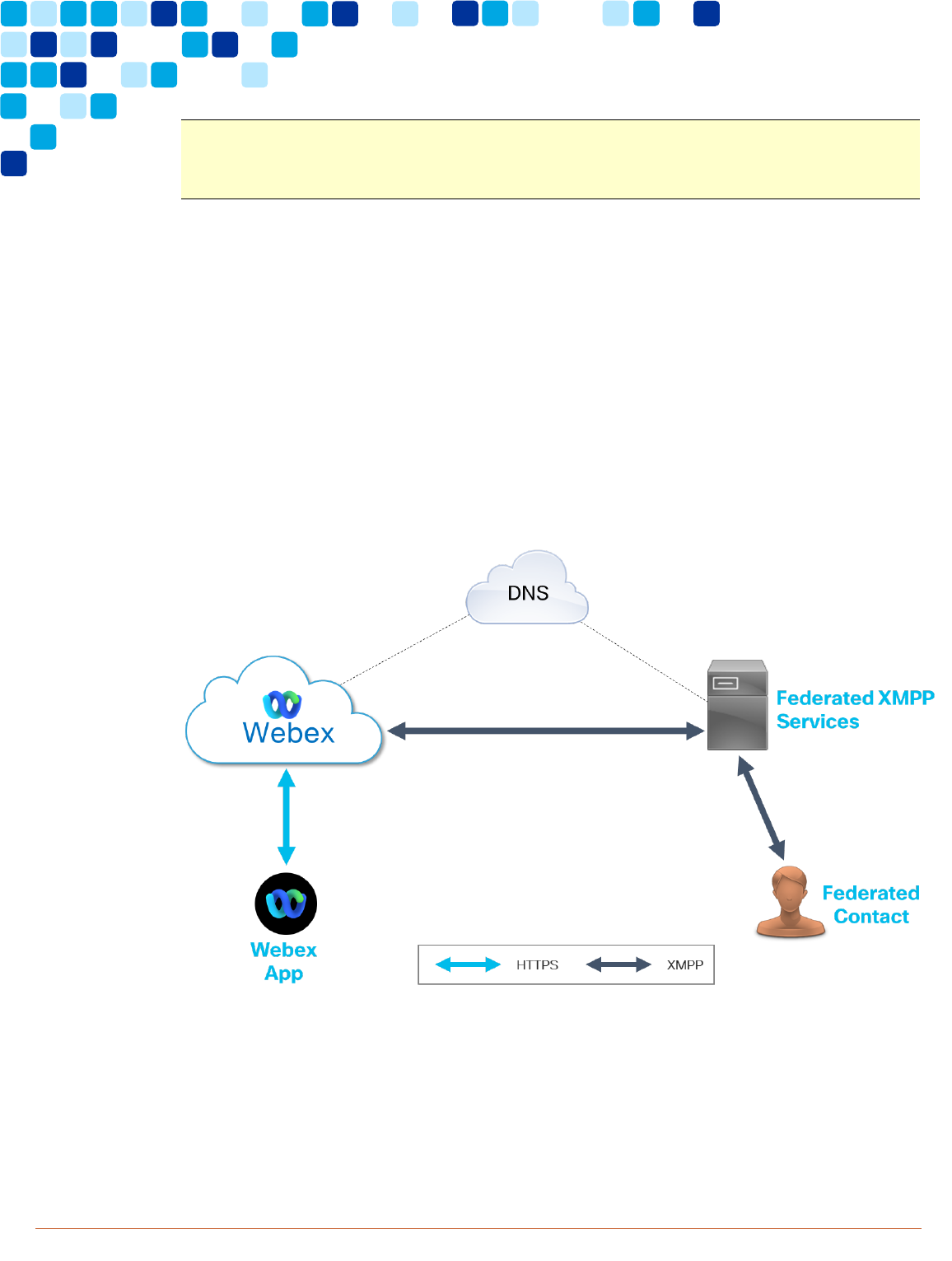
© 202
1 Cisco – CTG TME Collaboration Transitions – Clients: Transitioning from Jabber to Webex PAGE 51
Transition
Note: Only interdomain federation is supported. Specifically, the Webex
Organization must have a different domain name than the federated SIP or XMPP
service.
XMPP Federation
Webex XMPP federation offers support for 1:1 messaging between users using
the Webex App and users using an XMPP messaging service (for example,
Jabber with Unified CM IM&P).
Webex XMPP federation also offers support for 1:1 messaging between users
using the Webex App and users using a SIP messaging service (for example,
Skype for Business).
Figure 25 details the architecture for Webex XMPP federation.
Figure 24. Webex XMPP Federation Architecture
Webex will advertise XMPP capabilities via a public DNS SRV record: xmpp-
server._tcp.domain.com. Likewise, Webex will discover third party XMPP
services via their public DNS SRV record.
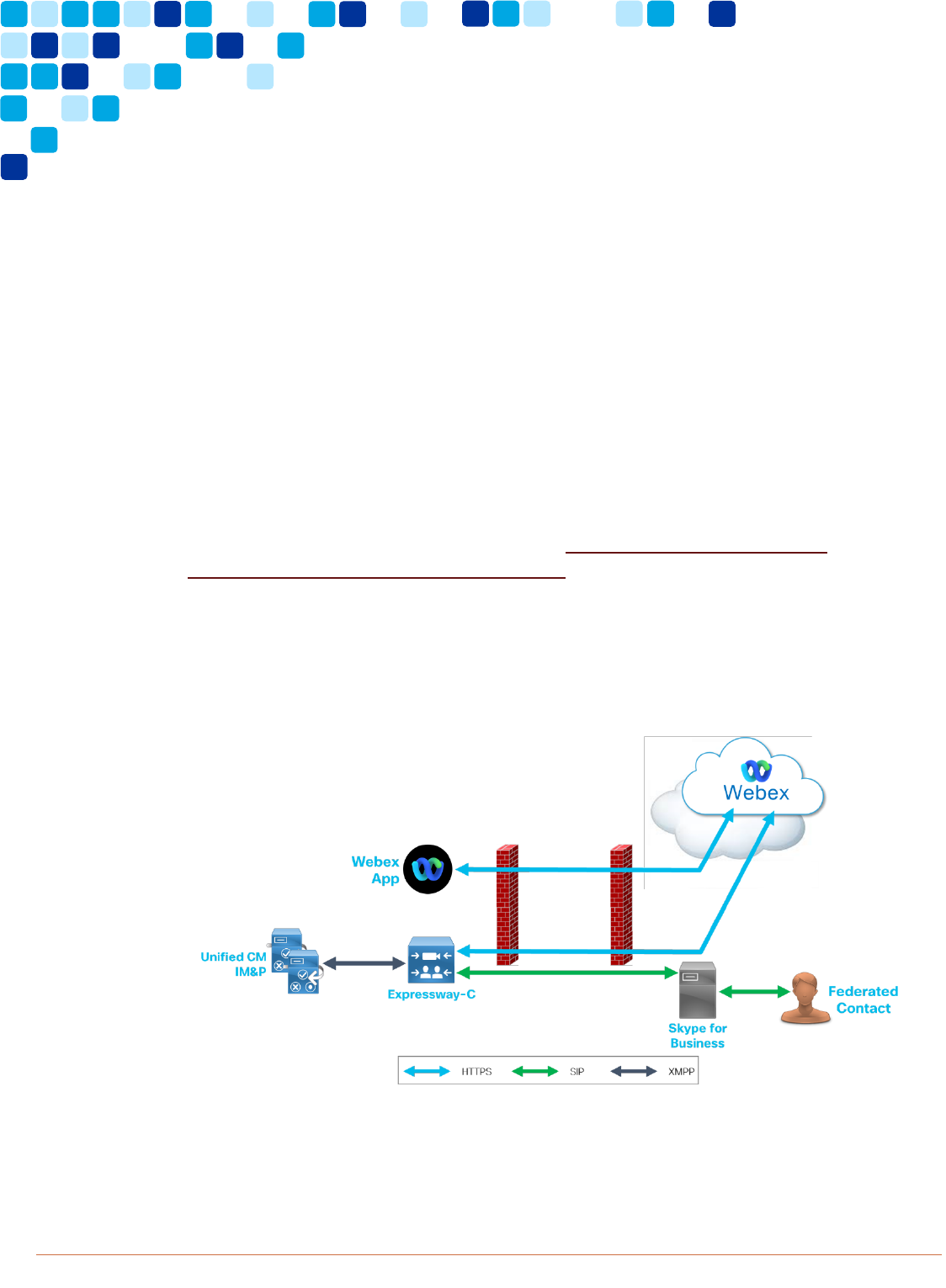
© 202
1 Cisco – CTG TME Collaboration Transitions – Clients: Transitioning from Jabber to Webex PAGE 52
Transition
If XMPP federation is currently configured for Jabber, the xmpp-server DNS SRV
record will need to be updated to point to Webex messaging service instead of
Unified CM IM&P/Expressway. This change should be made when the
organization is ready to migrate XMPP federation capabilities from Jabber to the
Webex App.
XMPP federation can be enabled for a single domain per Webex organization. If
there are multiple presence domains configured for the existing Unified CM IM&P
deployment (flexible JID with multiple email domains), consider consolidating to
a single domain prior to moving to Webex XMPP federation.
The Allow List configured for Webex external messaging also applies to XMPP
federation. Therefore, restricting external messaging to specific domains will not
only restrict Webex native messaging, but it will also restrict XMPP federation.
For more details on configuring XMPP federation for Webex, refer to the XMPP
Federation for Webex article available at https://help.webex.com/en-
us/05i99o/XMPP-Federation-for-Webex.
SIP Federation
Figure 26 details the architecture for Webex SIP federation.
Figure 25. Webex SIP Federation Architecture
Webex SIP federation is based on utilizing existing Unified CM IM&P/Expressway
SIP federation to Skype for Business in conjunction with Hybrid Messaging

© 202
1 Cisco – CTG TME Collaboration Transitions – Clients: Transitioning from Jabber to Webex PAGE 53
Transition
Service. Hybrid Messaging Services allows for messaging interop between
Webex, and Unified CM IM&P via Expressway-C. Hybrid Messaging Service will
be discussed in the next sub-step.
SIP federation is enabled in Control Hub for the Webex Organization. Messages
are routed from the Webex messaging service to Expressway-C (Hybrid
Messaging Service), and then onto Unified CM IM&P. Assuming Unified CM IM&P
is already enabled for SIP federation, it routes the message to the SIP broker
service on Expressway-C. Expressway-C in turn routes the message onto Skype
for Business.
Note: Skype for Business domain must be different from the Webex Organization
and Unified IM&P domains.
Expressway-C provides Hybrid Messaging and SIP broker services for this
federation. Both services can run on the same Expressway-C node, or they can
be split between different nodes.
Enabling SIP federation in Control Hub will not affect existing Jabber and Unified
CM IM&P SIP federation.
For more details on enabling SIP federation for the Webex App refer to the SIP
or XMPP Interdomain Federation for Webex article available at
https://help.webex.com/en-us/n8gtpu7/SIP-or-XMPP-Interdomain-Federation-
for-Webex.
Additional Considerations
The following are important messaging considerations that will not be covered in
detail in this document since they are not transition impacting:
Enterprise Content Management (ECM) provides integration between
Webex and existing Content Management solutions such as SharePoint
Online, Outlook, Google Drive, and Box. Users can share files stored on the
organizations content management solution direct from the Webex App.
See Enterprise Content Management For more information on ECM with
Webex refer to the Enterprise Content Management in Cisco Webex Control
Hub article available at https://help.webex.com/en-us/nuvy9lb/Enterprise-
Content-Management-in-Cisco-Webex-Control-Hub.

© 202
1 Cisco – CTG TME Collaboration Transitions – Clients: Transitioning from Jabber to Webex PAGE 54
Transition
The Webex App supports end-to-end encryption of messages. This means
that the Webex App will first encrypt a message using a key and then will
send the message to the Webex service. The Webex messaging service
stores the encrypted message. Message recipients will download the
encrypted messages from Webex and use the encryption key to decrypt the
message. The key used to encrypt/decrypt message content is retrieved
from a key management service provide by the Webex platform.
Optionally, organizations can host their own key management service. This
is known as Hybrid Data Security. For more details on Hybrid Data Security,
refer to the Deployment Guide for Cisco Webex Hybrid Data Security
available at
https://www.cisco.com/c/en/us/td/docs/voice_ip_comm/cloudCollaboratio
n/spark/hybridservices/datasecurity/cmgt_b_hybrid-data-security.html.
iii.
Enable Hybrid Messaging Service
Hybrid Messaging Service is a solution that allows Webex App users to send and
receive messages with Jabber users connected to Unified CM IM&P. Hybrid
Messaging is an optional step in transitioning from Jabber to the Webex App.
Hybrid Messaging should be deployed if users will be migrated from Jabber to
the Webex App in groups over a period. During the migration period, Hybrid
Messaging will ensure messaging between Jabber and Webex App users will be
available.
Hybrid Messaging Service supports 1:1 messaging between Jabber and Webex
App users. There is limited support for presence and file transfer across Hybrid
Messaging Service is not supported.
Hybrid Messaging Service runs as a connector service on Cisco Expressway.
Figure 27 below details the high-level architecture for Hybrid Messaging Service.
Figure 26. Hybrid Messaging Architecture
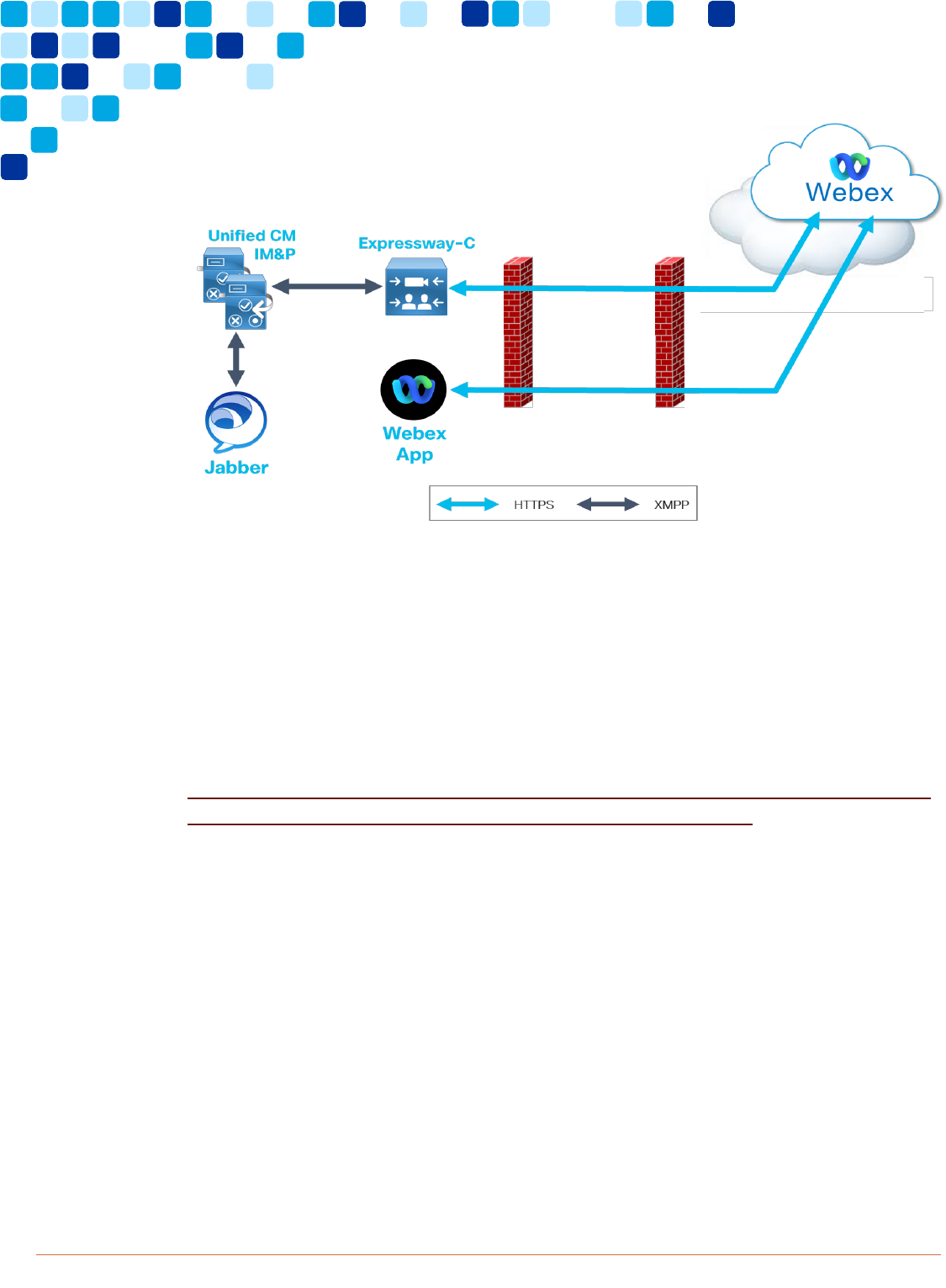
© 202
1 Cisco – CTG TME Collaboration Transitions – Clients: Transitioning from Jabber to Webex PAGE 55
Transition
The Hybrid Messaging Service runs as a connector on Expressway-C, providing
a bridge between Unified CM IM&P and Webex messaging. As a best practice
deploy Hybrid Messaging enabled Expressway clusters at a 1:1 ratio with Unified
CM IM&P clusters. For organizations who have many Unified CM IM&P clusters,
consider transitioning to Centralized Unified CM IM&P before deploying Hybrid
Messaging Service. For more information on transitioning between distributed
multi-cluster Unified CM IM&P and centralized Unified CM IM&P refer to the
Transitioning to Centralized IM and Presence Service (IM&P) Deployment Guide
available at
https://www.cisco.com/c/dam/en/us/td/docs/solutions/PA/mcp/DEPLOYMENT_
MESSAGING-UnifiedCM_IMP_Distributed_to_Centralized.pdf.
Unified CM IM&P uses the Jabber ID (JID) to route messages to users and
systems. Webex messaging service uses email address to route messages to
users and systems. JID and email address do not need to match to deploy
Hybrid Messaging Service. If Unified CM IM&P is not enabled for Flexible JID
mode, the JID will be formed as userID@xmppdomain. This may differ from the
user’s email address. Unified CM syncs the email address attribute from the
corporate directory during LDAP synchronization and maps this attribute to the
Directory URI field. Unified CM IM&P then synchronizes this information from
Unified CM. A user will have both a JID and a Directory URI, these may be
different values. Hybrid Messaging Service running on Expressway will sync the
JID and Directory URI from Unified CM IM&P at regular intervals. Hybrid
Messaging Service will maintain the JID to Directory URI (Directory URI = email

© 202
1 Cisco – CTG TME Collaboration Transitions – Clients: Transitioning from Jabber to Webex PAGE 56
Transition
address) mapping to route messages from Jabber users (JID) to Webex App
users (email). Ensure Unified CM Directory URI attribute maps to the email
address that is used to create the users Webex App account.
Users must be enabled for both Unified CM IM&P and Webex messaging to be
enabled for Hybrid Messaging. As groups of users are migrated to the Webex
App, they should be enabled for Hybrid Messaging. Users are enabled for Hybrid
Messaging in the following ways:
Manually via Control Hub
Licensing Template
CSV file
The CSV file method provides the most flexibility for enabling users for Hybrid
Messaging in bulk as it involves changing users licensing template. CSV file
method can be used to update user configuration even if Directory Connector is
enabled.
As more groups of users are migrated to the Webex App, the CSV file method
can be used to enable those users for Hybrid Messaging Service.
When all users have been migrated from Jabber to the Webex App, Hybrid
Messaging Service can be decommissioned (unless Webex messaging SIP
federation is deployed).
3. Calling: Prepare Unified CM on-premises calling for Webex
This set of steps focuses on the migration of the calling service from Jabber to the
Webex App. Webex App can connect to different calling services including:
Unified CM (on-premises)
UCM Cloud
Hosted Collaboration Solution (HCS)
Webex Calling
This guide focuses on the transition from Jabber with Unified CM (on-premises) to
the Webex App while maintaining Unified CM calling (hybrid).
The following steps need to be taken when undertaking the calling workload
transition:
i. Webex Control Hub Calling Settings

© 202
1 Cisco – CTG TME Collaboration Transitions – Clients: Transitioning from Jabber to Webex PAGE 57
Transition
ii. Validate DNS
iii. Validate Unified CM and Expressway Settings
iv. Contact Center Considerations
i.
Webex Control Hub Calling Settings
The following settings in Control Hub should be considered when enabling
Webex App users for Unified CM calling:
Ensure Phone Number Syncing
Licensing Assignment
UC Manager Profiles
Client Calling Settings
Ensure Phone Number Syncing
Phone numbers must be synced to Control Hub to successfully deploy the
Webex App with Unified CM calling. This should have been completed when
provisioning users the first time.
UC Manager Profiles
When the Webex App starts up, it will download the Unified CM enablement
from Webex Control Hub and begin service discovery. The Webex App will send
DNS SRV queries to discover Unified CM or Expressway-E (MRA). The domain
used by the Webex App when sending the DNS SRV queries will be the domain
the user used to sign in to the Webex App (the Webex Organization domain).
The domain used to discover Unified CM/MRA is referred to as the Voice
Services Domain.
For organizations who want to use a different Voice Services Domain, or for
organizations who want to use multiple Voice Services Domains, this can be
configured using Webex Control Hub UC Manager Profiles.
In Control Hub, configure a UC Manager Profile for every Voice Services Domain
in your organization. The UC Manager Profile can be assigned in bulk to users
using the CSV file user provisioning method. Export the CSV file from Control
Hub, modify the UC Manager Profile column as needed, and import the CSV file
back into Control Hub.
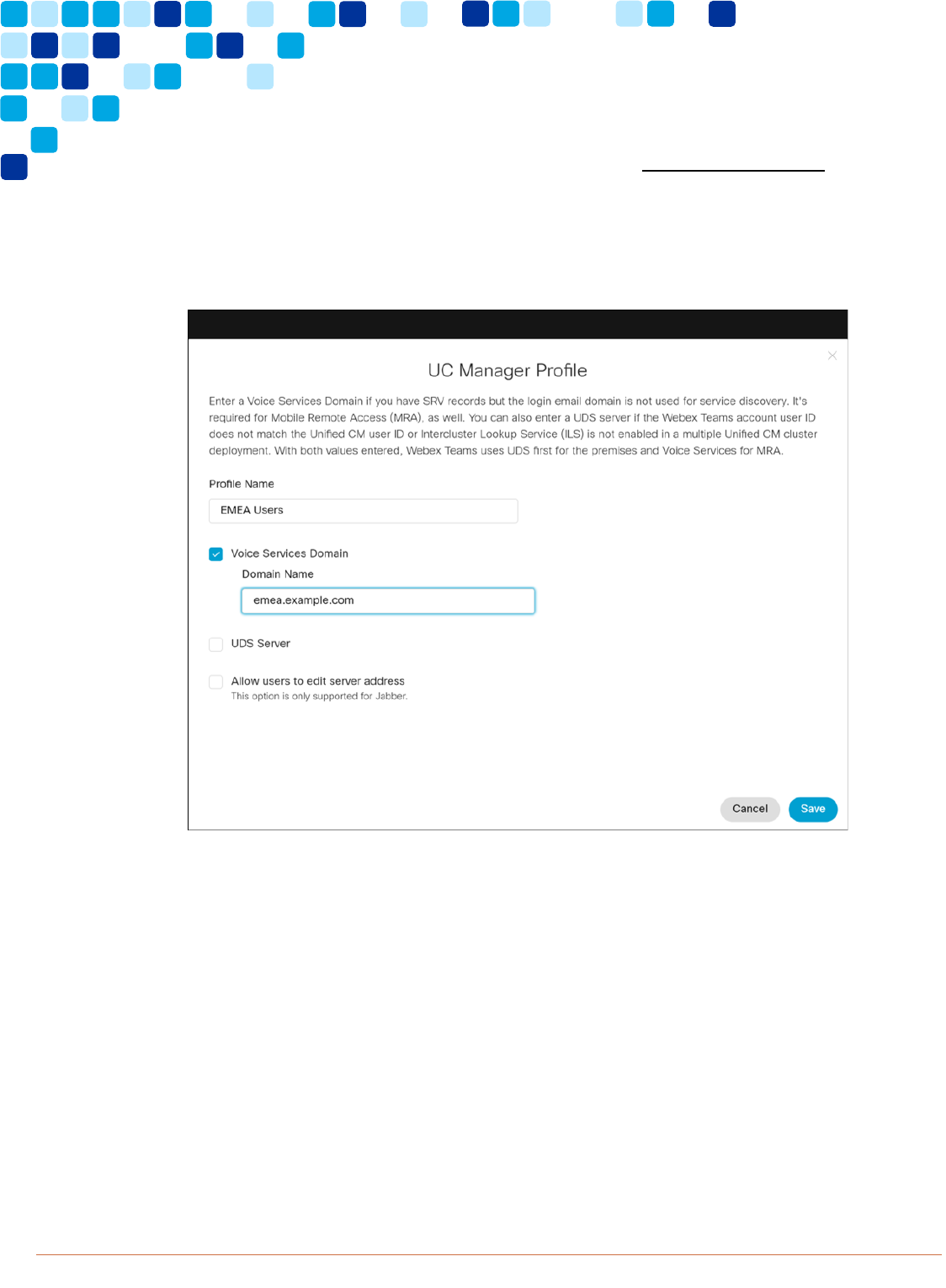
© 202
1 Cisco – CTG TME Collaboration Transitions – Clients: Transitioning from Jabber to Webex PAGE 58
Transition
Figure 29 shows a UC Manager Profile with Voice Services Domain set. In this
example the users sign into the Webex App with user@example.com. This
organization has Voice Services Domains per region. This UC Manager Profile is
enabled for all EMEA based users. These users’ Webex App will perform Unified
CM/MRA discovery using emea.example.com.
Figure 27. Webex Control Hub: Voice Services Domain
Client Calling Settings
There are several Webex App calling experience settings that can be configured
in Control Hub.
Figure 30 details the Call Settings option. Call Settings define what happens
when a Webex user clicks the Audio Call or Video Call buttons in a 1:1 space,
contact card, or from the search bar. The options set under Available Call
Options will be displayed in a drop-down menu. The options shown under
Hidden Call Options will not be displayed. The user can then select the
appropriate available calling option to place the call.
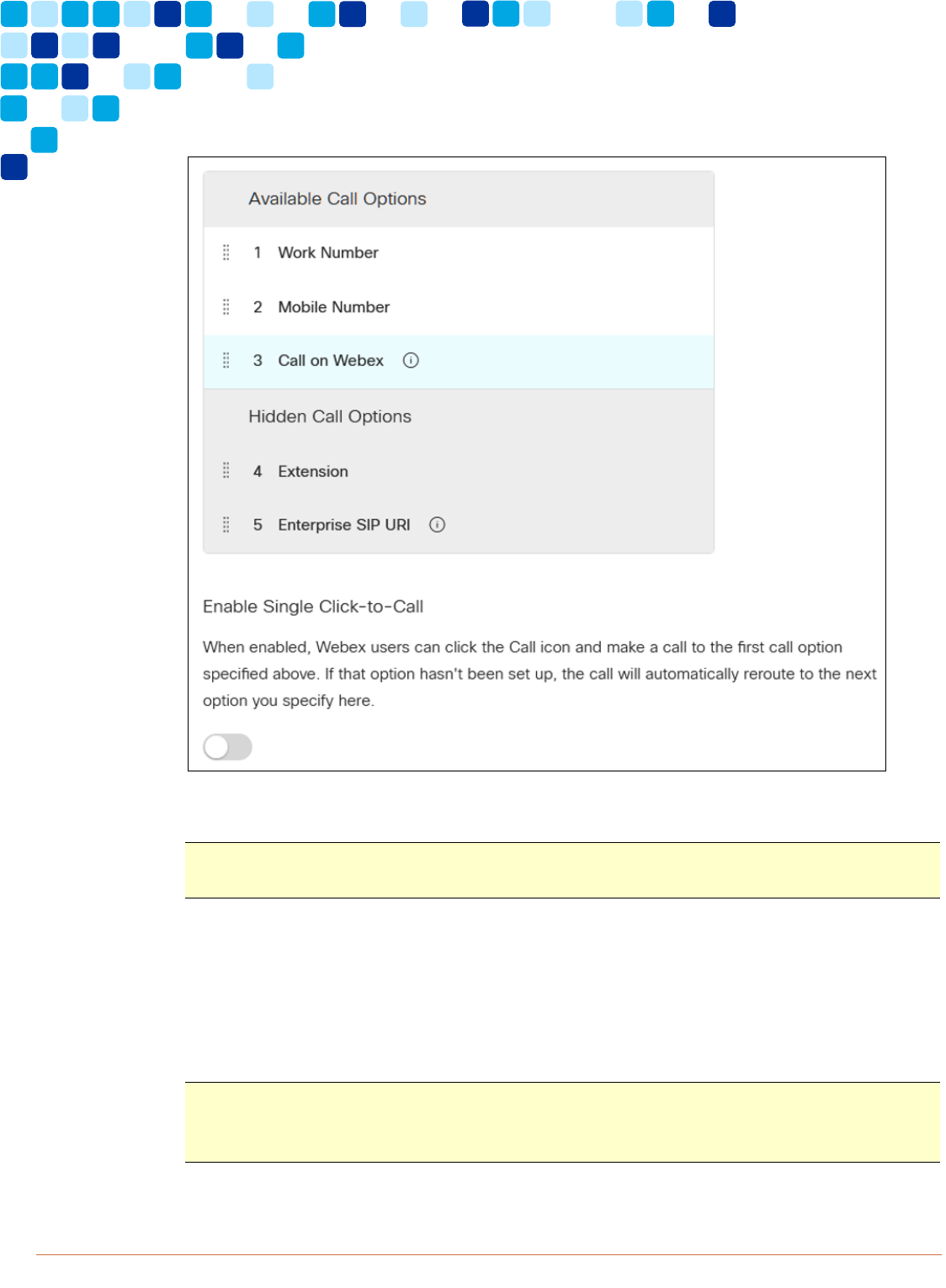
© 202
1 Cisco – CTG TME Collaboration Transitions – Clients: Transitioning from Jabber to Webex PAGE 59
Transition
Figure 28. Webex Control Hub: Call Settings for Webex with Unified CM
The calling options shown in Figure 30 can be set under Calling > Client Settings
Note: Changes made to Client Settings will apply to all Webex App users in the
organization.
“Call on Webex” refers to the native calling service available when using the
Webex App. If a user selects this option, the call will not be routed via Unified
CM, it will be routed via the native Webex calling service. If you do not want
users to have native Webex calling capabilities for 1:1 call, this option should be
moved down to the Hidden Call Options section.
Note: Users will still be able be able to make native Webex calls to spaces and
will still be able to receive incoming native Webex calls even when “Call on
Webex” is hidden.
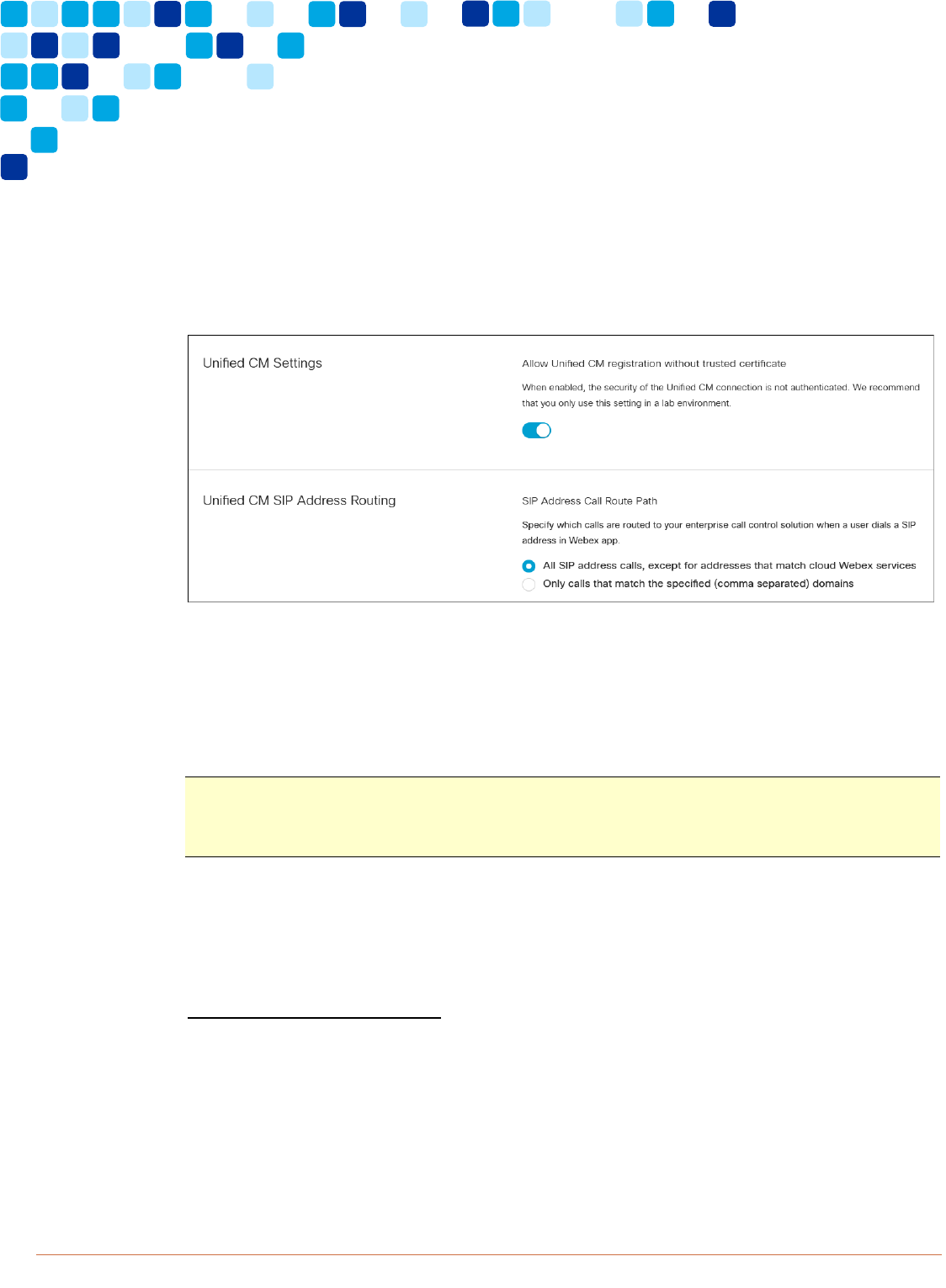
© 202
1 Cisco – CTG TME Collaboration Transitions – Clients: Transitioning from Jabber to Webex PAGE 60
Transition
By toggling “Enable Single Click-to-Call” users will not be presented with the
drop down to select calling option. The Webex App will simply call the first
available option under Available Call Options.
As shown in Figure 31, additional Control Hub Client Setting configuration
options include Unified CM settings and SIP address routing
Figure 29. Webex Control Hub: Unified CM Settings and SIP Address Routing
When enabling the Unified CM Settings toggle, the Webex App will ignore invalid
certificates presented by Unified CM server nodes. The Webex App will continue
with Unified CM connection even if the certificate presented is invalid. The best
practice recommendation is to only enable this toggle for trial organizations or
while performing lab testing.
Note: If this toggle is not set, the Webex App will discontinue connection to
Unified CM if presented with an invalid Tomcat certificate. Unlike with Jabber,
the user will not be prompted to accept an invalid server certificate.
The Unified CM SIP Address Routing option allow the administration to set the
Webex App behavior when a user places a call to a SIP URI. The Webex App will
always make a native Webex calling service call when a user dials a SIP URI
ending with *.webex.com – for example, a user makes a call to
[email protected]. This call will not be routed via Unified CM, it will be
made by the native Webex calling service.
By default, SIP URI calls to all other domains will be routed via Unified CM. The
administrator can define a list of domains to route SIP URI calls via Unified CM by
selecting “Only calls that match the specified (comma separated) domains” and

© 202
1 Cisco – CTG TME Collaboration Transitions – Clients: Transitioning from Jabber to Webex PAGE 61
Transition
then specifying the domains in the text box. All other calls will be made using
native Webex calling service.
Note: All calls made by the user to a phone number will be routed via Unified
CM.
ii.
Validate DNS
The next step is to validate DNS configuration. It is assumed that DNS SRV
records are already created for existing the Jabber deployment. Here you are
simply verifying this configuration.
While on the corporate network, validate that the Unified CM record can be
discovered for all Voice Services Domains. For example, _cisco-
uds._tcp.example.com. DNS should return Unified CM node A records as
configured with port 8443.
While outside the corporate network, validate that the Expressway-E record can
be discovered for all Voice Services Domains. For example: _collab-
edge._tls.example.com. DNS should return the Expressway-E node A records as
configured with port 8443.
iii.
Validate Unified CM and Expressway Settings
In general, the Webex App will use the same Unified CM and Expressway
configurations in place with the existing Jabber deployment. The configuration
aspects that are of specific interest for Webex include:
Users and Authentication
OAuth Settings
Service Profiles
Jabber-config
Devices
Device Security Profile
Quality of Service
Push Notifications

© 202
1 Cisco – CTG TME Collaboration Transitions – Clients: Transitioning from Jabber to Webex PAGE 62
Transition
Users and Authentication
User accounts should already exist on Unified CM for the existing Jabber
deployment. The Webex App will discover the user in Unified CM as shown in
the following example:
When alice@example.com signs into the Webex App, the application
attempts to discover “alice” and “al[email protected]” during Unified CM
home-cluster discovery.
SSO is highly recommended but not mandatory for Webex with Unified CM
calling. SSO should be configured for Unified CM and Expressway, using the
same IdP as used for SSO enablement of Webex. If SSO is enabled, Webex App
users on Windows and Mac will only need to authenticate once at startup and
will gain access to both Webex and Unified CM services. Users on Android and
iOS will have to authenticate separately for Unified CM services even if SSO is
enabled. This will be resolved in a future release of Unified CM.
If SSO is not enabled, users will need must manually authenticate to Unified CM
after logging into the Webex App.
OAuth
It is a best practice to enable OAuth refresh token login flow on Unified CM and
Expressway. The Webex App will store and utilize the OAuth refresh token in the
same manner as Jabber.
The OAuth refresh token can be presented to Unified CM/Expressway to
authorize a user (gain access to Access token) without the need to re-
authenticate every session
The OAuth refresh token has a lifetime defined by Unified CM (default is 60
days)
Webex App will delete the OAuth refresh token on sign out.
If OAuth Refresh Token Flow is not enabled on Unified CM, the Webex App will
need to authenticate with Unified CM each time the user signs in.
Note: If SSO and OAuth Refresh Token Flow are not enabled on Unified CM, the
Webex App can encrypt and store userID and password locally, so users do not
need to manually reauthenticate each login.

© 202
1 Cisco – CTG TME Collaboration Transitions – Clients: Transitioning from Jabber to Webex PAGE 63
Transition
If OAuth Refresh Token Flow is not enabled, secure SIP and media (for Unified
CM calls) is not possible with the Webex App.
For more details on configuring OAuth Refresh flow in Unified CM and
Expressway refer to the Deploying OAuth with Cisco Collaboration Solution
Release 12.0 whitepaper available at
https://www.cisco.com/c/dam/en/us/td/docs/voice_ip_comm/jabber/11_9/Unifi
ed-CM-OAuth-Whitepaper-v17-FINAL.pdf.
Service Profiles
The Webex App relies on Unified CM Service Profiles to enable the following
services:
CTI (Desk phone Control Mode)
The CTI profile defines the Unified CM server(s) within the user’s cluster the
Webex App should connect to for CTI services when the running in desk
phone control mode.
Voicemail (Unity Connection)
The Voicemail profile defines the Unity Connection server(s) that the Webex
App should connect to for visual voicemail services. If SSO is enabled for
Unified CM, it must also be enabled for Unity Connection.
If Unified CM and Unity Connection are not enabled for SSO, within the
Voicemail Profile set the Credentials source for voicemail service
setting to
Unified CM – IM and Presence.
The Webex App uses the Unified CM credentials to gain access to
voicemail services.
The following profiles can be deleted as the Webex App will not read them:
Conferencing profile
MailStore Profile
Directory Profile
IM and Presence Profile
Jabber-config
The jabber-config information will also be read by the Webex App. The jabber-
config can be accessed from the Service Profile in Unified CM 12.5 and above,
or from the jabber-config.xml file on Unified CM 11.5 and earlier.

© 202
1 Cisco – CTG TME Collaboration Transitions – Clients: Transitioning from Jabber to Webex PAGE 64
Transition
The Webex App will only read a subset of available Jabber parameters from the
jabber-config file. The jabber-config file parameters read by the Webex App are
specific to advanced calling functions such as Pickup Groups and Multiline.
Webex App configurations for other services are managed from Control Hub.
The existing jabber-config files/profiles can be minimized to the parameters
relevant to the Webex App.
For a list of jabber-config parameters read by the Webex App refer to the
Deployment Guide for Calling in Webex (Unified CM) available at
https://www.cisco.com/c/en/us/td/docs/voice_ip_comm/cloudCollaboration/wb
xt/ucmcalling/unified-cm-wbx-teams-deployment-guide.html.
The Webex App can read the jabber-config from any of the following:
Jabber Client Configuration (jabber-config.xml) Profile
Jabber-config.xml file
Jabber-config-<name>.xml file as defined in the Cisco Support Field on the
Device configuration page
Devices
The Webex App will utilize the same Unified CM device types for softphone
mode as Jabber. It is recommended to enable each user for all device types. If a
user is enabled for Unified CM calling in the Webex App, they will be presented
with an error if the device type specific to their current platform is not available. It
is important to consider Unified CM device capacity when adding devices
to the system.
Device Security Profile
The Webex App does not support CAPF enrollment process to enable secure
Unified CM calling. Organizations who are using CAPF enrollment to enable
secure calling for Jabber, will need to migrate to SIP OAuth to enable secure
Unified CM calling for the Webex App. SIP OAuth is available with Unified CM
12.5 and above. OAuth Refresh Token Flow must be enabled on Unified CM
before enabling SIP OAuth.
Quality of Service (QoS)
The Webex App will mark packets with DSCP values for Unified CM calling, in
the same way that Jabber does. DSCP settings will be read from the Unified CM
Cluster Service Parameters by the Webex App running on Mac, iOS and Android.

© 202
1 Cisco – CTG TME Collaboration Transitions – Clients: Transitioning from Jabber to Webex PAGE 65
Transition
For Windows devices DSCP values cannot be set by the Webex App and should
be set via a Microsoft Group Policy.
Push Notifications
Enabling Push Notifications Services for Apple and Android devices is highly
recommended when deploying the Webex App. If Push Notifications are already
enabled for Jabber, there are no required changes when transitioning to the
Webex App.
For more details on all of the above settings, refer to the Deployment Guide for
Calling in Webex (Unified CM) available at
https://www.cisco.com/c/en/us/td/docs/voice_ip_comm/cloudCollaboration/wb
xt/ucmcalling/unified-cm-wbx-teams-deployment-guide.html.
iv.
Contact Center Considerations
Users who require access to advanced contact center calling features may need
to continue to utilize Jabber for calling services, until the Webex App supports
advanced contact center features. Webex already supports Unified CM calling
features that may be used in a contact center environment including Multiline,
Hunt Groups, Pickup Groups, and Built in Bridge. However, certain features are
only available in Jabber including:
Ad Hoc Call Recording
Silent Monitoring
Agent Greeting
Whisper Announcement
Supervisor Barge
Recording Tone
Zip Tone
If users require the features in the above list, those users can be enabled for the
Webex App with cross launch to Jabber for calling. This is a mode where Jabber
is cross launched when the user makes a call to a phone number or SIP URI from
the Webex App. Users enabled for this mode will have access to all the above
Jabber contact center calling features, while still using the Webex App as their
primary collaboration tool. It is suggested to only enable this mode for the
specific user groups who need access to contact center features.
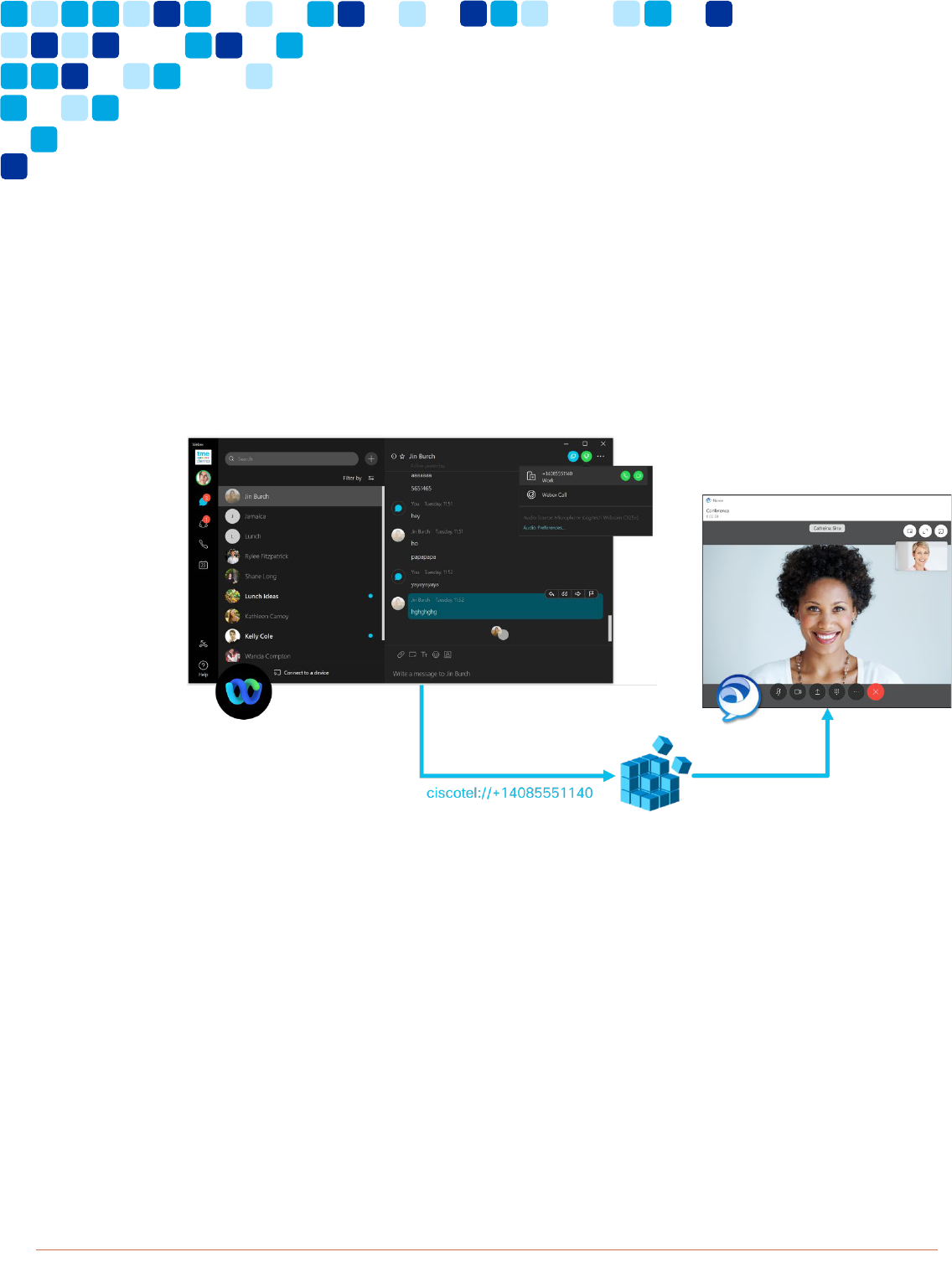
© 202
1 Cisco – CTG TME Collaboration Transitions – Clients: Transitioning from Jabber to Webex PAGE 66
Transition
The Webex App cross launches Jabber via the ciscotel:// protocol handler.
Jabber registers to the ciscotel protocol handler on Windows, Mac, iOS and
Android. When a user makes a call to a phone number or SIP URI, the Webex
App invokes ciscotel:// with the phone number/SIP URI appended. This ensures
the call is made using Jabber. The Webex App does not connect to Unified CM
in this deployment mode.
Figure 32 details a user making a call using the Webex App. The Webex App
invokes ciscotel:// with this phone number. Jabber will then call this number and
the conversation window will come to the foreground.
Figure 30. Webex Cross Launch to Jabber for Calling via ciscotel://
Incoming Unified CM calls will be received by Jabber.
To enable this mode for a user group, the following steps should be taken:
1. Set Webex App Calling Behavior to “Cisco Jabber app” for the user group.
2. Migrate user group to Jabber Phone-Only Mode.
3. Update jabber-config for user group.
Calling Behavior is defined in Control Hub. Calling Behavior should be set to
“Cisco Jabber app” for user group who require advanced contact center calling
features. This can be set on a per user basis in Control Hub or can be set in bulk
using CSV file provisioning method discussed earlier in this document. If using

© 202
1 Cisco – CTG TME Collaboration Transitions – Clients: Transitioning from Jabber to Webex PAGE 67
Transition
the CSV file provisioning method to enable Jabber cross launch, the column
Calling Behavior should be set to
CALL_WITH_APP_REGISTERED_FOR_CISCOTEL for the user group.
Users who will continue to use Jabber for calling can be migrated to Phone Only
mode. Webex App will be used for messaging and meetings. To migrate users to
Phone-Only mode from Full UC mode make the following changes in Unified
CM:
Users need to be disabled from IM & Presence Server – Uncheck Enable
User for Unified CM IM and Presence (Configure IM and Presence in the
associated UC Service Profile).
IM & Presence should be removed from the Service Profile – Set IM &
Presence Profile to None in the users Service Profile.
The user will receive a notification in Jabber that their configuration has changed
and will need to sign in again to refresh configuration.
The jabber-config should be updated with the following settings for users who
are enabled for Jabber Cross Launch from the Webex App.
Table 6 summarizes the jabber-config settings updates for users who are
enabled for Jabber Cross Launch from the Webex App.
Table 6. Jabber-Config Parameter Settings for Jabber Cross Launch
Parameter
Configuration
<PresenceDomain>
example.com
</PresenceDomain>
Required for Phone
Mode.
<EnableProximity>
false
</EnableProximity>
Webex App is the
wireless pairing
application.
<CalendarIntegrationType>
0
</CalendarIntegrationType>
<MacCalendarIntegrationType>
0
</MacCalendarIntegrationType>
<EnableCalendarIntegration>
false
</EnableCalendarIntegration>
Webex App will
manage calendar
integrations.

© 202
1 Cisco – CTG TME Collaboration Transitions – Clients: Transitioning from Jabber to Webex PAGE 68
Transition
<Meetings_Enabled>
false
</Meetings_Enabled>
Webex App will
provide meetings
functionality.
<DockedWindowVisible>
false
</DockedWindowVisible>
Disable Jabber
Docked Window.
<Start_Client_On_Start_OS>
true
</Start_Client_On_Start_OS>
Start Jabber when
device starts up.
<EnableSIPURIDialling>
true
</EnableSIPURIDialling>
Turn on SIP URI
dialing in Jabber.
For more details on the jabber-config file and the parameter settings, refer to the
Parameters Reference Guide for Cisco Jabber available at
https://www.cisco.com/c/en/us/td/docs/voice_ip_comm/jabber/14_0/cjab_boo
k_parameters-reference-guide-for-cisco-jabber-14_0.html
For more information about cross launching Jabber from Webex, refer to the
Webex with Jabber Cross Launch application note available at
https://www.cisco.com/c/dam/en/us/td/docs/solutions/PA/mcp/APPLICATION_
CALLING-Webex_with_Jabber_Cross_Launch.pdf.
4. Meetings: Understand meeting experience requirements
Meeting Webex Meetings App to Webex App transition will not be covered in detail
in this document.
To enable Webex Meetings App experience within the Webex App the following
requirement must be met:
If Webex Meetings site is based on Site Admin, site linking must be enabled.
For more information on site linking, refer to the Link Cisco Webex Sites to
Control Hub article available at https://help.webex.com/en-us/341eud/Link-
Cisco-Webex-Sites-to-Control-Hub.
The Webex Organization must be enabled for the Webex Meetings experience
within the Webex App. Contact your Cisco representative to have this enabled.

© 202
1 Cisco – CTG TME Collaboration Transitions – Clients: Transitioning from Jabber to Webex PAGE 69
Transition
For more details on the meeting workload transition refer to the Upgrade Webex
Meetings App to Webex App article available at https://help.webex.com/en-
us/nda7hb0/Upgrade-Webex-Meetings-app-to-Webex-app.
Transition Steps and Considerations
Below is a summary of steps required for transitioning from Jabber to the Webex App.
Before proceeding you should back up your collaboration and infrastructure systems
including Unified CM, if you must back out or abandon the transition.
This deployment guide assumes that administrators will push the initial Webex App
package to desktop devices (Windows and Mac) using a deployment tool. Software
upgrades will be managed either from Control Hub push or via administrative tool push.
Follow these transition steps to move from Jabber to Webex:
1. Review network and firewall requirements.
The Webex App will connect to a range of services. The application will always
make its primary connection to Webex. The Webex App may also connect to third-
party services depending on what is enabled for the user (for example, Microsoft
Office 365 if content management is enabled). The Webex App initiates outbound
connections only. Webex service never initiates connections to the Webex App.
Webex services are hosted in globally distributed data centers, that are either
Cisco-owned or hosted in a Cisco Virtual Private Cloud on the Amazon AWS
platform.
The Webex App will also connect to Unified CM and corresponding services
including Expressway (MRA) and Unity Connection (voicemail). It is assumed
desktops and mobile devices will already have access to these services within the
existing Jabber deployment.
Ensure that all network requirements are met by referring to the Network
Requirements for Webex, Webex Meetings, and Cisco Jabber article available at
https://help.webex.com/en-us/WBX000029031/Network-Requirements-for-
Webex-Webex-Meetings-and-Cisco-Jabber.

© 202
1 Cisco – CTG TME Collaboration Transitions – Clients: Transitioning from Jabber to Webex PAGE 70
Transition
2. Integrate protocol handlers.
If the organization is using protocol handlers to integrate Jabber into third-party
applications, changes may be required in those applications to move the integration
to the Webex App. For example, a corporate directory web application may be
configured to cross launch Jabber to make a call when a user clicks on a phone
number. The application may be using ciscotel:// protocol handler, which will launch
Jabber and call the appended number. The application would need to be updated to
use the webextel:// protocol handler to cross launch the Webex App. Protocol
handlers should be updated as shown in Table 7.
Table 7. Protocol Handlers
Function
Jabber Protocol Handler
Webex App Protocol
Handler
Call
tel:// webextel://
Call
ciscotel:// webextel://
Call
sip:// sip://
Message
xmpp:// webexteams://im?email=
For more details on protocol handlers, refer to the Webex | Add Links for Meetings
or Spaces with webexteams Protocol article available at
https://help.webex.com/en-us/n5yzg8y/Webex-Add-Links-for-Meetings-or-
Spaces-with-webexteams-Protocol.
3. Configure software updates.
Webex App updates are released on a monthly basis. The Webex App for desktop
will query the Webex service for new updates and will automatically upgrade
whenever an update is discovered. Organizations can set a custom update schedule
if desired. The update schedule is set in Control Hub. Update frequency can be set
to every 1 or 3 months. Once an update is available, the Webex App will download
the update in the background. The user will receive a restart notification when

© 202
1 Cisco – CTG TME Collaboration Transitions – Clients: Transitioning from Jabber to Webex PAGE 71
Transition
ready. A deferral period can be set which allows users some time before the
application will automatically be updated.
Administrators can also download updated builds of the Webex App and push to
desktops with third-party deployment tools if desired.
For more details on Webex update management, refer to the Product Update
Controls for Webex article available at https://help.webex.com/en-
us/wlgw73/Product-Update-Controls-for-Webex.
4. Deploy Webex App.
The Webex App can be pushed and installed on desktop devices via third-party
deployment tools or can be installed manually by end users.
The Webex App for Windows is installed via a .msi file.
The Webex App for Mac is installed via a .dmg file.
When installing the Webex App on Windows devices, there are two different
methods:
Install the application for the current user.
Install the application for all device users.
Installing the application for the current user is the default method. This does not
require administrative privileges on the Windows device. When the Webex App is
installed for current user, it is installed to the directory:
%LocalAppData%\Programs\Cisco Spark\.
To install the application for all device users, use the command line switch
ALLUSER=1 at install time. This method requires administrative privileges on the
Windows device. When the Webex App is installed for all users, it is installed to the
directory: C:\Program Files\Cisco Spark\.
For more details on Webex App installation, refer to the Webex | Installation and
Automatic Upgrade articles available at https://help.webex.com/en-
us/nw5p67g/Webex-Installation-and-Automatic-Upgrade.
The Webex App is installed and upgraded on mobile devices from public application
stores, Google Play and Apple AppStore. The Webex App for desktop devices
provides a QR code capability to direct users to the mobile application download
page in the public application stores.

© 202
1 Cisco – CTG TME Collaboration Transitions – Clients: Transitioning from Jabber to Webex PAGE 72
Transition
Note: If organizations wish to manage Webex App rollout on mobile devices via a
Mobile Application Management (MAM) tool, they can get IPA and APK packages
from Cisco.
For more details on using MAM for deploying Webex App, refer to the Sign Up for
the Mobile Application Management Program available at
https://help.webex.com/en-us/j6gys3/Sign-Up-for-the-Mobile-Application-
Management-Program.
5. Contact and preferences migration.
Administrators can enable users who are migrating to the Webex App from Jabber
with the Contacts and Preferences tool. This tool migrates the following data from
Jabber to the Webex App:
Contacts
o Directory Contacts
o Custom Contacts
o Federated Contacts
Preferences
o Notification settings
o Audio and Video device selection
o Video preferences for incoming calls
This migration tool is built into Jabber and the Webex App for Windows or Mac.
Users must be running a minimum version of Jabber, or they must have a patch
installed to enable this tool. For information on the latest supported versions refer to
the Deployment Guide for Calling in Webex (Unified CM) available at
https://www.cisco.com/c/en/us/td/docs/voice_ip_comm/cloudCollaboration/wbxt/u
cmcalling/unified-cm-wbx-teams-deployment-guide.html.
When the tool is enabled, Jabber will synchronize contacts list and preferences data
to the Webex App on the local device. The Webex App will then write the data to
the user profile service in Webex.
As shown in Figure 33, this tool can be enabled using the Jabber jabber-config file
by using the EnableJabber2TeamsMigration parameter. The
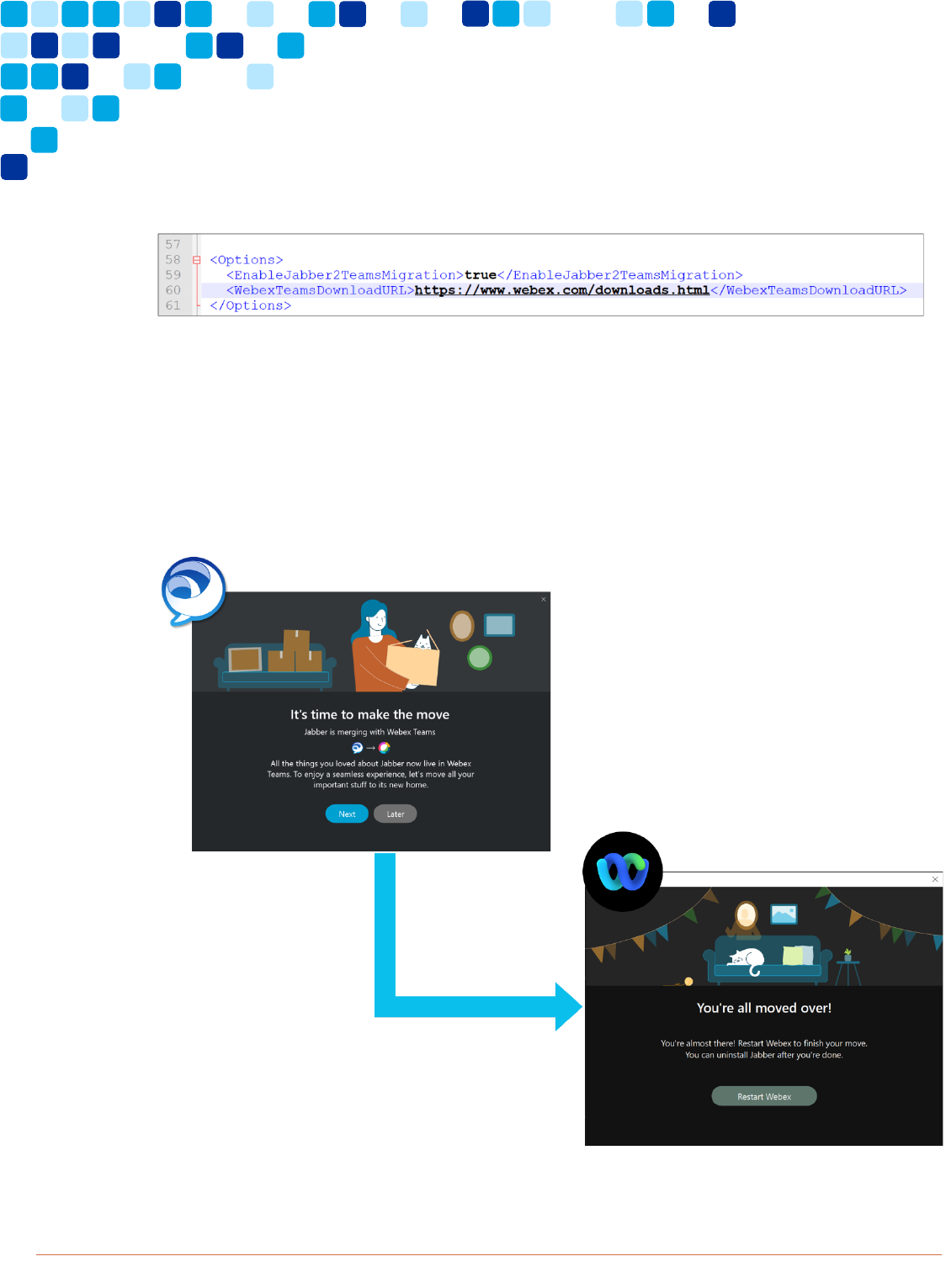
© 202
1 Cisco – CTG TME Collaboration Transitions – Clients: Transitioning from Jabber to Webex PAGE 73
Transition
WebexTeamsDownloadURL parameter can also be set which will take users to the
Webex App download page if it is not already installed on the device.
Figure 31. Jabber-config to Enable Jabber to Webex Contacts & Preferences Migration Tool
When Jabber downloads the updated configuration file, the migration wizard will be
presented to the user between 5 minutes and 3 hours later. The migration wizard
can be manually started from the Jabber help menu.
Figure 34 shows portions of the Jabber to Webex migration wizard for contacts and
preferences migration
Figure 32. Jabber to Webex App Contacts and Preferences Migration

© 202
1 Cisco – CTG TME Collaboration Transitions – Clients: Transitioning from Jabber to Webex PAGE 74
Transition
6. Enable Outlook integration.
Both Jabber and the Webex App provide integrations to Outlook contact cards to
view a user’s presence and click to message/call. This integration is available for
Windows and Mac.
This integration uses the proxyAddress attribute in AD. The proxyAddress attribute
should be mapped to the Webex userID (email address). The address should be
prefixed with sip://. For example:
Alice’s Webex ID is [email protected]. The proxyAddress for Alice should be
set to SIP:ali[email protected].
The proxyAddress should already be set if Jabber was previously integrated with
Outlook. Ensure that the user address is correct for Webex deployment.
On Windows this integration is enabled via a registry setting. Only one application
can integrate with Outlook at a time. Webex will not overwrite the existing Jabber
Outlook integration at install time.
The administrator can enable the Outlook integration for Webex when the user is
ready to have it disabled from Jabber by using the regsvr32 utility available in
Windows. Making this change will involve updating the registry. This will require
administrative permissions on the device. This activity can be performed centrally by
an administrator using a third-party tool such as Microsoft GPO.
For more details on the Outlook integration for Webex App, refer to the Enable
Webex Users' Status to Display in Microsoft Outlook article available at
https://help.webex.com/en-us/gk4yog/Enable-Webex-Users-Status-to-Display-
in-Microsoft-Outlook.
Post Transition Steps and Considerations
After the transition is complete, there are additional optional steps you may wish to
consider to clean-up the environment:
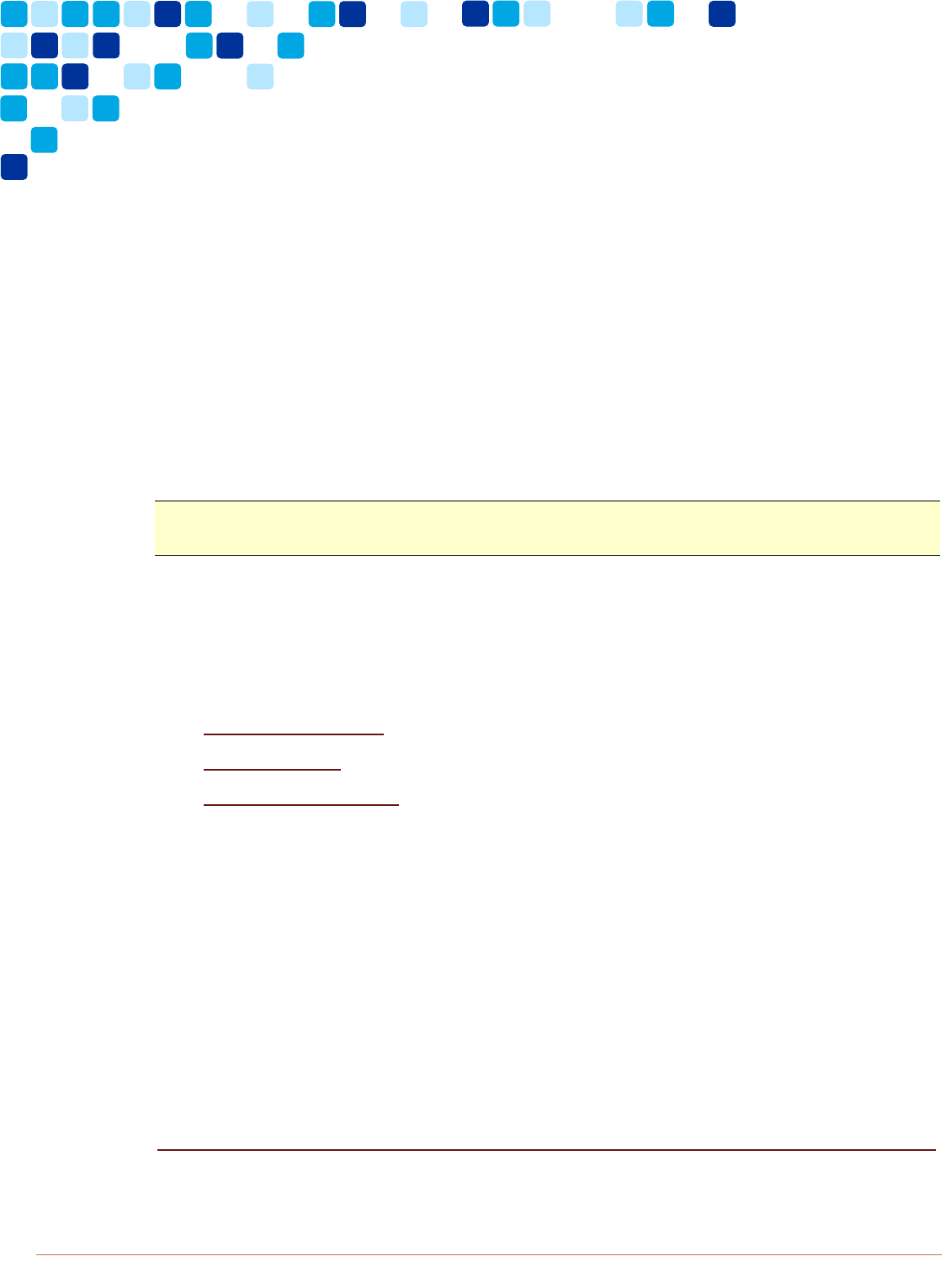
© 202
1 Cisco – CTG TME Collaboration Transitions – Clients: Transitioning from Jabber to Webex PAGE 75
Transition
1. Remove Jabber client applications from user devices.
Jabber can be uninstalled from devices manually or via third-party deployment
tools.
In the case of Jabber for Windows, Jabber can be installed using the command line
switch: msiexec.exe /x PATH_TO_CiscoJabberSetup.msi /quiet
Locally cached Jabber files can be removed from the user profiles. For example, in
the case of Windows, the following directories would be deleted:
%current_user%/AppData/Local/Cisco/Unified Communications/*
%current_user%/AppData/Roaming/Cisco/Unified Communications/*
Note: Any sensitive data stored in cache such as contact lists, call history is
encrypted and can only be accessed with Jabber.
2. Archive Unified CM IM&P content.
Before decommissioning Unified CM IM&P servers as well as third-party databases
and file servers, consider archiving Unified CM IM&P content. The content that
should be archived includes:
Jabber contact lists
Persistent chat
Managed file transfer
Jabber contact lists
Jabber contact lists are stored on Unified CM IM&P. Even though Jabber contact
lists can be migrated to Webex using the migration utility discussed previously, it’s
good practice to export contact lists from the Unified CM IM&P cluster and store for
some time after decommissioning the servers. This will ensure that users who might
be on extended leave or that miss a migration window will be able to access their
contact lists, even after Unified CM IM&P has been decommissioned. Contact lists
can be exported using the BAT. For more information on exporting user contact lists
with BAT refer to the “Bulk Administration of Contact Lists” chapter of the
Configuration and Administration of the IM and Presence Service, Release 12.5(1)
available at
https://www.cisco.com/c/en/us/td/docs/voice_ip_comm/cucm/im_presence/config

© 202
1 Cisco – CTG TME Collaboration Transitions – Clients: Transitioning from Jabber to Webex PAGE 76
Transition
AdminGuide/12_5_1/cup0_b_config-and-admin-guide-1251/cup0_b_config-and-
admin-guide-1251_chapter_011110.html.
Persistent chat
Persistent chat rooms and managed file transfer are optional services for Unified CM
IM&P deployments. If either or both are enabled, an organization may want to
archive the content before decommissioning.
Persistent chat room content is stored on a third-party database managed by the
organization. This content can be retrieved from the database and archived using
database tools. Consider archiving this content before decommissioning the
databased or database server. For more information on the table structure of the
database for backing up persistent chat room content refer to the “Database
Tables” chapter of the Database Setup Guide for the IM and Presence Service,
Release 12.5(1)SU2 available at
https://www.cisco.com/c/en/us/td/docs/voice_ip_comm/cucm/im_presence/datab
ase_setup/12_5_1/cup0_b_database-setup-guide-
1251su2/cup0_mp_edff2920_00_external-database-tables.html.
Managed file transfer
Managed file transfer content is stored on a customer-provided third-party file
server managed by the organization. The content is stored on a fileserver in plain
text by default. Encrypting fileserver stored content is recommended. Consider
archiving managed file transfer content before deleting file transfer content or
decommissioning the file server.
3. Decomission Unified CM IM&P server nodes.
When the Unified CM IM&P content is archived and assuming SIP federation is not
required, the Unified CM IM & Presence server nodes can be decommissioned.
Users should be un-associated from Unified CM IM&P within Unified CM. Then,
Unified CM IM&P nodes should be removed from the Unified CM cluster.
For more information on decommissioning Unified CM IM&P server nodes, refer to
the “Manage the Server” chapter of the Configuration and Administration of the IM
and Presence Service, Release 12.5(1)SU2 available at
https://www.cisco.com/c/en/us/td/docs/voice_ip_comm/cucm/im_presence/config
AdminGuide/12_5_1_su2/cup0_b_config-and-admin-guide-
1251su2/cup0_b_config-and-admin-guide-1251su2_chapter_011100.html.

© 202
1 Cisco – CTG TME Collaboration Transitions – Clients: Transitioning from Jabber to Webex PAGE 77
References
References
Calling in Webex Unified CM
Webex Installation and Automatic Upgrade
https://help.webex.com/en-us/nw5p67g/Webex-Installation-and-Automatic-
Upgrade
Deployment Guide for Calling in Webex Unified CM
https://www.cisco.com/c/en/us/td/docs/voice_ip_comm/cloudCollaboration/w
bxt/ucmcalling/unified-cm-wbx-teams-deployment-guide.html
Collaboration Transitions
Collaboration Transitions Program Page
https://www.cisco.com/go/ct
Transition Map for Transitioning from Jabber to Webex
https://www.cisco.com/c/dam/en/us/td/docs/solutions/PA/mcp/TDM_CLIENT
S_Jabber_to_Webex.pdf
Compliance and Policy
Control Hub (Compliance) Datasheet
https://www.cisco.com/c/en/us/products/collateral/conferencing/webex-
control-hub/datasheet-c78-740772.html
Data Residency in Webex
https://help.webex.com/en-us/oybc4fb/Data-Residency-in-Webex
Set the Retention Policy for Your Organization
https://help.webex.com/en-us/nqmr56k/Set-the-Retention-Policy-for-Your-
Organization
Block External Users in Webex Spaces for Your Organization
https://help.webex.com/en-us/agrt8/Block-External-Users-in-Webex-
Spaces-for-Your-Organization

© 202
1 Cisco – CTG TME Collaboration Transitions – Clients: Transitioning from Jabber to Webex PAGE 78
References
Directory and Identity
Ways to Add Users to your Control Hub Organization
https://help.webex.com/en-us/nj34yk2/Ways-to-Add-Users-to-your-Control-
Hub-Organization
Add, Verify and Claim Domains
https://help.webex.com/en-us/nxz79m5/Add-Verify-and-Claim-Domains
Single Sign-On Integration in Control Hub
https://help.webex.com/en-us/lfu88u/Single-Sign-On-Integration-in-Control-
Hub
Deployment Guide for Cisco Directory Connector
https://www.cisco.com/c/en/us/td/docs/voice_ip_comm/cloudCollaboration/s
park/hybridservices/directoryconnector/cmgt_b_directory-connector-guide-
admins.html
Hybrid Services
Deployment Guide for Cisco Webex Hybrid Calendar Service
https://www.cisco.com/c/en/us/td/docs/voice_ip_comm/cloudCollaboration/s
park/hybridservices/calendarservice/cmgt_b_deploy-spark-hybrid-calendar-
service.html
Deployment Guide for Cisco Webex Hybrid Data Security
https://www.cisco.com/c/en/us/td/docs/voice_ip_comm/cloudCollaboration/s
park/hybridservices/datasecurity/cmgt_b_hybrid-data-security.html
Deployment Guide for Cisco Webex Hybrid Messaging Service
https://www.cisco.com/c/en/us/td/docs/voice_ip_comm/cloudCollaboration/s
park/hybridservices/messageservice/cmgt_b_spark-hybrid-message-
deployment-guide.html
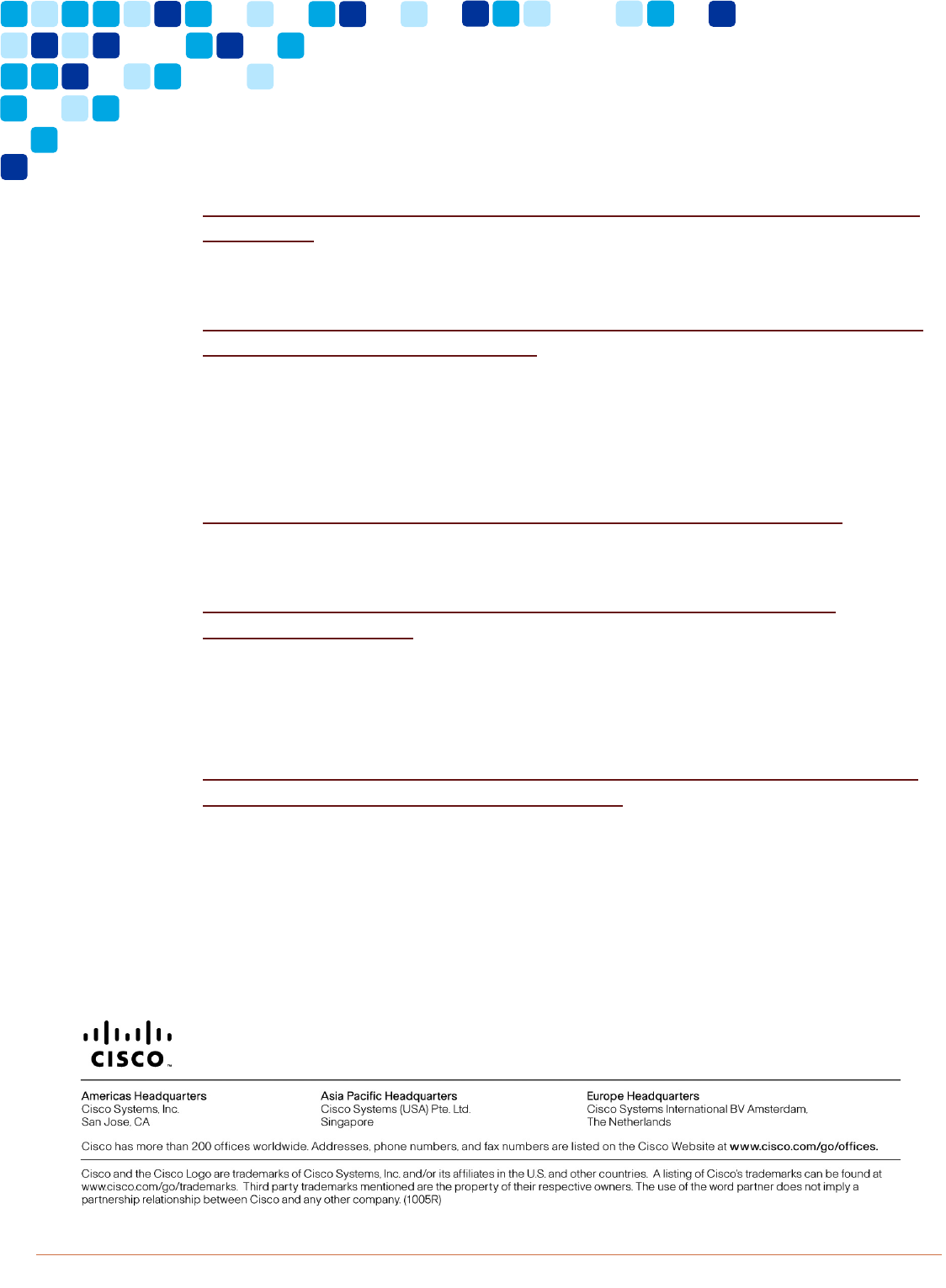
© 202
1 Cisco – CTG TME Collaboration Transitions – Clients: Transitioning from Jabber to Webex PAGE 79
References
Meetings
Upgrade Webex Meetings App to Webex App
https://help.webex.com/en-us/nda7hb0/Upgrade-Webex-Meetings-app-to-
Webex-app
Add Links for Meetings or Spaces with webexteams Protocol
https://help.webex.com/en-us/n5yzg8y/Webex-Add-Links-for-Meetings-or-
Spaces-with-webexteams-Protocol
Messaging
Federation for Webex
https://help.webex.com/en-us/05i99o/XMPP-Federation-for-Webex
SIP or XMPP Interdomain Federation for Webex
https://help.webex.com/en-us/n8gtpu7/SIP-or-XMPP-Interdomain-
Federation-for-Webex
Network
Network Requirements for Webex, Webex Meetings, and Cisco Jabber
https://help.webex.com/en-us/WBX000029031/Network-Requirements-for-
Webex-Webex-Meetings-and-Cisco-Jabber
